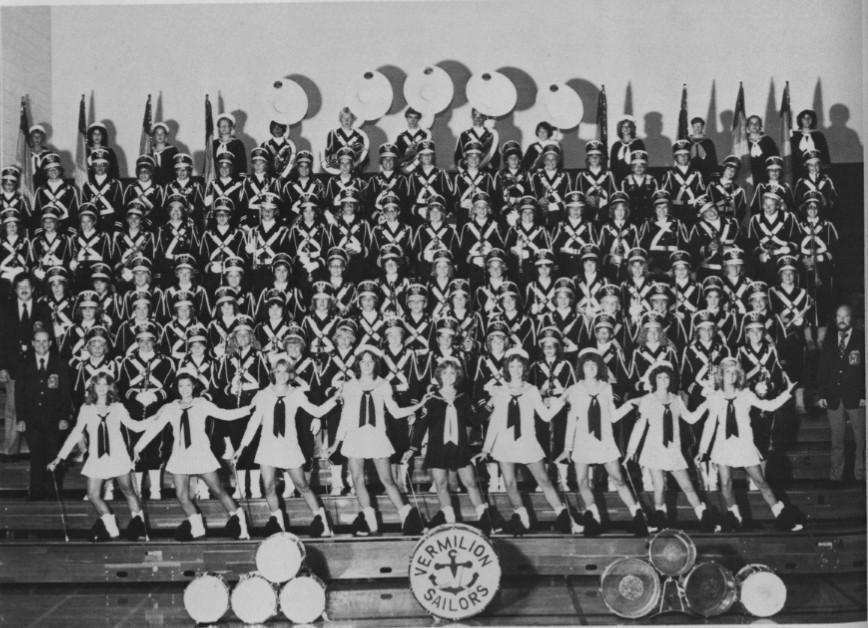Now Hear This! Presenting the Vermilion Sailor Marching Band!

Researching the history of Vermilion can be challenging at times. Often, the focus for the town is on well-known landmarks and core aspects of the town’s identity, such as the color of river mud, water wheels, amusement parks, lighthouses, and past vacation resorts. These elements define common discussions on Vermilion’s history. Certain subjects, like McGarvey’s, inspire more ongoing conversation than the origin of the Alma Mater.
Small towns celebrate achievements and display metaphorical trophies as a source of pride. There is always a risk of overlooking the smaller stories that have evolved into traditions. These traditions become so ingrained in the community that the source of their origins is blurry or lost. The challenge lies in researching and documenting these traditions before they become too convoluted through word of mouth. This history attempts to untangle conflicting stories and shed light on the roots of traditions, connecting one end to the other as cleanly as possible regarding the Vermilion Sailor Marching Band and instrumental musical education in Vermilion.
Vermilion’s Musical Roots

Vermilion has enjoyed a rich musical heritage spanning over 150 years. The musical culture that thrived among residents was influenced by the opening of Cedar Point in 1870. This iconic resort and later amusement park undeniably played a pivotal role in transforming the region into a sought-after destination for the escapism of vacations. As tourists began flocking to the area, venues were created to cater to their entertainment needs. Cottages, resorts, and entertainment hubs emerged in the region, eventually earning it the moniker “Vacationland,” a title officially recognized since the 1962 Miss Ohio Beauty Pageant.
In 1906, the town managed to have its own amusement park, Crystal Beach. While not as expansive or well-visited as Cedar Point, this park managed to operate successfully and attract visitors for 56 years. On May 29, 1925, a new gem within the park, Crystal Gardens, was unveiled. The initial admission fee to this ballroom was ten cents. For their dime, patrons were granted access to performances by some of the era’s most renowned artists. Legendary musicians such as Tommy Dorsey, Count Basie, Guy Lombardo, Gene Krupa, Louis Armstrong, Duke Ellington, Cab Calloway, Woody Herman, The Everly Brothers, The Kingston Trio, and Lawrence Welk all left their mark on Crystal Garden’s stage.
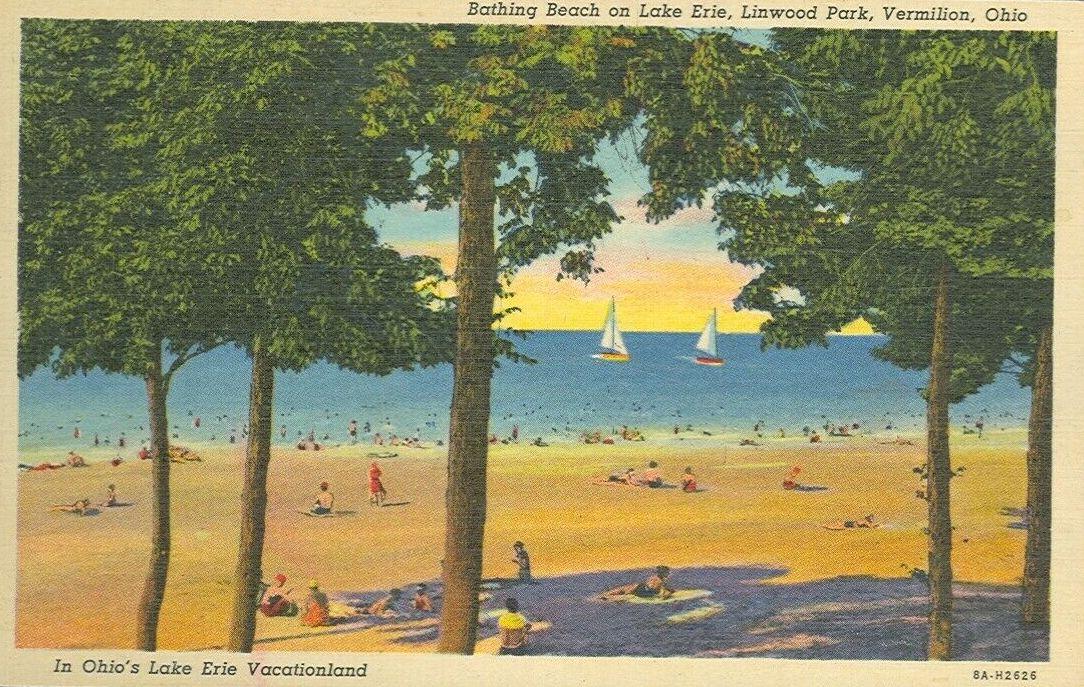
Even older than Crystal Beach, the area now occupied by Linwood Park, a quiet private park and Christian retreat community, has a surprising past. Before its acquisition by the Evangelical Association on March 31, 1884, this location bore the names Linwood Grove and Wagner’s Woods. The park hosted a beer and dance hall. However, following its purchase, the Evangelical Association transformed the former dance hall into a dining room. This transformation heralded the shift from an entertainment park to a religious retreat.
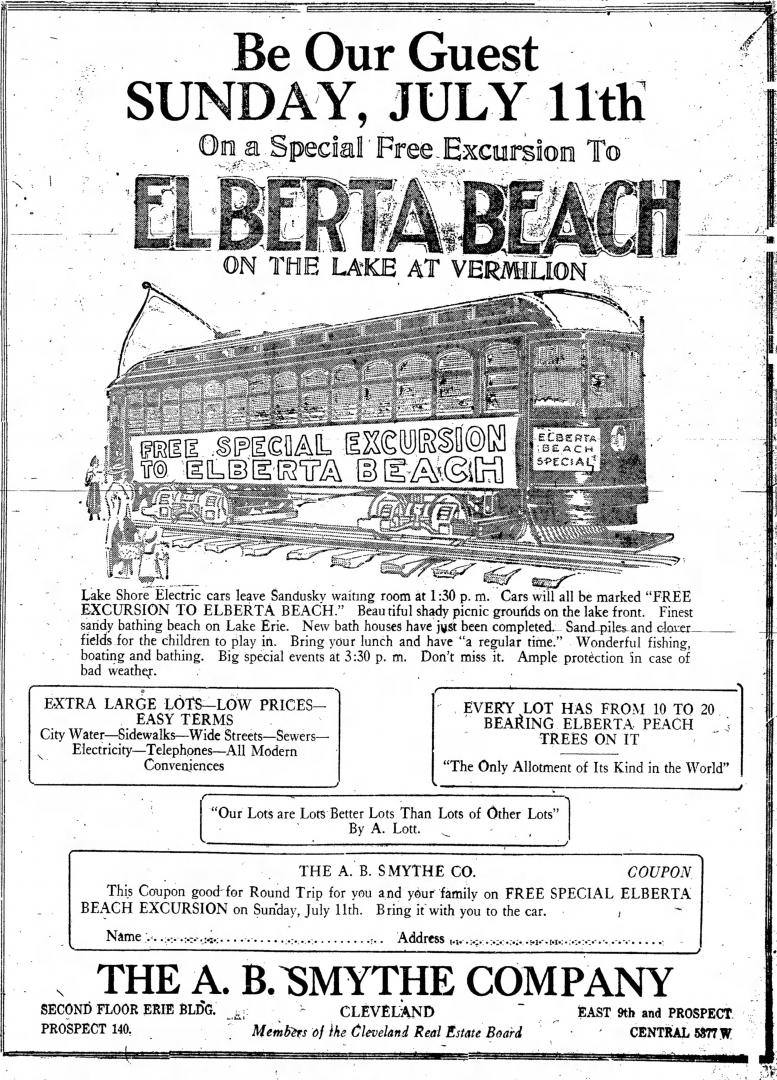
As is often the case, success breeds competition. The Elberta Inn opened its doors in 1912 on a peach orchard to serve food for the area. In 1919 the Vermilion-On-The-Lake resort was being built and developers started seeing the area as a vacation destination. In 1920 portions of the orchard around The Elberta Inn were removed by the A. B. Smythe Company as it transformed Elberta Beach into a resort and residential area. As it grew it would become a destination for dancing along to the swing bands that performed there. The most famous artist to perform there was Duke Ellington. With its popularity, Elberta Beach even attempted briefly to be recognized as a town. By the 1950s the popularity of Elberta Beach began to wane.
Green Book Cleveland has an excellent write-up on Elberta Beach.
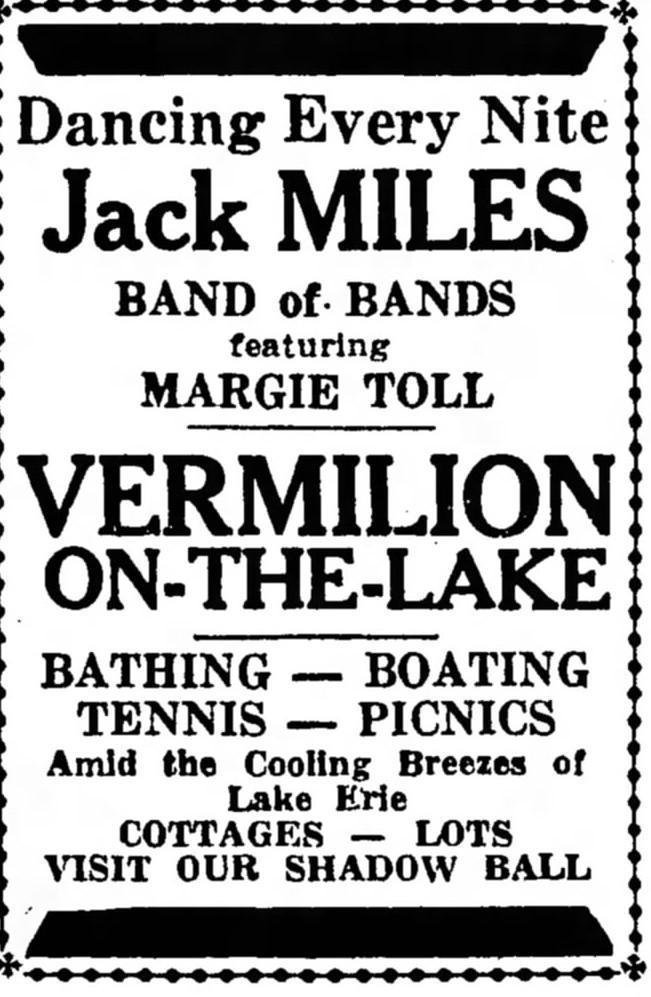
In 1919, the Vermilion-on-the-Lake resort was established to sell cottages to vacationers. One of the resort’s highlights was the Vermilion-on-the-Lake Clubhouse, which eventually began offering daily entertainment throughout the summer months. Dance orchestras, like those headlined by Bob Veon and Jimmy Carroll, held long-term engagements here for years. Even rock and roll legend Chuck Berry graced the Vermilion-on-the-Lake Clubhouse with a performance. Unlike Elberta Beach, Vermilion-on-the-Lake did manage to exist as a town. Vermilion-on-the-Lake and Elberta Beach were annexed into the City of Vermilion on December 21, 1959.
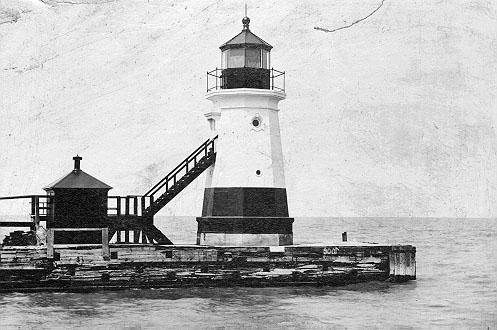
One thing that needs to be addressed as we delve into the history of the Vermilion Band program. Before any of the musical groups discussed in this history, there was another Vermilion Band. This generic term goes back to the late 1800s and was used by newspapers for any community or civic band. By 1910, this could refer to the GAR Band and other civic musical groups. Advertised performances are more likely to refer to a band of adult members than students in the Vermilion school system.
This does not preclude that students were not involved in these singular or multiple groups reported as The Vermilion Band. Currently, there is not a clean line connecting these civics groups. These connections become clearer upon Eugene Ackley’s involvement with music in Vermilion, not including possible contributions from these groups that went under the banner The Vermilion Band is not an oversight.

Early 1900s Vermilion was filled with entertainment and music that would inspire the community, musical directors, and Vermilion Sailor Marching Band members from its inception through the present day. If this history focused solely on school hours, football games, and parades it would tell only a fraction of the story. An understanding of the Vermilion Sailor Marching Band’s formation requires a closer look at high school instrumental ensembles, influential music directors, and Vermilion itself. This history focuses on the instrumental music in Vermilion. Additional choral or general music teachers are not covered in-depth but are integral to Vermilion’s musical heritage.
Pregame
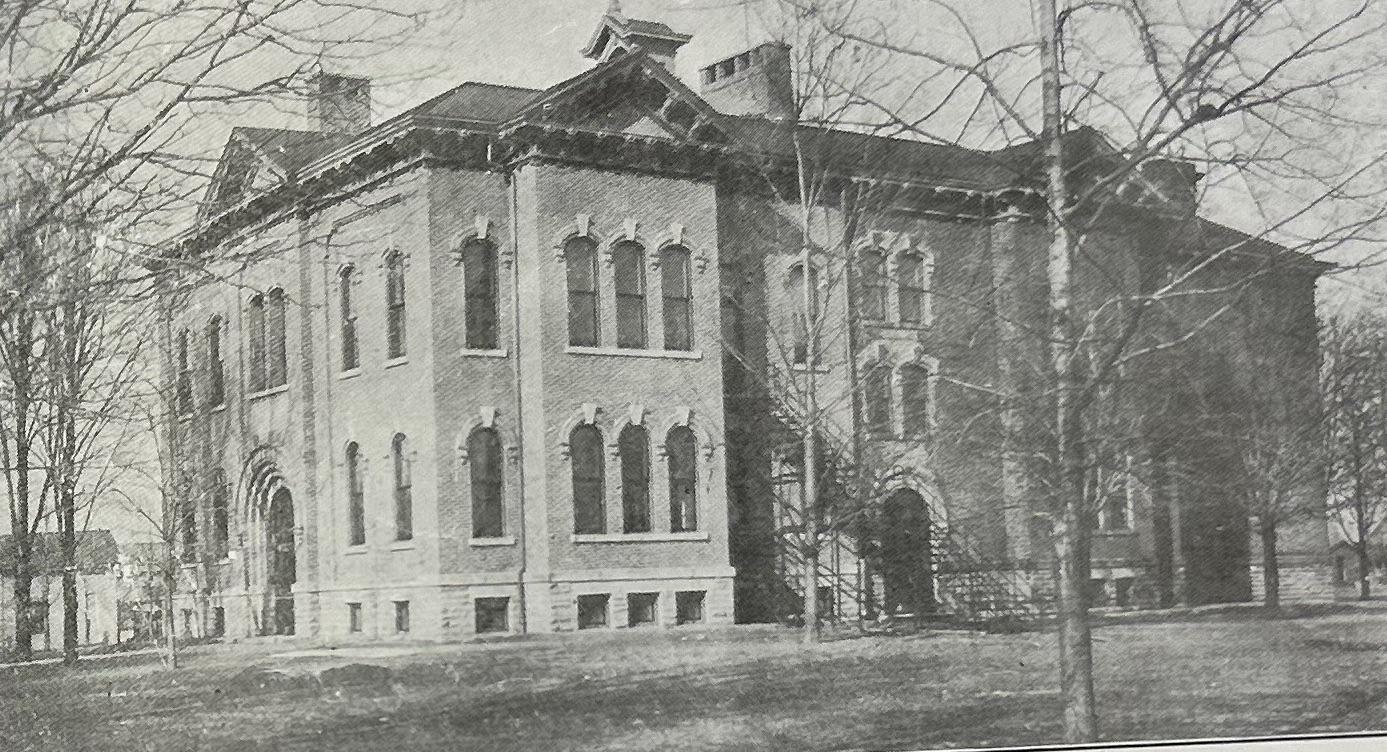
Vermilion’s educational landscape experienced a significant shift during the 1800s. Multiple informal schools catering to the residents were in operation. A change occurred in 1851 when the Vermilion Board of Education became formalized. The Board worked together and defined the structured instructional requirements for the community. This educational progress reached a milestone in 1874 with the construction of the first four-room high school on State Street. The 1991 Vermilion High School yearbook lists that the first graduating class that went through senior year was 1891. Their graduation included four members in a ceremony held in the Vermilion Opera House.
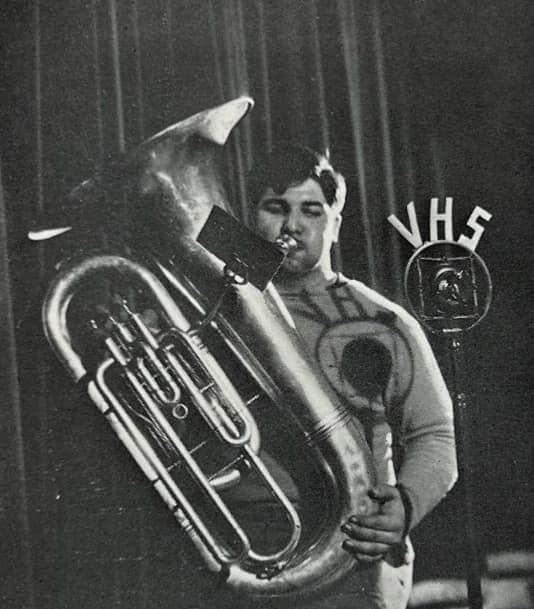
The State Street School underwent expansion in 1909 to accommodate students of all grade levels. After this expansion, four smaller area schoolhouses saw their students transferred to the State Street School. The year “1909” was inscribed above the front door, leading to confusion in later years about the actual construction date of the building. The 1909 school board made another lasting mark by selecting purple and gold as the official school colors.
More information on the history of Vermilion Schools is covered by The History of Public Education in Vermilion.

At State Street School, the first high school musical ensembles emerged, guided by the leadership of Eugene Ackley. He arrived in the Erie County region as a performer at Cedar Point in 1893. Mr. Ackley eventually became the Director of Music for Cedar Point, where he remained for nearly a decade. During his tenure, he left a lasting impression on the local resort by composing “The Cedar Point March” in 1902, a composition dedicated to and inspired by the resort’s beauty.
By 1910, Eugene Ackley turned his attention to the students of Vermilion, dedicating time to cultivate an orchestral program. As the director of the Vermilion High School Orchestra, Mr. Ackley shaped the musical performance abilities of his students and left a mark on Vermilion’s musical legacy. After a few years, the school orchestra was disbanded but would return under a new director in 1925.
Instead of directing a high school marching band, Mr. Ackley was director of the Grand Army of the Republic (GAR) Band. The GAR was a national veterans’ organization established in 1866 for the benefit of Union veterans of the Civil War. The GAR dissolved in 1956 upon the passing of the last Union Military member, Albert Woolson. Vermilion’s GAR Band included more than just former Union soldiers; otherwise, its members would have all been in their sixties in the 1911 picture below. The band performed at various GAR events, including the celebration of Decoration Day, an event the GAR helped establish as the national holiday Memorial Day.
In 1911, Mr. Ackley directed the GAR Marching band, and this might have marked the first time a Vermilion School’s band director led a marching band in the annual Vermilion Decoration Day parade. Although Vermilion High School did not have a marching band yet, it was a beginning.
On Wednesday, August 30, 1911, the twenty-ninth annual reunion and tournament of the Buckeye Band Association was held in Vermilion. Eighteen bands arrived and paraded through the streets of Vermilion as over a thousand visitors witnessed the event. At the end of the parade, the band was assembled into mass band to perform a concert in town. While the mass performance of the Star Spangled Banner would later become a staple of the Vermilion Sailor Marching Band Festival, Mr. Ackley would be the first recorded instance of a Vermilion director leading a group of mass bands.
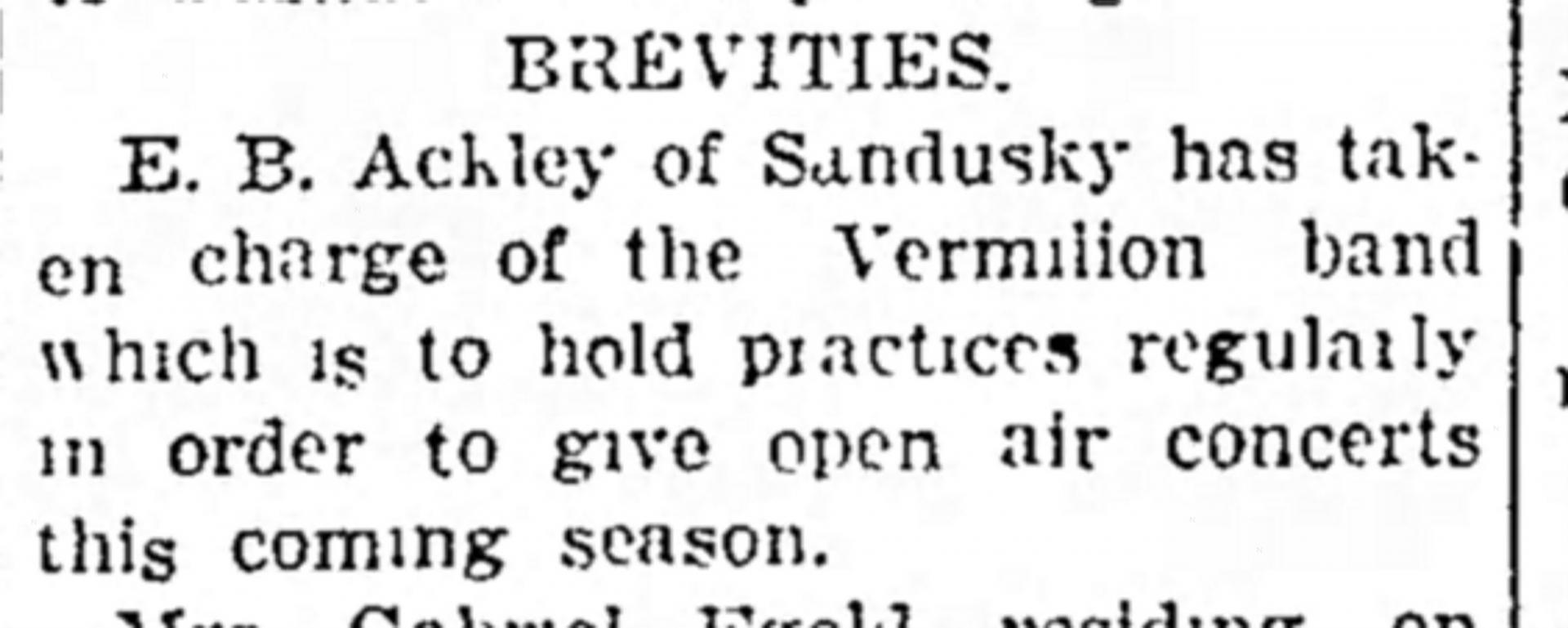
Mr. Ackley took charge of the Vermilion Band in February 1921. The goal was to create an organization the town could be proud of and represent the town. This was a band with performers of all ages, and along with many of the others listed was another one of countless musical ensembles led by Mr. Ackley.
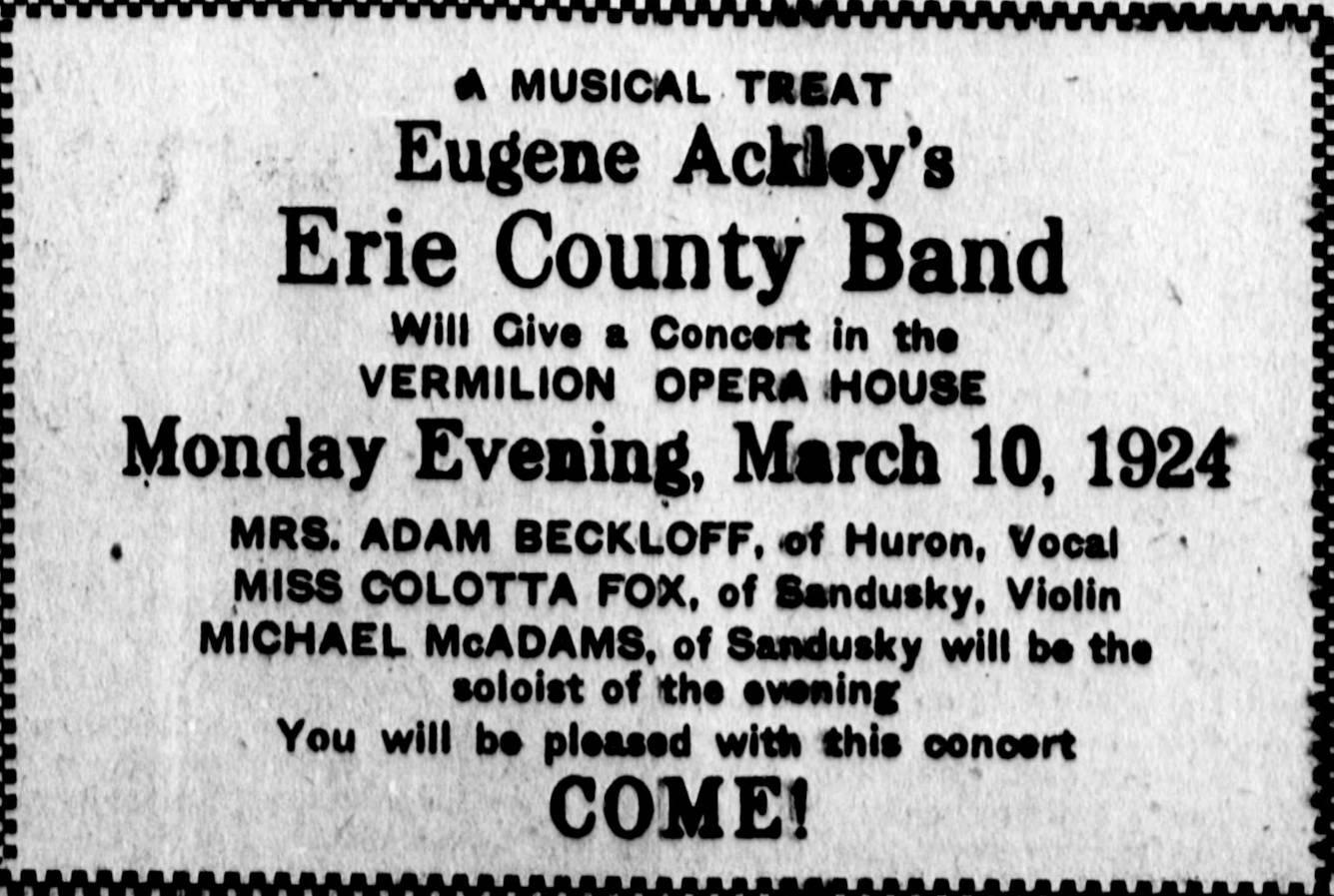
Mr. Ackley’s influence can also be seen in the establishment of The Erie County Band and Orchestra, possibly around the same time. By 1924, he had taken on the role of directing this ensemble. The unique aspect of The Erie County Band was that it brought together students from all schools in Erie County, except for Sandusky, which had its separate band during that period, also directed by Ackley for a while. Although The Erie County Band delighted audiences with numerous concert-style performances, there is little evidence to suggest that marching was a part of their repertoire during this particular phase of the band’s existence.
Over the years, many Vermilion students participated in the Erie County Band. When The Vermilion Sailor Alumni Band was formed, eligibility was extended to anyone who had performed with this group. In 1925, yearbooks recorded activities that Seniors participated in for the first time. The Erie County Band is recorded with equal credit as High School Orchestra. Lloyd Niggle (class of 1925) is the first Vermilion student credited in the yearbook to perform in the Erie County Orchestra.
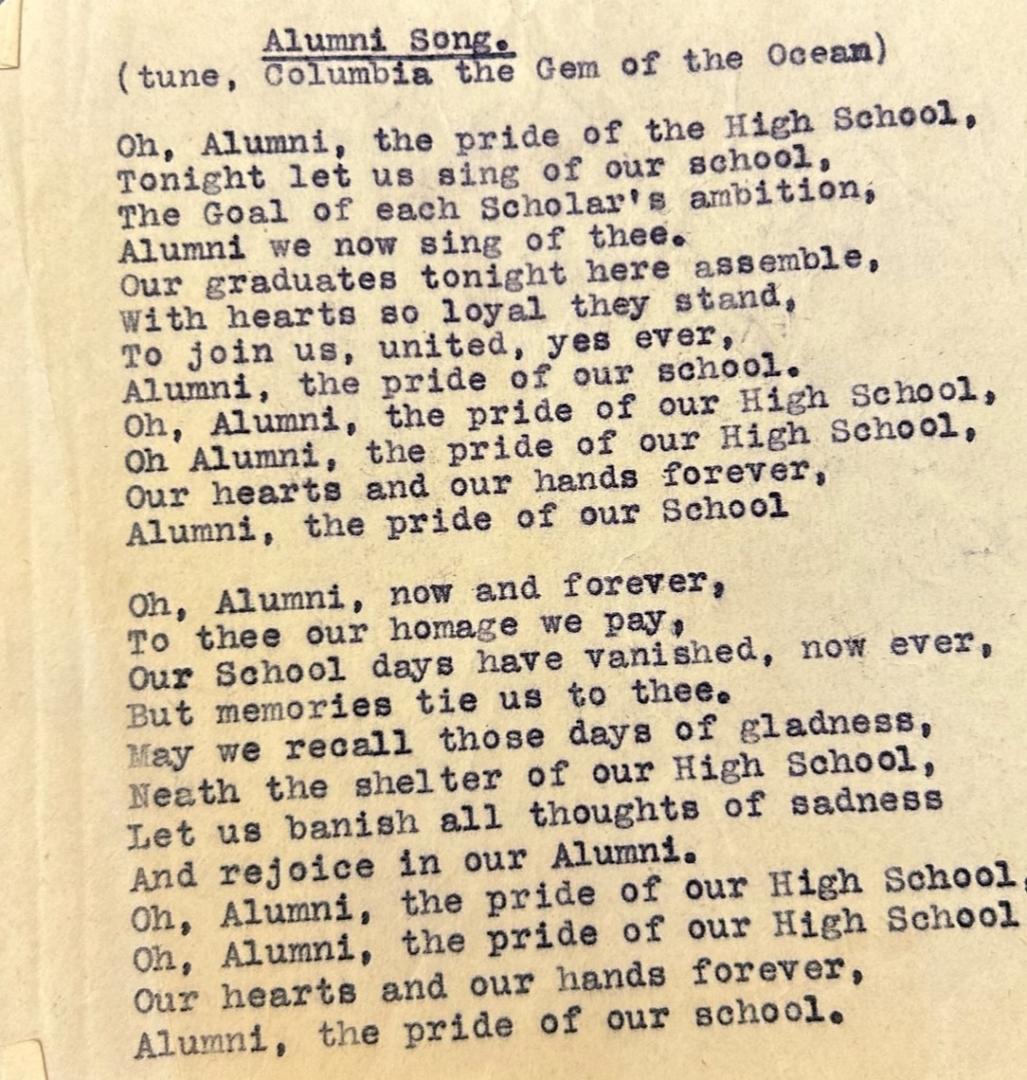
In an edition of the 1926 Vermilion High School yearbook, a loose paper with the Alumni Song was discovered. Given its placement within the book, it can be inferred that, at some juncture, this song was used for the alumni students. Notably, the song does not explicitly mention Vermilion, raising uncertainty about its specific connection to the town. It is worth mentioning that the song is set to the melody of “Columbia, The Gem Of The Ocean.“
Alumni Song
Oh, Alumni, the pride of the High School,
Tonight let us sing of our school,
the Goal of each Scholar’s ambition,
Alumni we now sing of thee.
Out graduates tonight here assemble<
With hearts so loyal they stand,
To join us, united, yes ever,
Alumni, the pride of our school
Oh, Alumni, the pride of the High School,
Oh, Alumni, the pride of the High School,
Alumni, the pride of the High School.
Oh, Alumni, now and forever,
To thee our homage we pay,
Our School days have vanished, now ever,
But memories tie us to thee,
May we recall those days of gladness,
Neath the shelter of our High School,
Let us banish all thoughts of sadness
and rejoice in our Alumni,
Oh, Alumni, the pride of the High School,
Oh, Alumni, the pride of the High School,
Our hearts and hands forever,
Alumni, the pride of our school.
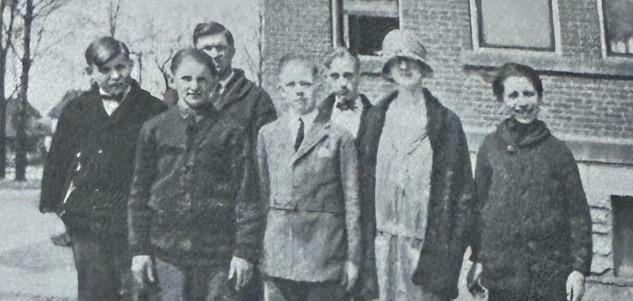
The 1925 and 1927 school years had a different instructor for the Vermilion Orchestra, Mrs. Flossie May Andrews Lees. Not much is known about Mrs. Lees at this time. Mrs. Lees is first mentioned as restarting the Vermilion Glee Club in 1924. There is an article in the March 1930 edition of the Erie Echo Newsletter that discusses an article for a music festival to be held at Vermilion High School on Friday afternoon May 9, 1930. This article lists a county-wide choral group led under the direction of Mrs. Mae A. Lees and Miss Margaret Williams. Mrs. Lee is in the far right of the above picture.
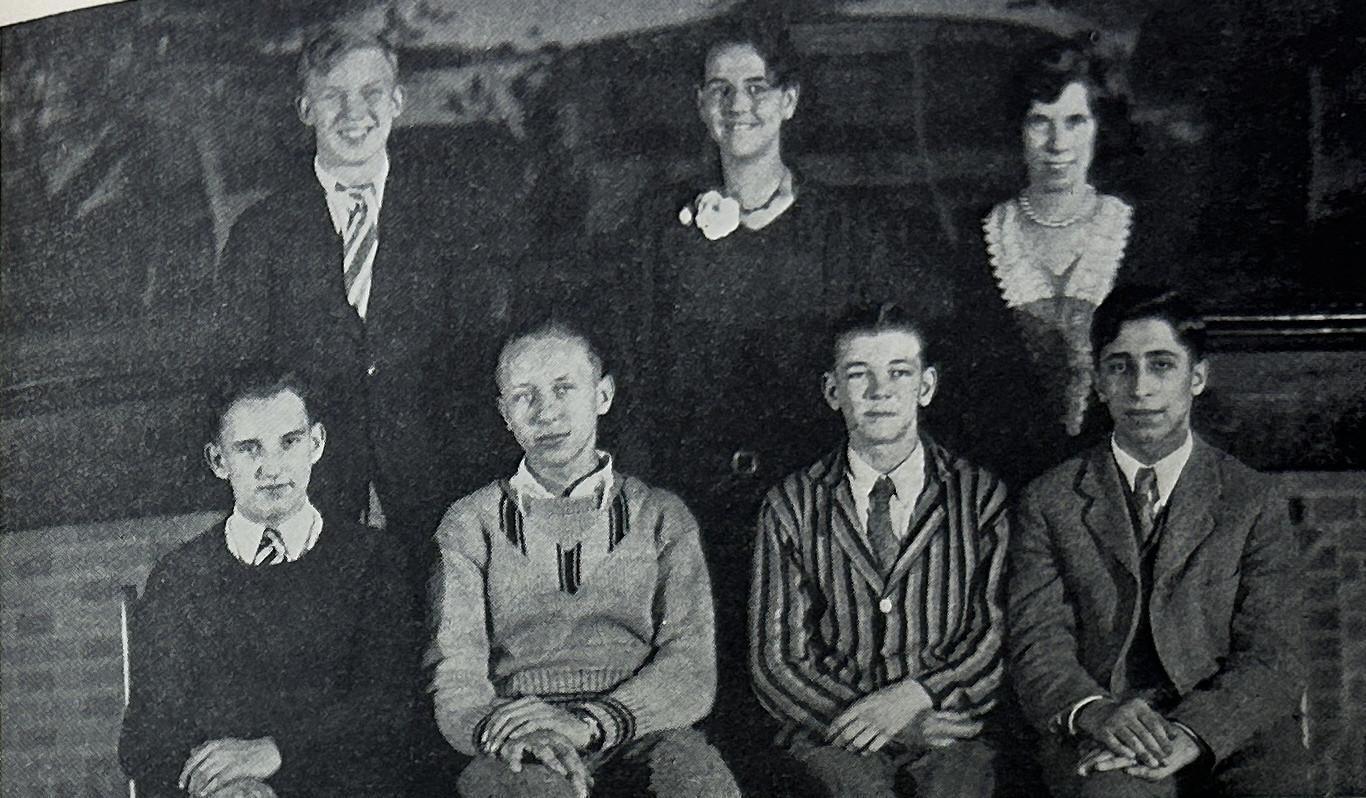
The 1928 and 1929 school years had a new director educating Vermilion’s Orchestral students, M. E. Hutton. Unofficially the ensemble was called Miss Hutton’s Orchestra. Miss Hutton led her students in practice every Wednesday morning. Miss Hutton is in the far right back row in the picture above.
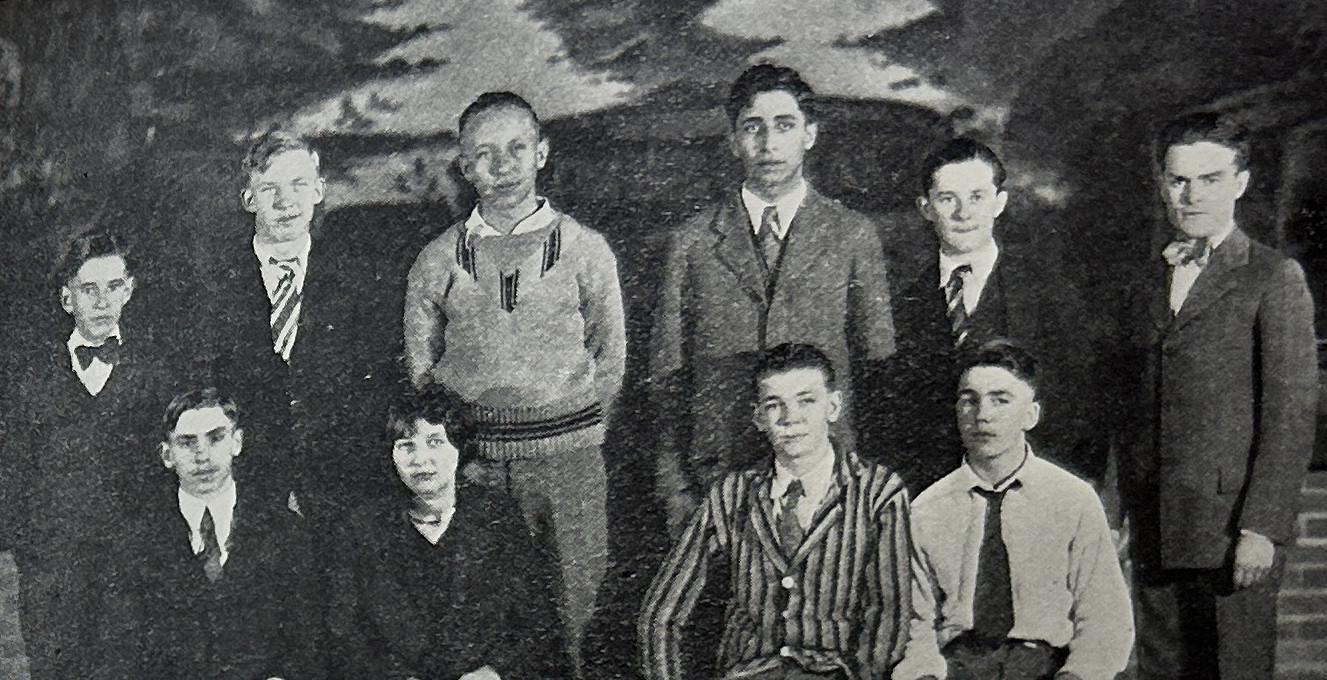
In addition to the Vermilion Orchestra led by M. Hutton during the 1929 school year, the school also had a classical orchestra program. Clark Carmean, on the far right, was the director who presided over this group of fine musicians.
Marching Into The Stadium
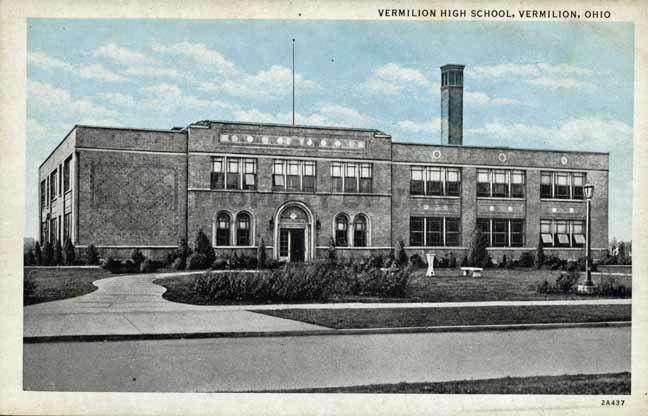
The VHS class of 1928 transitioned from State Street School to the newly constructed South Street School. With its doors open to upper-grade students, South Street School accommodated approximately 250 pupils and came equipped with modern amenities, including a combined auditorium/gymnasium, home economics department, cafeteria, school shop, and science laboratory. The school district introduced bussing to transport students from various parts of the township to their school. For the first time, the school grounds featured a football field.
Subsequent additions and investments in Vermilion education were primarily directed toward the future development of South Street School. By 1939, all local students were attending an expanded South Street School, leading to the official retirement of the State Street School as an educational facility. This consolidation provided a centralized and enhanced educational facility for the entire community.

Another valuable addition to the school system came in the form of James Hoffman, who assumed the role of Director of Music in Vermilion for the 1929 school year. Despite dividing his time between several schools, Mr. Hoffman laid the foundation for the Vermilion Sailor Marching Band legacy. Although he was only available two days a week, he dedicated himself wholeheartedly, and former students would speak fondly of his impact.
James Hoffman was overseeing musical education of the Vermilion, Berlin Heights, Huron, and Milan areas. Eventually, his role expanded to encompass all schools in Erie County, with Sandusky being the sole exception. Under Mr. Hoffman’s leadership, the band ventured beyond Vermilion and made its presence felt across Erie County, captivating audiences with their performances and marches at various events. From parades and fairs to festivals, they left an enduring mark on the area’s musical landscape. For their parade performances in 1935, The Erie County Band would march in parades wearing white pants and shirts, blue capes with red turn-back lines, and hats of red and blue. The Erie County band thrived under Mr. Hoffman’s direction and flourished for decades after he was no longer with that organization.

The existence of the Erie County Band creates a certain level of ambiguity in how credit for participation was attributed to Vermilion music students. Determining the inception of the marching band becomes somewhat uncertain, as it hinges on what is defined as a band associated with the high school and how that affiliation is recorded in the yearbook. It is documented that all Vermilion Orchestra students during the 1930 school year were part of the Erie County Band. The 1931 yearbook credits John Nuhn as the first member to accumulate four years of band participation in the senior activities list. This notation should be taken as the starting point of the Vermilion High School band program, giving the 1928 school year as the formation year. Similarly, that same year, Nelson Parsons was linked with the county band but does not have regular band participation listed in his activities. Moreover, students are noted for their involvement in the orchestra or county orchestra.

It wasn’t until the 1935 yearbook that the band became recognized as a distinct organization. In the autumn of 1934, the band began performing at most home football games and carried on this tradition by playing at all home basketball games hosted by Vermilion High School.

While not directly related to the band program, but of significance in school history, the first May Day Celebration occurred in 1936. This event is similar to the homecoming court held in the fall. May Day is celebrated on May 1st and originated from European traditions to welcome the first day of spring. In Vermilion, a Queen and court are crowned during this celebration, and the entire school joins in the festivities. The high school concert band played a vital role in the ceremony, and for several decades, from the 1960s to the 1990s, the traditional song performed when the court entered the ceremony was “Parade of the Charioteers.” This time-honored tradition continues as an integral part of Vermilion’s school history.

A notable aspect regarding the Vermilion High School Band during the 1940 school year is the inclusion of black and red capes in their uniforms. This inclusion may have been a unique occurrence, as capes were potentially used only as part of the marching band uniform for that specific year.
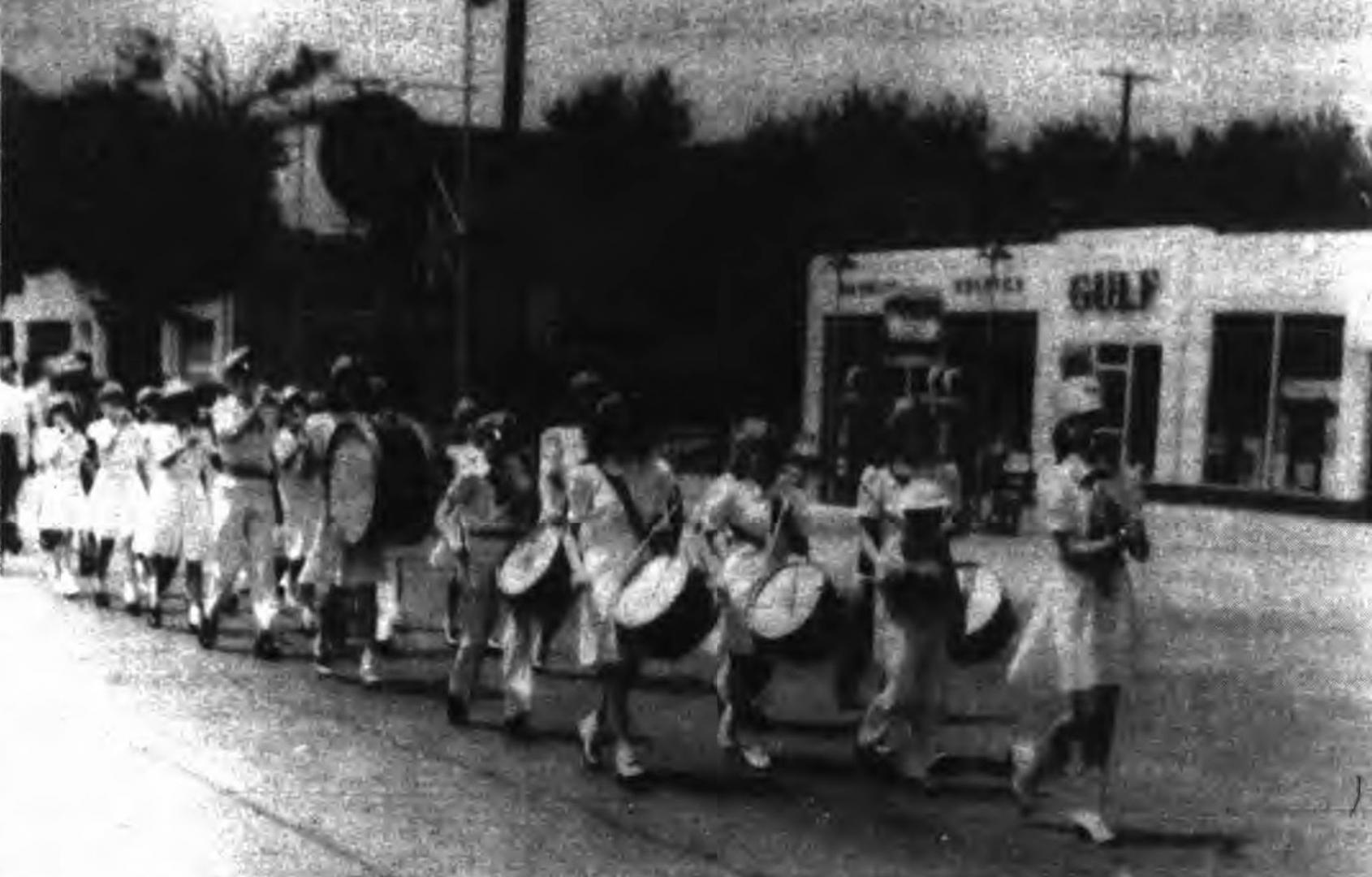
On May 30, 1942, The Vermilion High School Marching Band performed in the Memorial Day parade. What is unique is that is the oldest known photographic evidence of the high school performing. in the parade.
The origin of the Vermilion Fight Song/Anchor’s Aweigh, including its year of composition and composer, remains unverified despite research efforts. Nonetheless, it is essential to acknowledge that the Vermilion Fight Song has held its position as the official school song, continuing to resonate as a battle cry through the school’s halls.
Fight Song
Fight on Vermilion
Fight on Vermilion
Fight on to Victory
We have the pep
and also the rep
and loyal we’ll ever be
Bring on the Banner Purple and gold.
Cheer on the team
As in days of old.
Break that defense
and fight to the end.
We want a victory!
V H S Fight!
Anchors Aweigh
Anchors Aweigh, my boys
Anchors Aweigh
Hail to our ship, Vermilion
Sailing down the bay.
Hey! Hey! Hey!
Hail to our galant crew
Sailors so bold.
Fighting for V H S
and the glory of the purple and gold.
Throughout its history, the fight song has gone through various changes. In the 1950s, the fight song had a more vigorous and faster tempo than its current version. The original phrase “Fight, Fight, Fight, Fight,” as documented in a yearbook, was used instead of the present “V H S Fight” phrase. Additionally, the Vermilion Sailor Alumni Band has put its twist on it, substituting the original phrasing with “Vermilion Sailor Alumni Band!”
Before 1944, the fight song held special significance as the official and exclusive school anthem. The alterations in its rendition over time highlight the ever-evolving nature of Vermilion’s musical traditions and the ongoing legacy of its musical heritage. For years, there was a rumor that the fight song was composed by William Burt. However, since its existence predates the Alma Mater, this scenario is unlikely, and there might even be another “lost” Vermilion Fight Song. Mr. Burt’s involvement may probably have included creating the anchor’s away version or rearranging the song into its current form. Until further evidence emerges, the most reasonable assumption is that James Hoffman is the composer of the Vermilion Fight Song and was introduced to the school between 1935 and 1943.
In 1944, the student council organized a competition to find a more suitable song for ceremonies than the Vermilion Fight Song. Among the submissions was “Alma Mater,” composed by senior student Paul Allen. Mr. Allen was born in Jerusalem and had lived in various countries before joining Vermilion during his sophomore year. The inspiration for creating an original composition stemmed from the piano lessons he was taking at the time. “Alma Mater” drew inspiration from the Cornell Alma Mater, which began with the line, “Up above Cuyahoga’s water.”
After leaving Vermilion, Mr. Allen pursued a career as a minister in the Chicago area. When asked about his contribution to the Vermilion High School legacy in a 1964 interview, he responded humbly, saying, “It’s nice to hear people using your song, but I always thought – gosh, hasn’t somebody come up with anything better yet?” Despite his success in composing the Alma Mater, he remained modest and open to the idea of others surpassing his work.
Alma Mater
Beside Lake Erie Blue
‘Neath skies of azure hue
Vermilion High, you stand
A symbol of our mighty land
Alma Mater, yours will be
Our hearts eternally,
May your spirit never die,
Your banner ever fly on high.
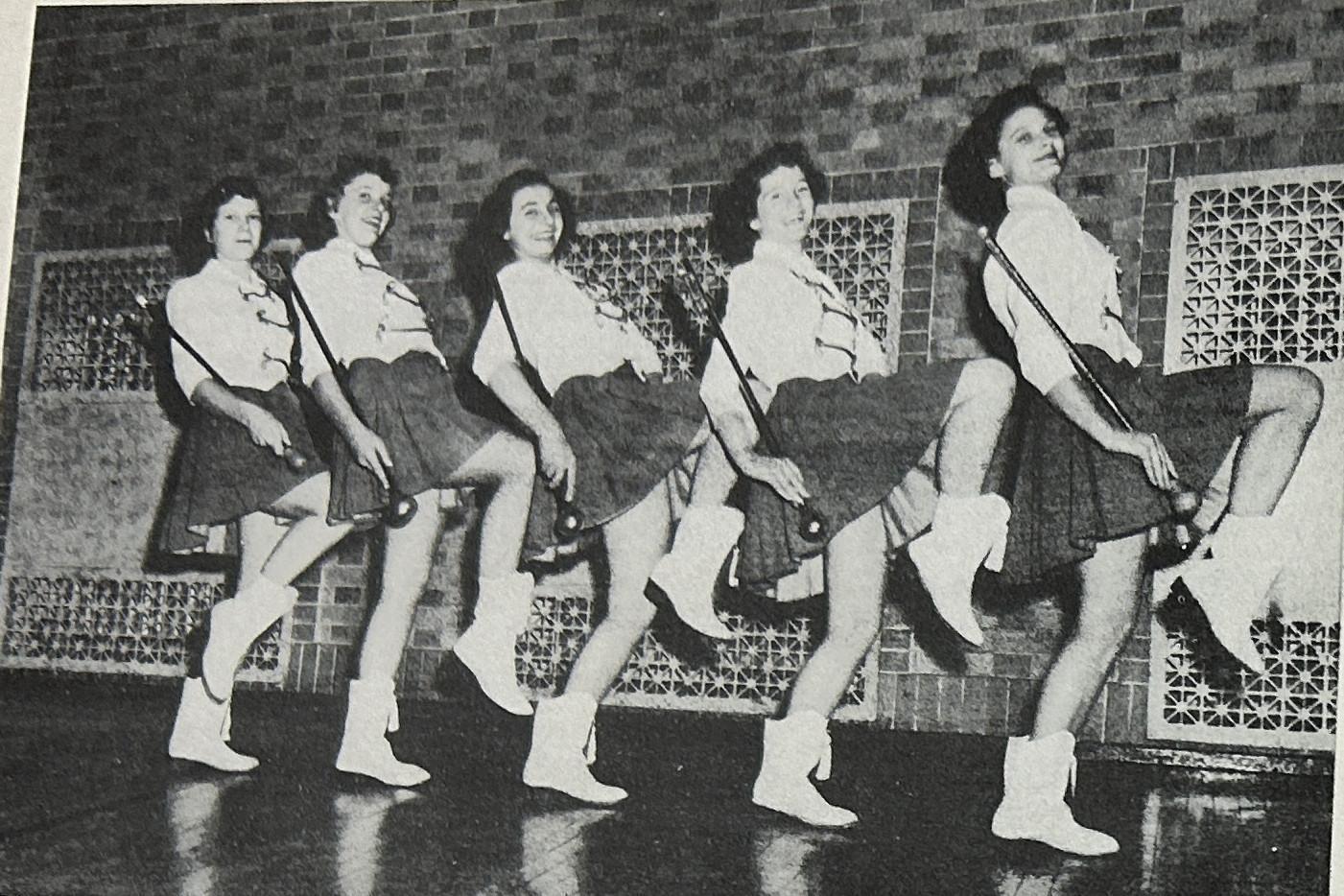
In 1951 the marching band introduced its inaugural majorettes to the lineup, marking a significant addition. These majorettes personally stitched purple skirts paired with white and gold tops. This group of five majorettes included M. Smith, Donna Reutenik, Elona Peck, Carol Lydic, and Mary Ann Wlodarsky. Beyond their role in the band performances, these majorettes showcased their talents on various outside occasions. The same year, the orchestra option was discontinued for student musicians, who became integrated into the concert band.

As the 1952 school year drew to a close, the combined efforts of the Vermilion Parent Teachers Association and the newly formed group of Band Moms bore fruit. These combined groups successfully fundraised for the acquisition of new band uniforms. The purchased uniforms were sufficient to outfit a forty-piece band, with an extra six uniforms designated for majorettes for the upcoming 1953 school year. These purple and gold uniforms marked the beginning of the band’s transformation into a more professional-looking group. The 1952 fundraising group would continue to meet and became the Vermilion Band Boosters. Alongside this progression, 1953 introduced another noteworthy development: the emergence of the first officially recorded head majorette, Nadine Miskow.
With the addition of the majorette squad to the band, on September 12, 1952, the band took another major step forward at the Vermilion/Wakeman football game. The band performed a half-time show on the field for the first time during a game. While they had made parade appearances, their role at football games had been playing from the stands and sidelines, with this game they took place center stage for half-time.

As Vermilion’s growth continued in that era, the South Street School building proved inadequate in accommodating the entire school district. A new Vermilion High School was constructed on Decatur Street in 1953 to handle the growing pains. On April 12, 1953 the 1953 marching band performed at the dedication of the new school building. The inaugural graduating class of 1954 would be the first to receive diplomas from the new high school. Positioned as a neighbor to the South Street School, the new school created a campus feel for Vermilion education. However, certain facilities, such as a study hall, industrial arts facility, and cafeteria, were not included in the new building, leading high school students to regularly walk back to the South Street School for these amenities.
The absence of a designated band room in the newly constructed high school posed a significant challenge for band members. The student music groups continued to practice in the older building, underscoring the continued importance of South Street School for the high school music program.
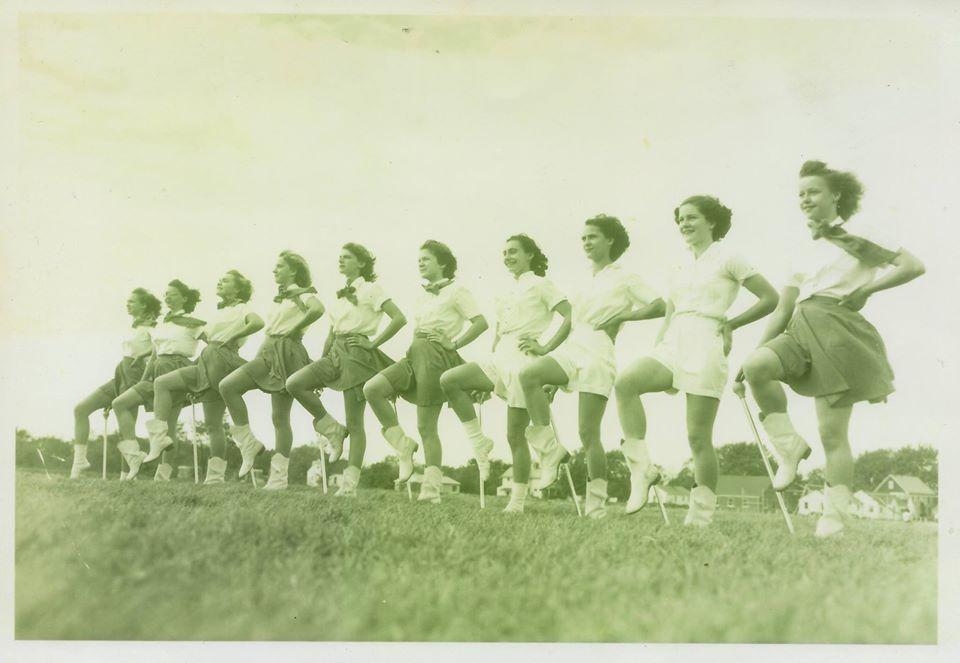
A new annual tradition started in 1952 at Vermilion High School – Homecoming. The Vermilion Homecoming weekend takes place on the first home game following the initial away game. Its purpose is to unite alumni, students, and the community in a spirited celebration of the football team. Traditionally, there was a dance immediately following the football game, but over the years, Vermilion has adjusted this to occur on the Saturday after the Homecoming game. Another significant element is the election of a Homecoming Queen (and later a Homecoming King) to preside over the festivities. The first Homecoming celebration saw the election of Jane Bradely as Homecoming Queen in October 1952.
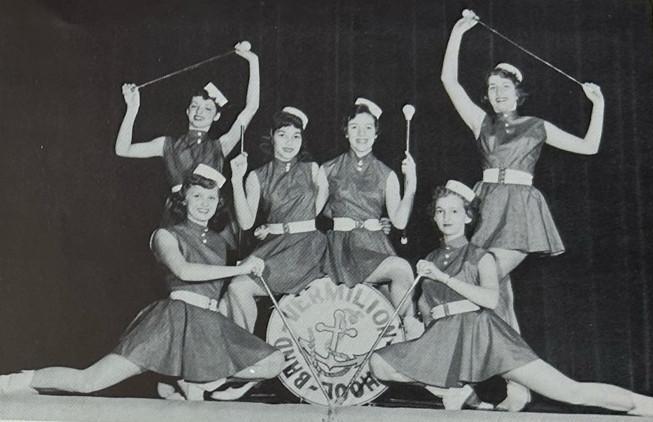
The Band President and Secretary roles were introduced in the 1954 school year and the 1954 school year also marked the initial division between the marching and pep bands. The pep band, known then as The Basketball Band, was limited to fifteen members, each of whom had to audition for their positions. The pep band would perform at all home basketball games.
Fanfares
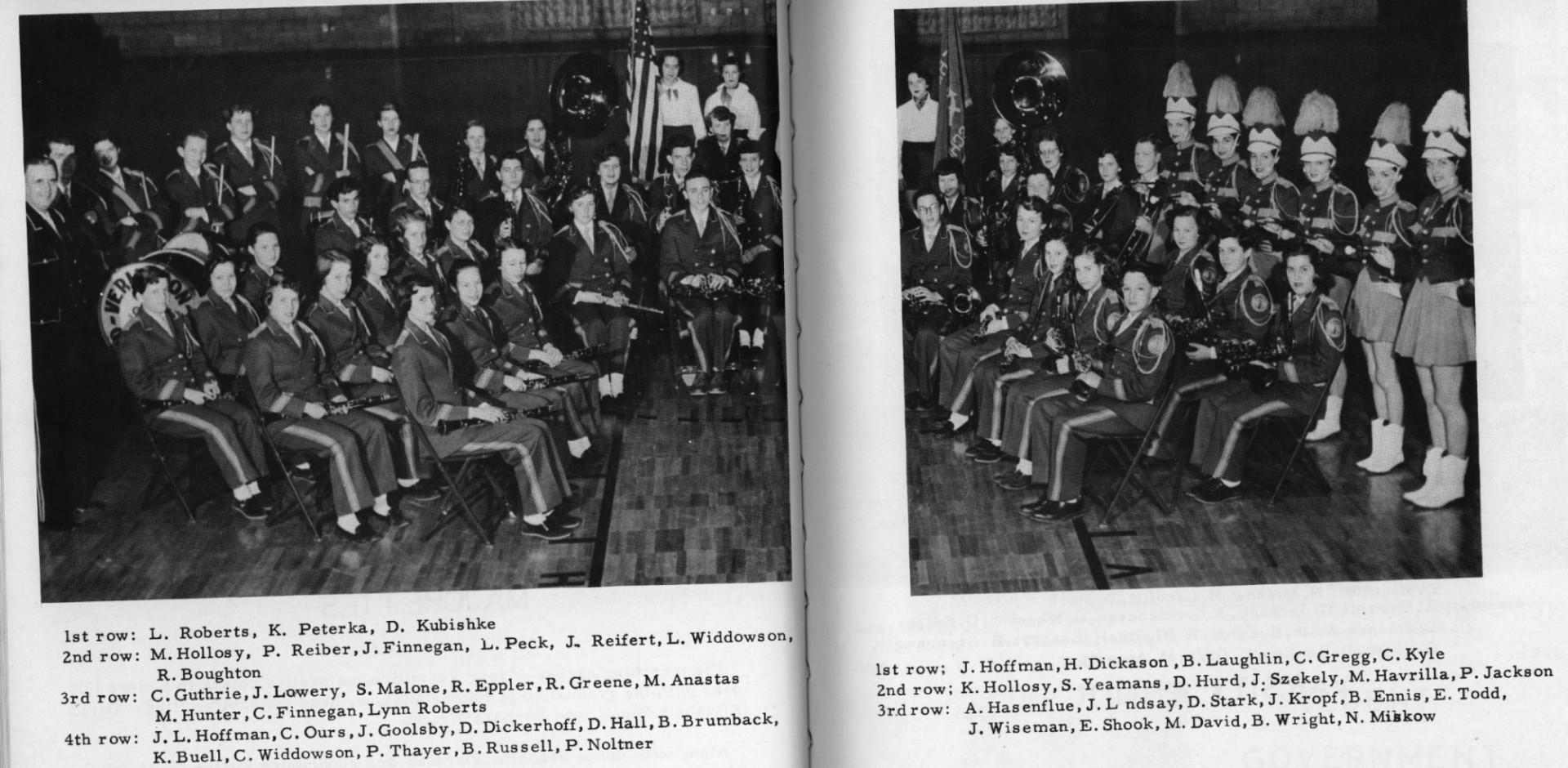
By the end of the 1955 school year, Mr. Hoffman had made a significant decision regarding the Vermilion music program. Rather than dividing his time among different schools, Mr. Hoffman decided to devote his efforts to a single school system. Unfortunately, that school system was Huron. When he departed, he left Vermilion in excellent shape for the next director. The legacy of overseeing the school orchestra, concert band, marching, and pep bands were all left behind after having been created by or under the stewardship of Mr. Hoffman during his tenure of 26 years. The Marching Band had grown to 60 members, including 40 musicians, all to be led by the famous William “Willy B” Burt.

William Burt arrived for the 1956 school year as a whirlwind of change for the band program. Mr. Burt believed that to be a successful marching band member, three things were required:
- Be at the right place, at the right time, with the right equipment, in the right frame of mind
- March with the feeling of rhythm
- Espirit de corp
Among the first changes he implemented was the band’s pre-game routine. The band began playing The Vermilion Fight Song during the pre-game and stood in double lines as the football team passed through the lines onto the field. Additionally, the band began the tradition of performing a different show for each home game. Though it was his first year, he planted the seeds that would later grow into the band’s unique identity.
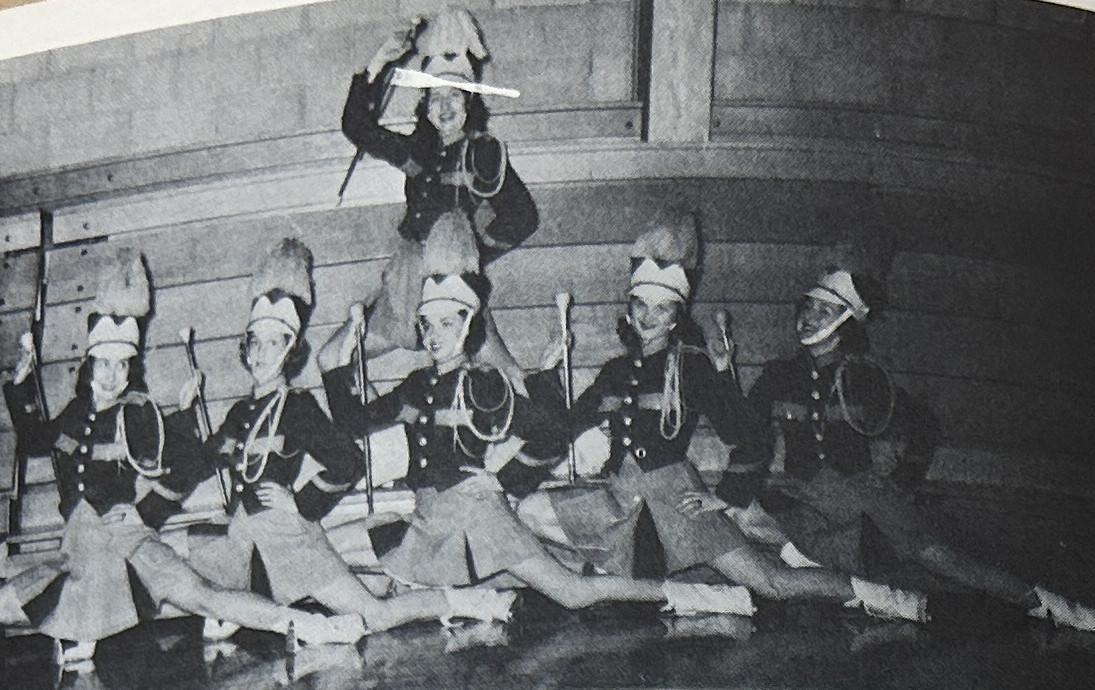
The band was transformed into a traditional military-style marching band, even as other schools began shifting to dance-style marching bands. The Vermilion Sailor Marching Band aimed to convey strength, tradition, and authority through precise movements. Other marching bands were performing simple routines with less field movement. Vermilion’s military-style precision performances were a sharp contrast compared those other performances.
When the band entered the football field, they played a fanfare still in use today. This fanfare served as the announcement of the band’s arrival, grabbing attention and demanding notice from the crowd. It was the band’s way of competing with distractions like concession booths and making the statement: “We are the Vermilion Sailor Marching Band.”
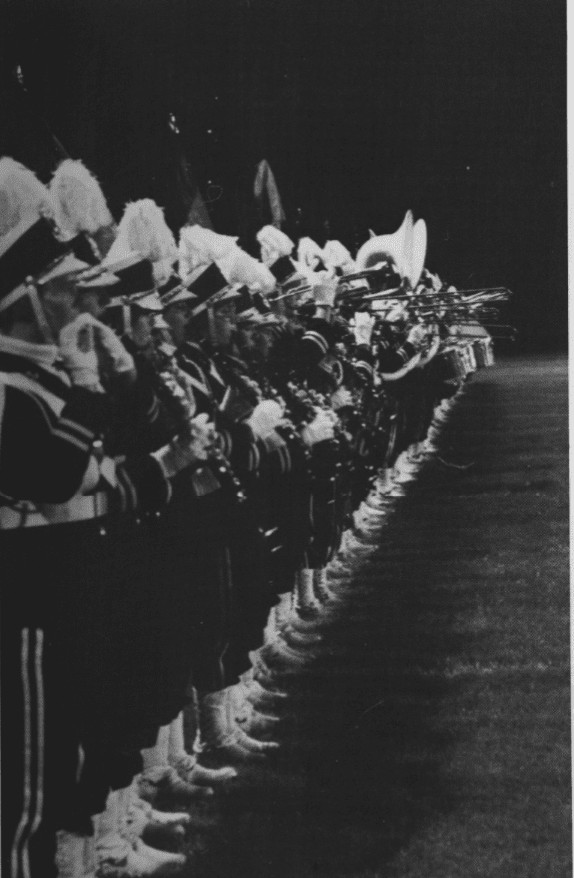
The band’s marching style, often referred to as the “black line,” was a modified version of the Casavant method for marching. This style originated with Albert Casavant in the early 1950s at City High in Chattanooga, TN. Originally known as a precision drill, this style gained national attention during a Washington Redskins game broadcast in 1955, which coincidentally marked Mr. Burt’s first year teaching at Vermilion.
While it is sacrilegious to share another band’s picture or video on this website, it is essential to acknowledge the influence of other bands on the early Vermilion Sailor Marching Band routines. Some aspects that would continue in the program for decades, such as the end zone formation, the single straight line formation that visually enlarged the band, and the fanfare announcing the band’s arrival, were inspired by other bands.
Mr. Burt incorporated various elements from the video referenced below, including backward marching, the head majorette directing the band during crucial sections for dramatic effect, close-quarters marching, and the concluding bow. These elements became core parts of the band’s identity and have echoed through their performances.
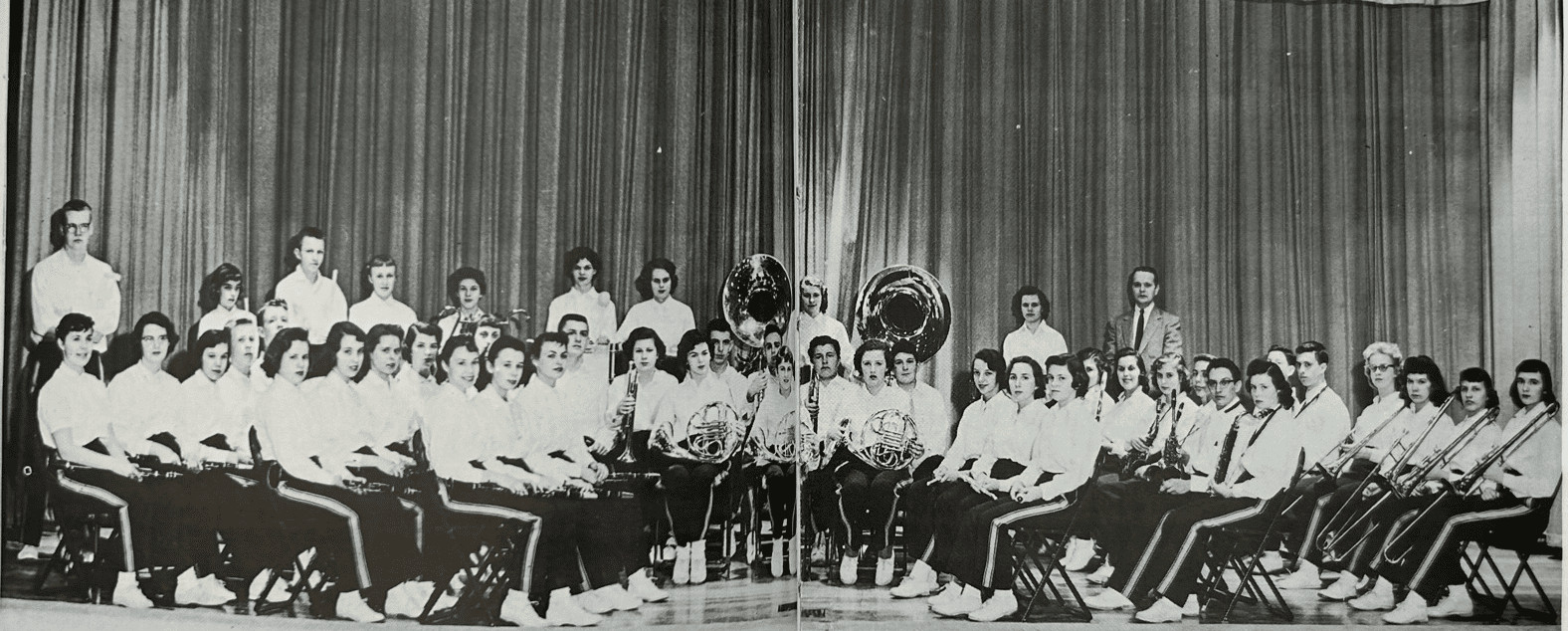
Outside of marching band, Mr. Burt brought a few new options for instrumentalists in Vermilion for the 1956 school year. The first was renaming the Basketball Band that Mr. Hoffman created to the Vermilion High School Pep Band. The second was the creation of a Vermilion High School Dance Band. The Dance Band’s first performance was after the Vermilion High School Basketball Team’s Homecoming Game. This group would become the musical entertainment for high school dances and other events.
In 1952, the Vermilion Band Boosters conducted fundraising efforts to acquire new uniforms for the band. However, in 1956, the band decided to take a more proactive approach to fundraising. Band students initiated an annual tradition of selling magazine subscriptions as part of their fundraising program. Magazine subscriptions would continue as a fundraising program for the band for a couple of decades.
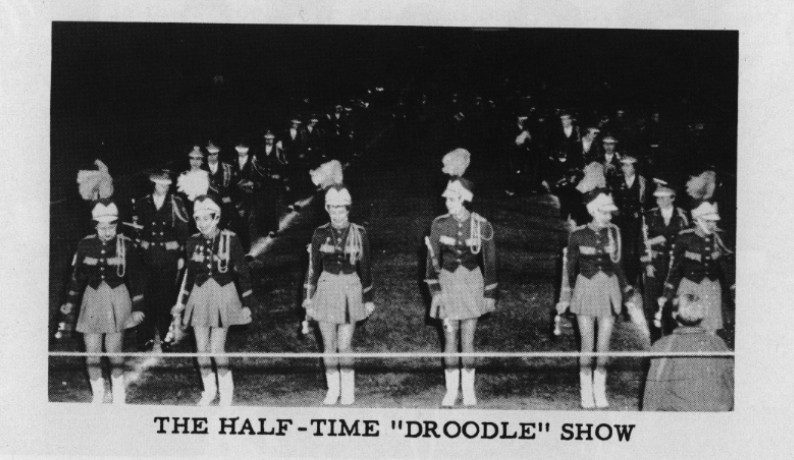
Mr. Burt led the band to perform at the dedication of the new fire station on Ohio Street on October 31, 1955. Mayor Thomas Utter gave a speech while cider and donuts were consumed by the crowd enjoying the festivities.
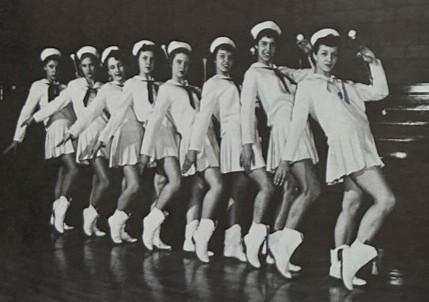
During the 1957 school year, the majorette uniforms transformed, adopting a sailor-inspired design that continues to influence the present-day appearance of the band’s majorette attire. While there have been subsequent modifications to the uniform, the foundational design initially envisioned by Mr. Burt remains a beloved choice among fans. The majorettes also started rehearsing earlier in the summer than the marching band, with a few members attending twirling training camps.
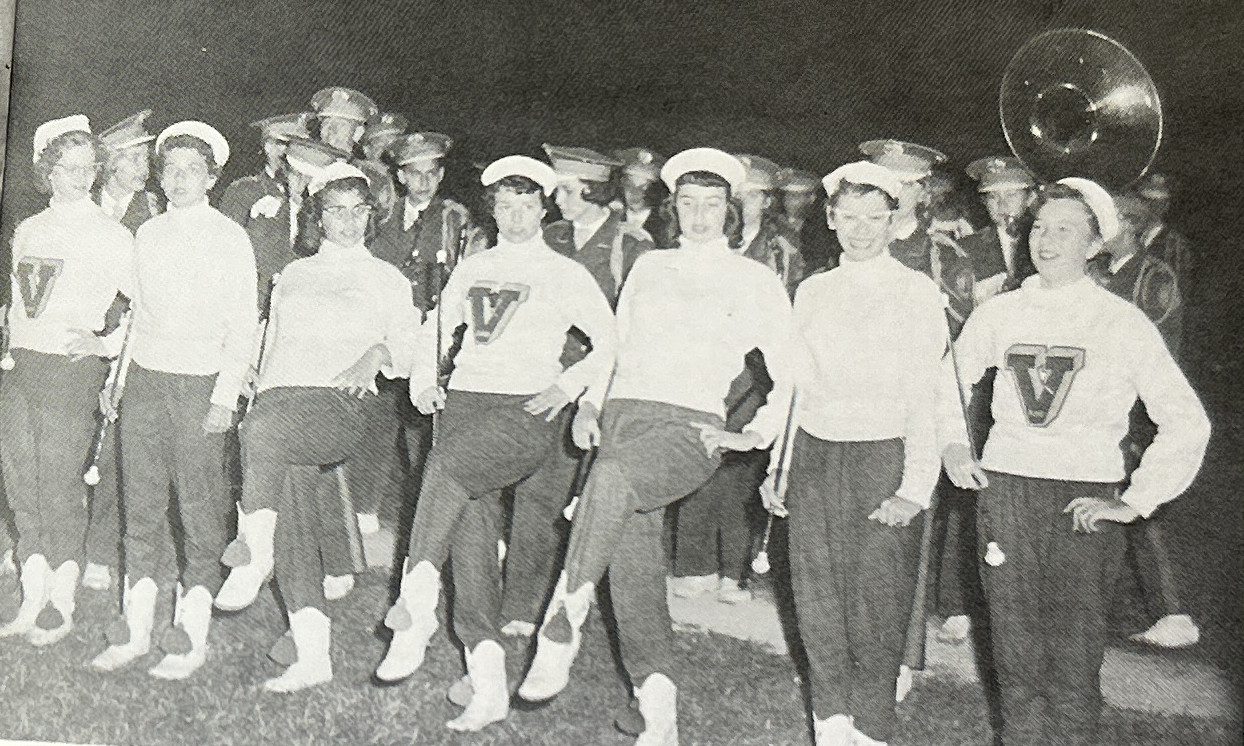
In the 1958 school year, significant changes came to the high school. The building underwent expansion on both the north and south sides, bringing in previously omitted amenities such as a study hall, industrial arts facility, cafeteria, and a new band room. With the addition of the new band room, band members no longer had to travel to the old South Street School for their practices.
A newspaper article called the band room “The ultimate in band room design”. It was designed to be soundproof and acoustically perfect. There were not any right angles in the room, acoustic tiling for the ceiling, and there were tiered levels for performers. The sides of the room were lined with storage lockers for instruments. At their disposal, as part of the band room, there was an office, ensemble room, and practice room. An article listed that the band room was the subject of controversy in town, but was vague if the controversy was the cost or modern design.
In October 31, 1957, the Vermilion Lions and American Legion jointly sponsored a Halloween Parade through downtown Vermilion. The event provided a fun and festive platform for local children to showcase their costumes and receive treats. The parade was led by the Sailor Marching Band. This cherished event has become an annual town tradition that endures, but eventually migrated to the high school stadium. While the band hasn’t always been present at this event, it has made numerous appearances. One notable occasion was the 1972 celebration when the band played over thirty-two songs.
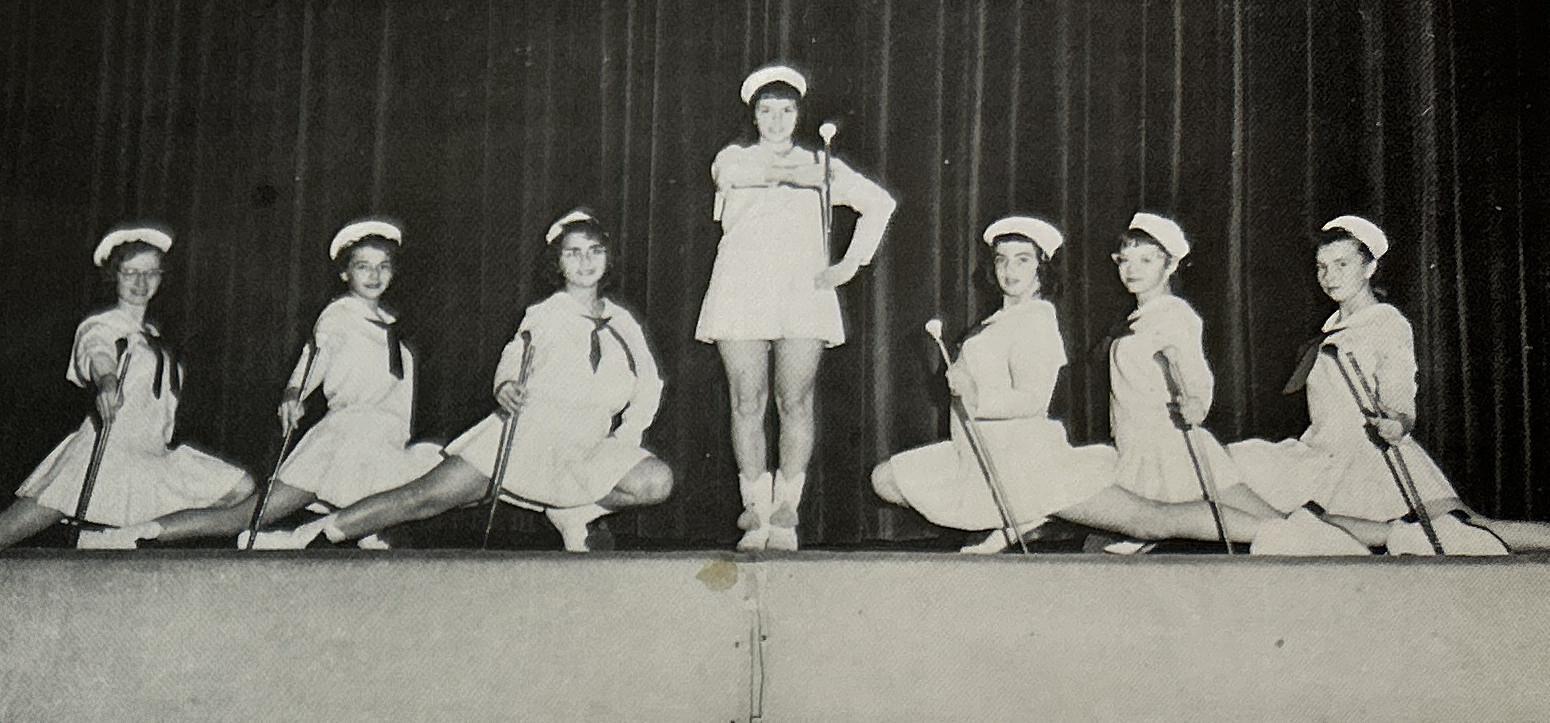
By the 1958 school year, the marching band attended an annual banquet after the season had ended. While eventually it would evolve into a banquet for just band members, these early banquets were a combination event that included the band and the football team. The Vermilion Band Boosters organized the event. At this point the Boosters programmed counted 265 families has members of the organization.
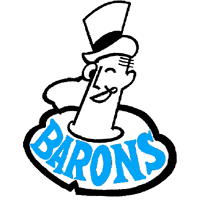
The 1958 and 1959 school years include a singular honor for Vermilion’s marching bands. This year’s marching band was the first high school band to play at a Cleveland Barons/Hershey Bears hockey game. The Cleveland Barons were a minor league hockey team in the American Hockey League (AHL). This iteration of the Cleveland Barons holds the honor of being the most successful team in AHL history. The team stopped competing in 1973. Later iterations of the team would be created for the NHL between 1976-1978 and another AHL team bore the name between 2001-2006.
Since the Cleveland Barons game was not considered a school event, school buses were not allowed to be used because of the state laws at the time. The Band Booster funds also could not be used due to those being set aside for the uniform fund. Two local civic organizations arrived with funds to charter a private bus and take the bus to the game. Vermilion mayor Fred Fischer issued a city proclamation declaring Wednesday, February 19, 1958, as “Vermilion Night at the Hockey Game”. Tickets were sold at various business in town and chartered buses were available for citizens that wished to attend the game. The band performed before the game and between periods. The Cleveland Barons awarded the band with an autographed hockey stick that hung in the band room. The band would return for the same performance on February 27, 1959.
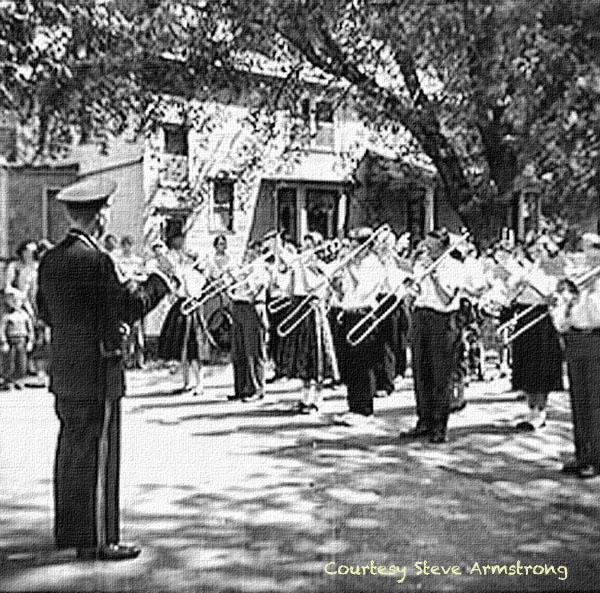
On Memorial Day 1958 the Vermilion Junior High Band played a very special performance. The Vermilion Views website covers this in an expanded story, entitled Playing for Harry. Harry Miller was bedridden from an accident in his youth. He was also an ardent fan of the marching band. The High School and Junior High marching bands would stop in front of his house on South Street and give extended performances during parades. Unfortunately this year’s performance was the last one that Harry would enjoy. He would pass away the following September. The picture was originally shared by Vermilion Sailor Alumni Band member Steve Armstrong, Vermilion High School Class of 1963, who is in the front row to Rich Tarrant for the Vermilion Views website.
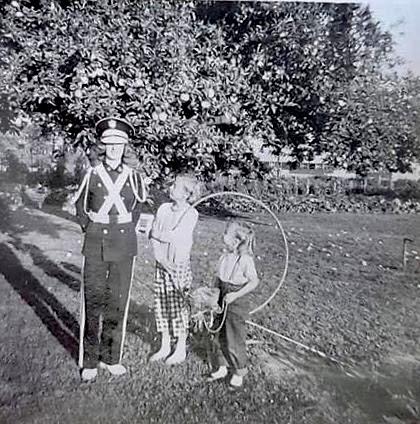
Starting in 1958 the band would hold summer concerts in the park. These concerts would be performed on separate days with different music selections. This was one way the band continued their practices year-round. The concerts were held in the early evenings and had rain days as a backup in case the summer weather did not cooperate. These concerts would continue for a few years.

During the 1959 school year, the marching band had the honor of performing at the grand opening of the newly constructed Ritter Public Library. In 1954, a discussion took place to replace the smaller library that had opened in 1935. After five years of hard work, the dream of an expanded modern library finally became a reality. The band was there to add to the celebration. The Ritter Library website documents the comprehensive journey that led to the creation of this institution.
Additionally, in the 1959 school year, a significant change occurred in the uniform design. The previous uniforms, which had served as a blueprint for later iconic ones, were replaced with a more “modern” standardized school band uniform. However, one element that remained unchanged was the hats, which retained the style of the previous bands.
To promote this transformation and the band program, Mr. Burt took a groundbreaking step by recording the first and only known vinyl record featuring The Sailor Marching Band. The A-Side of the record featured tracks like “Anchors Aweigh,” “Sailors Will Shine Tonight,” and the “Sailors Fight Song” (the VHS fight song). On the B-Side, the song “Hi-Swing” was included. This vinyl record remains a remarkable milestone for the band’s history and outreach.
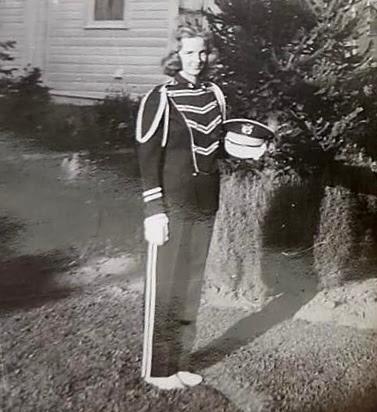
For a few years, the Vermilion Band held a sock hop at the Vermilion Fire Department as a fundraiser. This dance would allow students to listen to the latest music and purchase records of the music they were listening to. The Vermilion Sailor Band record would also be on sale at these events. While some were listed as full dances, other similar events were listed as listening parties for music.

The image above showcases the band’s uniforms featuring a modern, front-facing V design. This uniform change marked a new era and brought a fresh and contemporary look. What’s unique about these uniforms is their reversible feature, allowing them to be worn in a more traditional style that harkens back to the previous era, as seen in the image below. This duality in style offers the band the flexibility to embrace the present and the past.
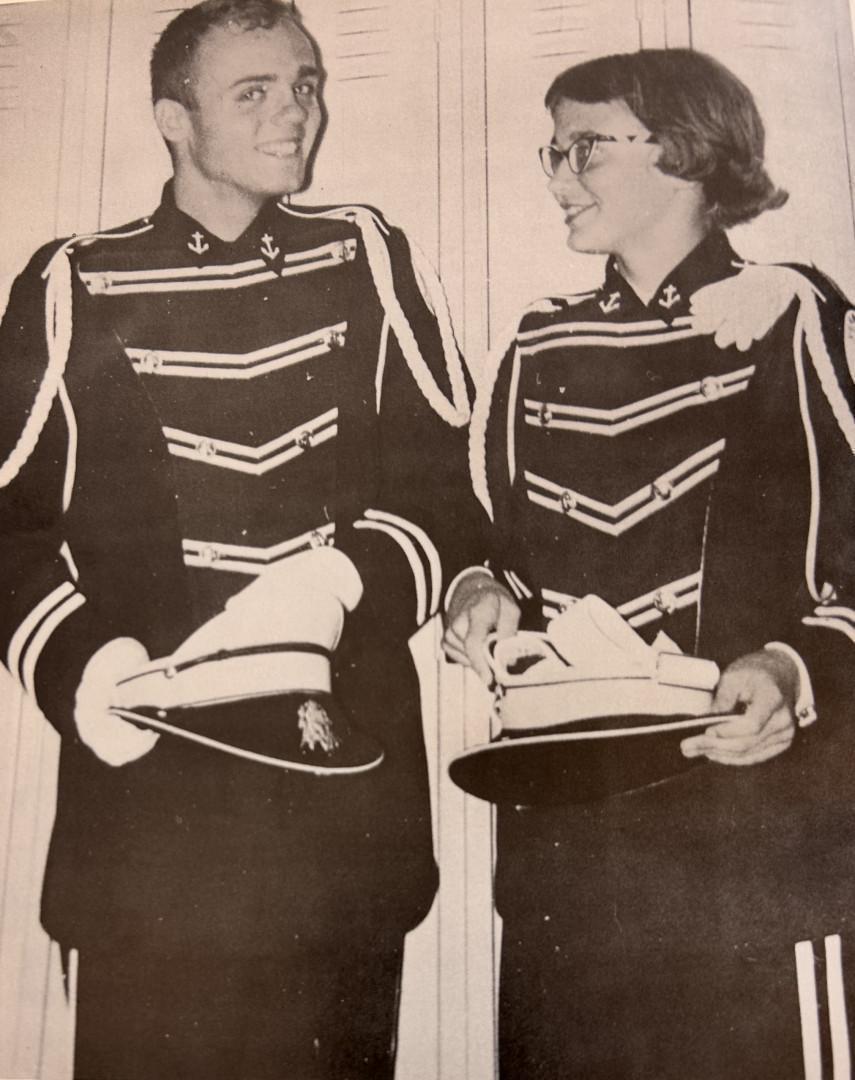
Just a few years later, in 1961, the band started occasionally wearing the traditional iconic cross-strap design uniforms. This discrepancy has caused some confusion for the author of this history, as V-emblemed uniforms were still seen in pictures as late as 1963. It’s possible that the V-emblemed uniforms were used as warm-weather outfits, while the cross-strap design was reserved for colder weather.
It is essential to emphasize the complexity of the complete uniform ensemble worn by the band. The uniform had sixteen pieces that members had to keep track of when considering each pair of items in the ensemble. The base components of the uniform were the hat, pants, and jacket. Intricate details truly set Vermilion uniforms apart from other schools. Uniform complexity from that era frustrated some members, band moms, and directors alike.
Before getting into the uniform pieces, the color needs discussion. While the band uniforms looked black, they were in fact navy blue. Following the original British standard of navy blue, they were almost but not quite black. Mr. Henry would instill this fact into members if they referred to the uniforms as black. Adding to the confusion, the color was achieved using a red dye. A vast amount of dark red dye was used to achieve the shade. The red dye confused band members who received brand-new uniform for the season and red dye would stain their skin underneath after a rainstorm. The argument can remain among members on what they view the uniform color as (navy blue, black, or deep red), however, that’s an argument that has been had with Mr. Henry already.
The overall uniform design was based on the Ohio State Marching Band, which still marches in a similar uniform. The Ohio State Marching Band was formed in the 1800s as a naval ROTC band. For those curious why the uniform Vermilion used didn’t include purple and gold or have any visual connection to the school, now you know the naval and state connections. The uniform was for Sailors through and through. Ohio State will also let you know that their uniforms are navy blue and not black.
Getting into the band uniform, around 1961, the band began incorporating the “birdy”. The “birdy” was a plume on the marching band hat adding an elegant touch. Initially, an older captain’s style marching band hat was used with this configuration. However, a newer style of uniform hat was adopted in the 1966 school year, and remarkably, that design is still in use today. For the current band, select members receive a golden plume for performances. There is a weekly selection of golden plume recipients.
The jacket resembled a Navy pea coat with a band badge on the shoulder and had several components. Braids adorned each shoulder, and when performing a turn correctly, they would briefly fly up for a dramatic effect. Cross straps went over the shoulders and crossed in the front and back of the uniform. Finally, a shiny silver buckle held the straps down and together in the middle of the chest.
Band members sported a white Dickie Collar sweater top around their necks, tucked beneath their jackets. The Dickie Collar extended just below the visible area, ensuring it didn’t add the extra heat or bulk of a sweater, which would have been impractical with the heavy wool uniforms.
Every band member also donned white gloves. Most woodwind players cut off the fingertips of the gloves for ease of playing. The gloves were a consumable with some members going through multiple pairs in a season.
The band members wore matching shoes but looked more elaborate with the addition of cotton spats. These spats extended underneath the bottom part of the shoe and needed to be laced up and tightened properly. The bottom strap of the spat could experience wear. When the bottom spat strap was well-tightened, the shoe heel protected the strap. Certain years a vinyl spat was tried, but that wasn’t the traditional one. In the 1974 school year the marching band wore white rubber covers over their marching shoes that were purchased from Del’s Shoe Store at South Shore Shopping center. The shoes themselves were white for a few years, blending into the spat – but eventually settled in on black shoes.
The pants were simple and had white stripes running down the leg. The stripe allowed the band to showcase and enhance the visual effect of movement. The bottom of the pants would be covered and held tightly underneath the spats. Many veteran members would keep a roll of masking tape in their uniform bags and wind tape tightly around the bottom of their pants. This mashup of tape and pants ensured a consistent fit and prevented the pants from slipping out of the spats. The masking tape was hidden from the public by the spats.
Rain parkas were an optional part of the uniform. These parkas were essential for protecting the uniform from becoming soaked on cold fall days to prevent the band members from freezing. The parkas added little warmth but provided cover from the rain. Parkas were used as needed and not assigned to specific band members. In some seasons parkas were never needed, and in other seasons used at almost every performance.
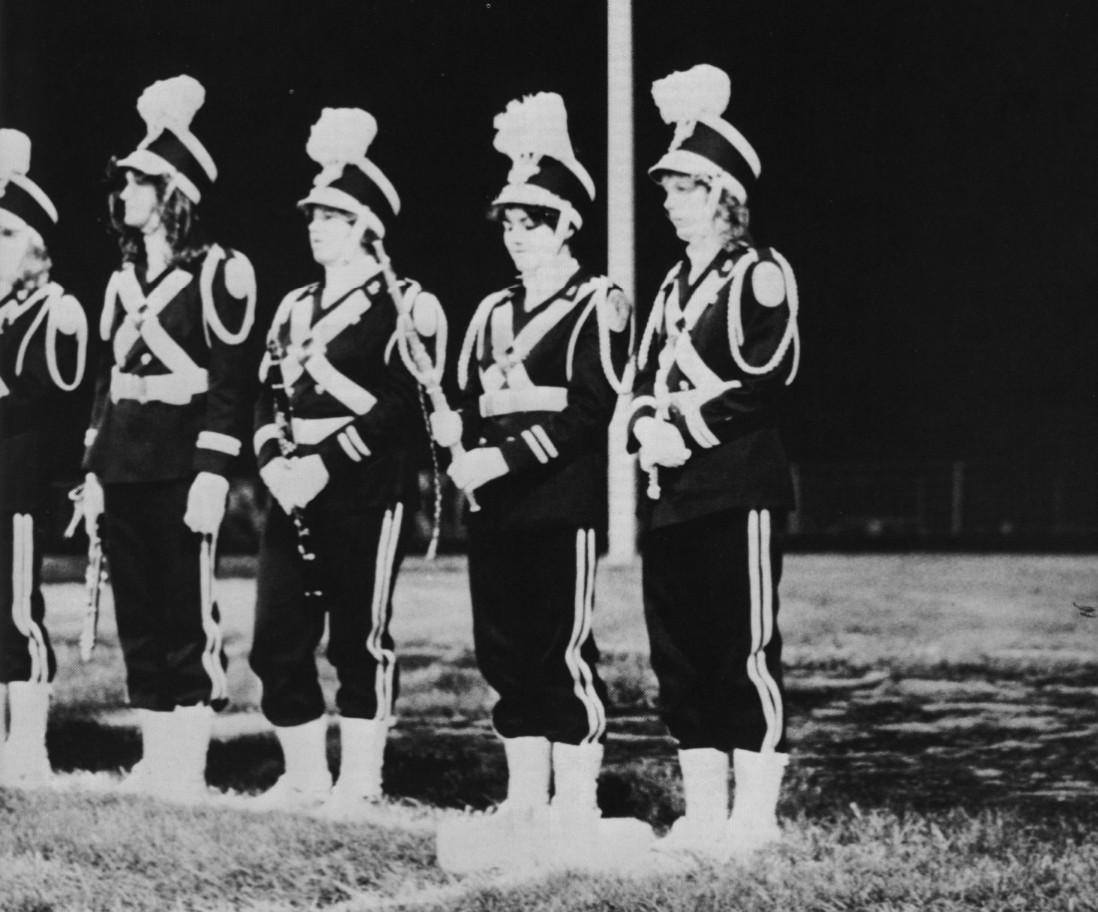
While research has not identified the definitive year, the early 1960s started the tradition of The Senior Show. The Senior Show is performed at the final home game of the year. That game is all Senior Appreciation Night. Before the game starts, all Seniors in Vermilion athletics and band are walked down the 50-yard with their parents and announced before the crowded stadium. For the half-time performance, Senior band members decide on the opening and closing numbers from their four years of marching.
The Senior show includes the whole band performing the opener. During the middle number, the Seniors are in the spotlight. The Seniors work with the band director to select a song to play as the second number. This number is usually unique and not in the standard repertoire of the band. Before playing as a Senior-only ensemble, the outgoing members would have their names announced to the crowd. As part of this number drum break normally occurs and involves band members doing different activities such as dancing, doing headstands while playing a bass drum, or running across the field spraying fire extinguishers that may or may not have been pilfered from the high school. The show ended with the Seniors rejoining the band for the closing number.
Another tradition that emerged in the early 1960s was the band banquet was held separately from the football team’s annual end-of-season dinner. Initially, the banquet occurred at Valleyview Elementary School. The banquet was organized yearly by the Vermilion Band Boosters. During this event, members of the eighth-grade band would serve the Marching Band their meals. Eventually, it evolved to include outgoing seniors giving small speeches about their experiences. The speeches eventually changed to outgoing members leaving a “last will and testament”.
The Last Will and Testament given by seniors at the banquet seems to have originated by at least the 1966 banquet. At this time and for a few more years the student newspaper, The Compass, would carry its entirety. While many of the early years were innocent and humorous, it would be fair to say that as the years progressed many inside jokes and allusions illicit behavior made it in. That isn’t to say they were necessarily problematic as much as straddled a line of acceptability that could make it past the director or parents balking too much about what was said.
Some sample Last Will and Testaments:
- Class of 1967 – Keith Seibert – To Dennis Tansey, I leave my ability to do the wrong thing, at the wrong time, at the wrong place, in the wrong frame of mind.
- Class of 1970 – I, Gretchen Backus, being of sound and body will to Brenda Smith – the “Blahs” of pre-game, Gary Mehnert -the ability to do step twos while sober.
- Class of 1971 – I, Mary Ball, being of sorry state of mind and body do hereby bequeath to Vicki Hohman 5 gallons of slide oil and 2 apple cores. To Heidi Backus a muzzle, to Linda Ford protem chairmanship of “Randy’s Bunch”, to any who will take it, 22 1/2 inches on the very end of company front.
Even the banquet would continue to evolve over the years. The eighth-grade band would eventually no longer attend, so the band members stopped receiving table-side service. The banquet migrated from Valleyview Elementary School to Vermilion High School and held in The Commons. Under Mr. Price’s directorship, the band included a concert where they performed songs from the season. The evolution has and will continue.
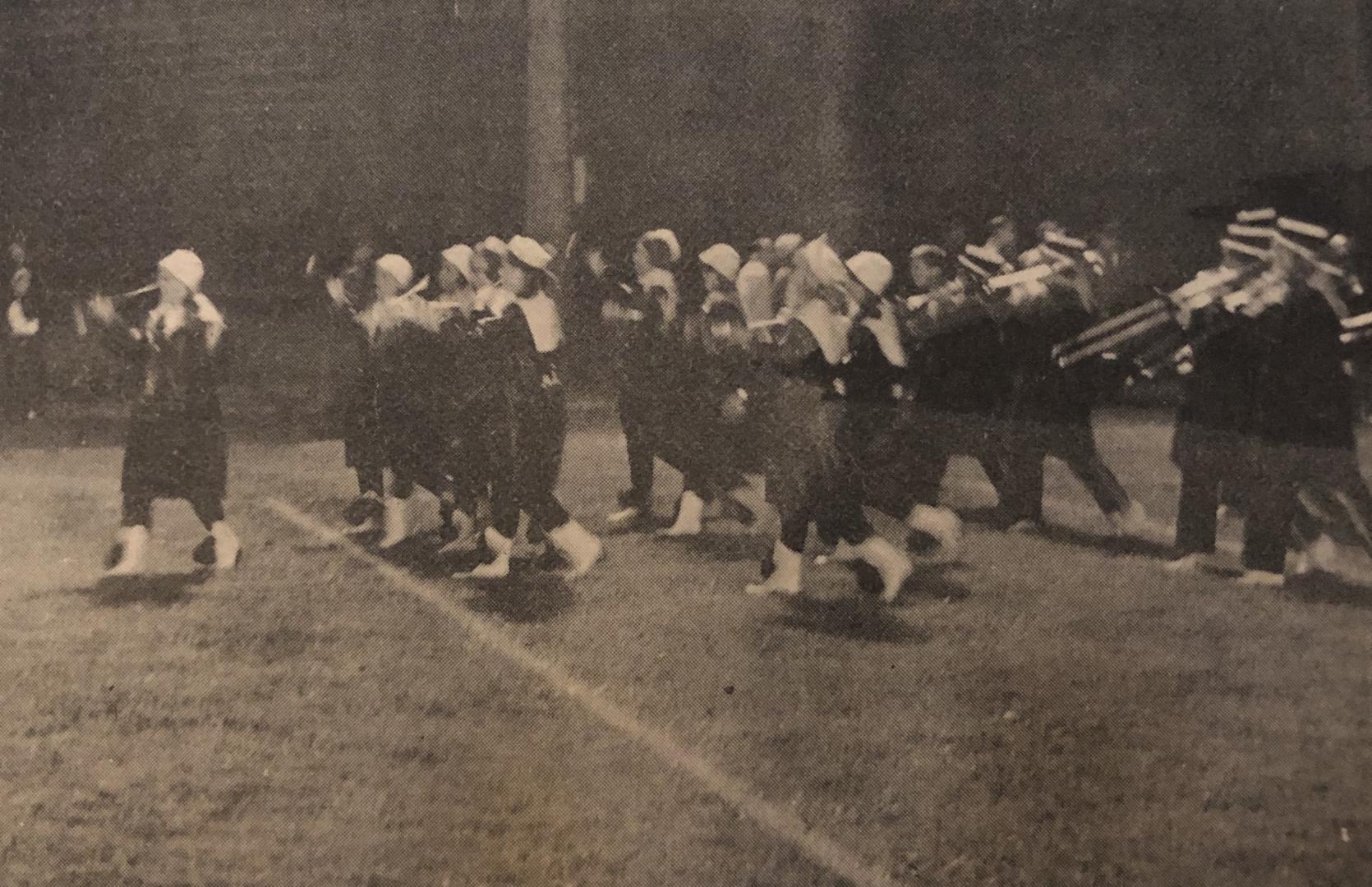
The Victory March was another tradition that has been around since at least the 1960s. The Victory March is performed once the football team secures a victory against their opponents and the time runs out. Only after the final score confirms the win do band members turn their hats backward as a symbol of celebration. It is considered bad luck to turn the hat backward prematurely. Legend has it that doing so has caused the football team to lose. With their hats turned backward, the band marches the field in a snake formation, proudly representing Vermilion High School. Sometimes, this march includes a tuba chase around the band. The image above is from 1966 and captures the band performing The Victory March in parkas.
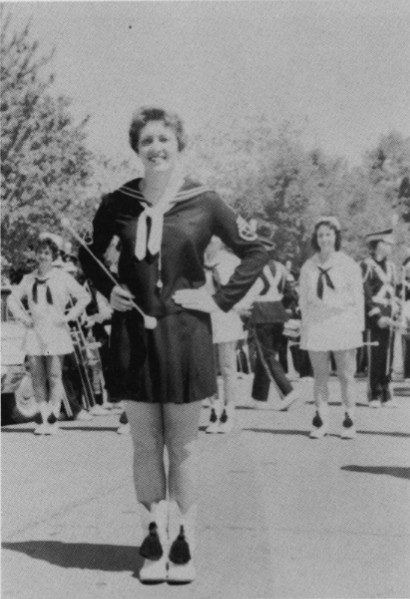
On July 9, 1960, a new post office was opened at 5463 Liberty Avenue. The Vermilion Sailor Marching Band was included as part of the festivities for the day and performed music for the opening.
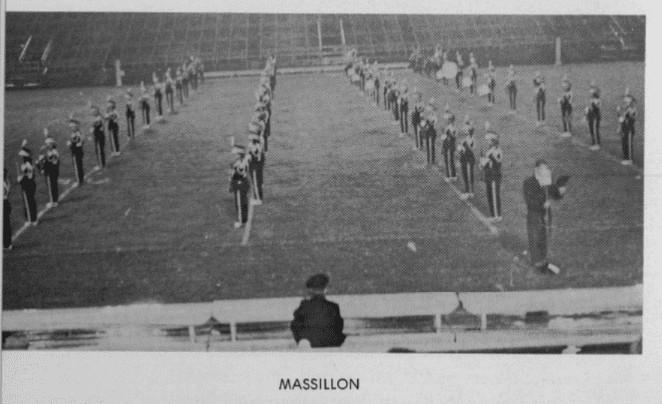
1961 also marked a significant milestone for the Vermilion marching band when they became the first to travel and participate in a marching band festival. The Massillon High School Parade of Bands held at Tiger Stadium in Massillon, OH, was that first band festival. This inaugural festival opened the doors for the Vermilion band to attend numerous other festivals, a tradition that still continues. They also performed at Oberlin College for the first of many college appearances over the years. They even had time to perform at a Republican rally at Crystal Beach.
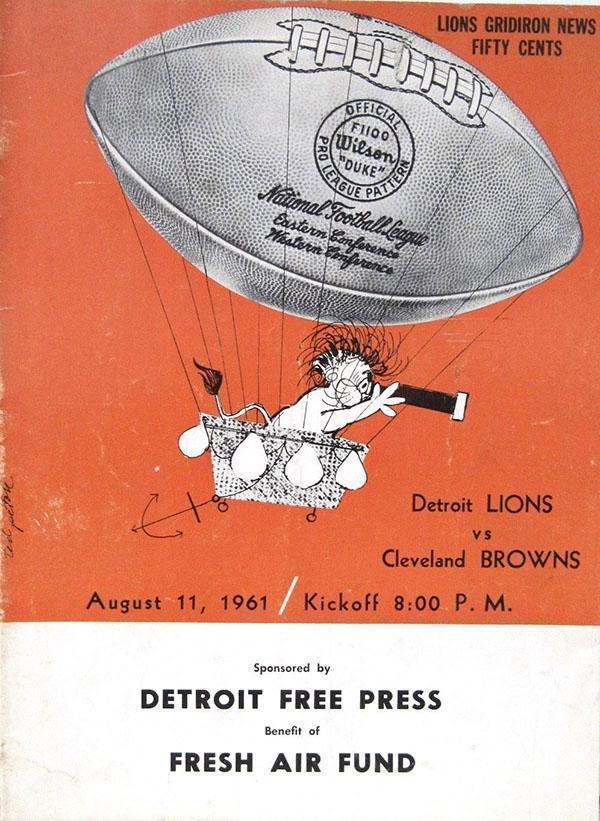
The Class of 1962 proudly held the distinction of being the first Vermilion Sailor Marching Band iteration to perform at an NFL football game. On September 9, 1961, the Vermilion Sailor Marching Band stood tall, played fanfares, and marched onto the field at the Cleveland Municipal Stadium to deliver a halftime show during the Cleveland Browns vs. Detroit Lions game. Although they aspired to be part of a Browns victory, the Lions emerged triumphant with a score of 35-7. Despite the loss, the Vermilion Sailor Marching Band was invited to future Cleveland Browns games for performances. The band performance was televised in Detroit.
In October 1962, the Vermilion Lions and American Legion jointly sponsored a Halloween Parade at the High School, providing a fun and festive platform for local children to showcase their costumes and receive treats. This cherished event has become an annual town tradition that endures. While the band hasn’t always been present at this event, it has made numerous appearances. One notable occasion was the 1972 celebration when the band played over thirty-two songs.
On November 1, 1962, the band participated in the “Miss America Homecoming Celebration” for Miss Jacquelyn Mayer, Miss America 1963, in Sandusky, OH. This performance was a parade through downtown Sandusky with twelve other area bands. After the parade, the members had to hurry back on the bus to make it back to Vermilion for the last home game of the season against Wellington.
The class of 1963 formed a committee to choose and design the high school marching band jackets. The design selected was similar to the school varsity jackets. Instead of purple and gold, the jackets would be navy blue with white trim. The back of the jacket received stitched lettering stating “Vermilion Sailor Band”. The graduation year was on the left sleeve with the owner’s name was on the right side near the bottom. Band honor letters and yearly gold bars were worn on the front left side. In later years while the band would transition to purple and gold, the majorettes would maintain the navy blue color scheme for their jackets.
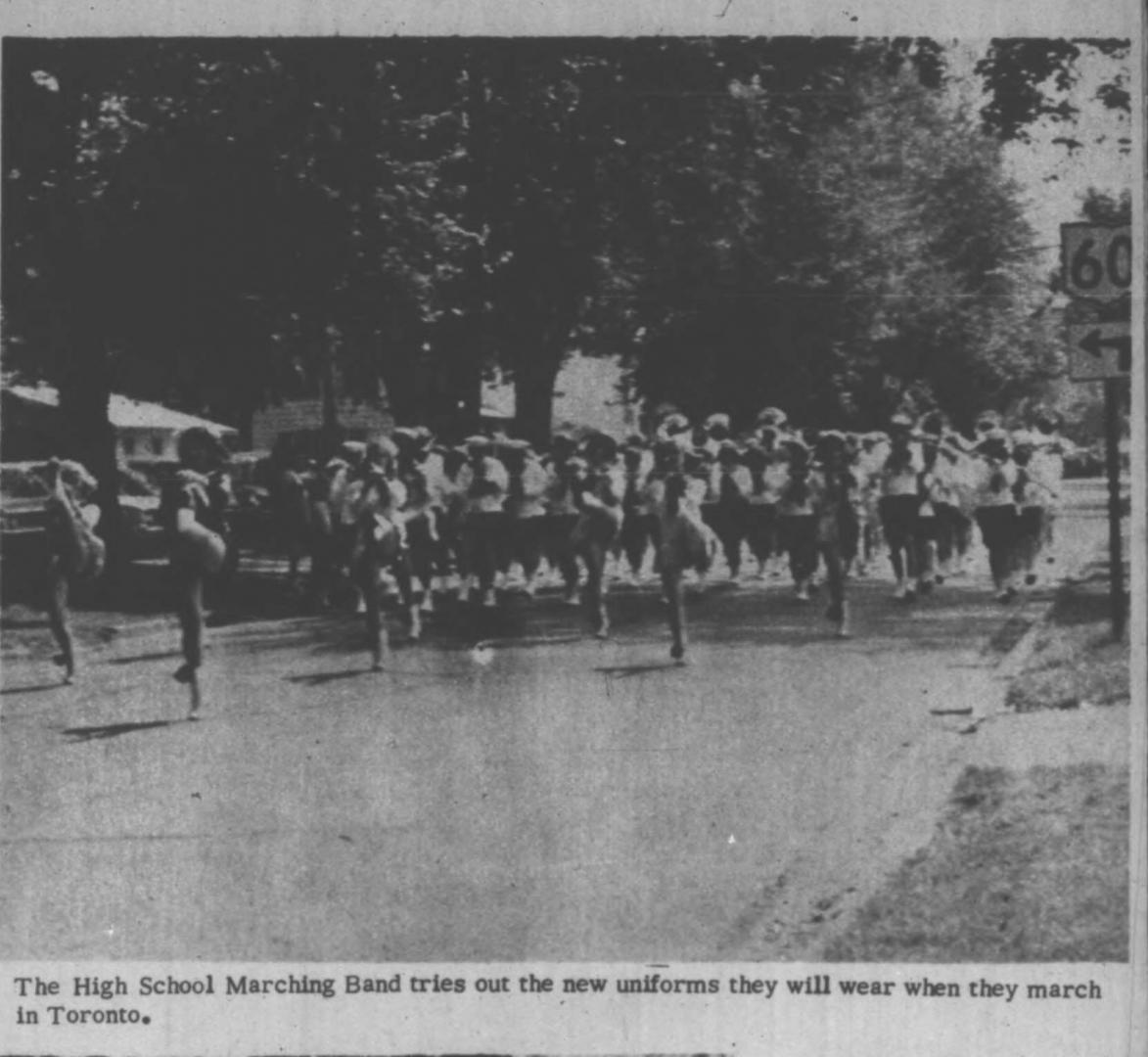
The class of 1964 was the first to go away on an overnight trip. The band was invited to perform at the Lion’s Club International Convention in Toronto, CA on July 7, 1964. Fundraising started in the spring of 1963 for the trip the following year. As part of this trip, special warm weather uniforms were purchased that entailed a white middie shirt, navy blue Bermuda shorts, white socks, and white Ked shows. The band lodged at Ryerson High School with three other bands. The trips also included a sightseeing tour of Toronto and a stop at Niagara Falls. While the band trips would eventually include other locations, Toronto was in the rotation for many years.
As the 1964 school year drew to a close, Mr. Burt encountered a delightful problem faced by many Band Directors – a surplus of music students. The city’s population had grown due to the opening of the nearby Ford Plant in 1958, which led to increased enrollment in the music program. To accommodate the growing numbers, Mr. Burt made changes such as allowing only sophomores through seniors to march in the Marching Band and starting students on instruments in fifth grade instead of fourth. Additionally, he sought assistance and, for the 1965 school year, Vermilion hired David Henry as Mr. Burt’s assistant to aid in the education of music students across the system.

The famous Sailor Marching Band artwork The Sea of Faces, was painted by Sandy Evenson (class of 1965), if alumni memories are correct. The story is that Mr. Burt commented that after so many years of teaching the band just became a sea of faces. The band was a constant while the faces in the uniform changed. This inspired Sandy to create the artwork and it was a cherished gift that Mr. Burt kept in possession until he passed. Mr. Henry is depicted on the left of the band and Mr. Burt is on the right.
In 2018 Brent Gueth commissioned artist David Spencer to create a modern variation of The Sea of Faces inspired by the original. Mr. Burt, Mr. Henry, and Mr. Price variations were created. Copies were given to the Henry and Price families. Below are copies of the original proofs.
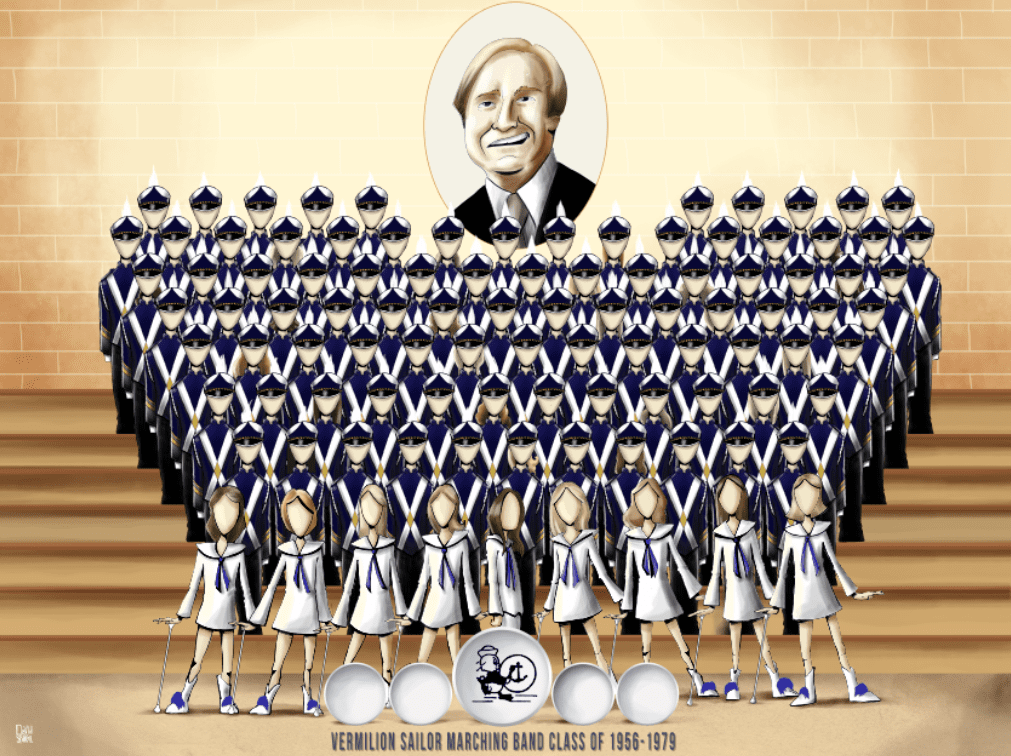
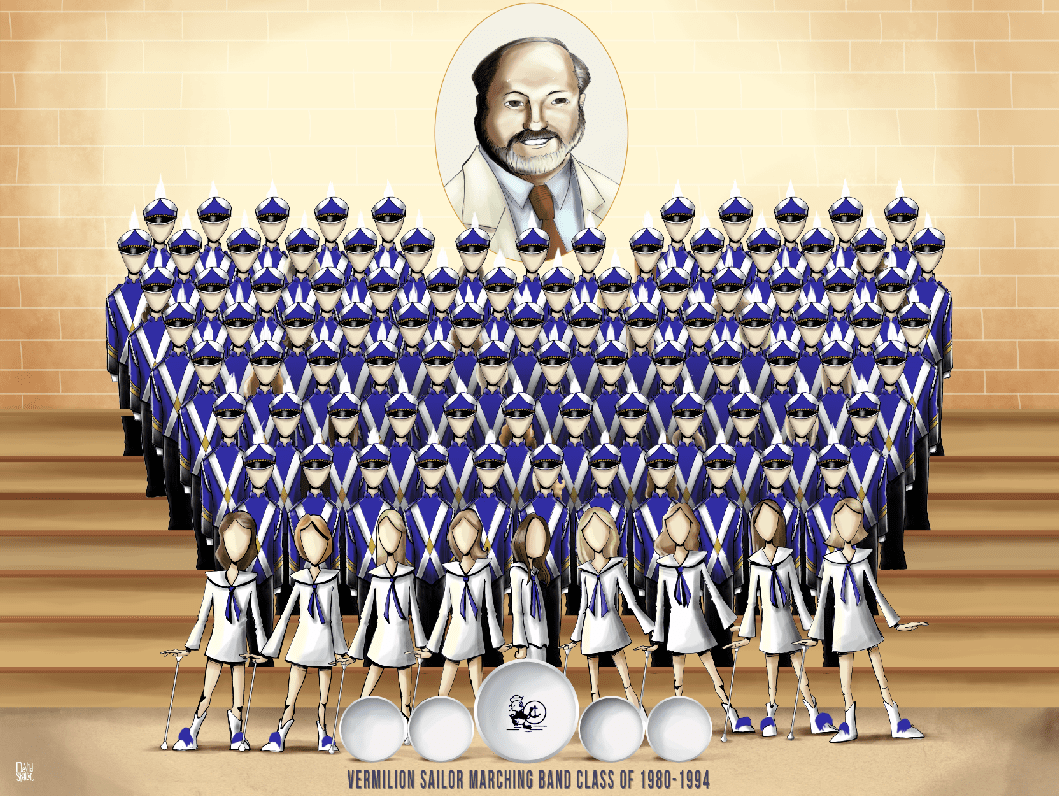
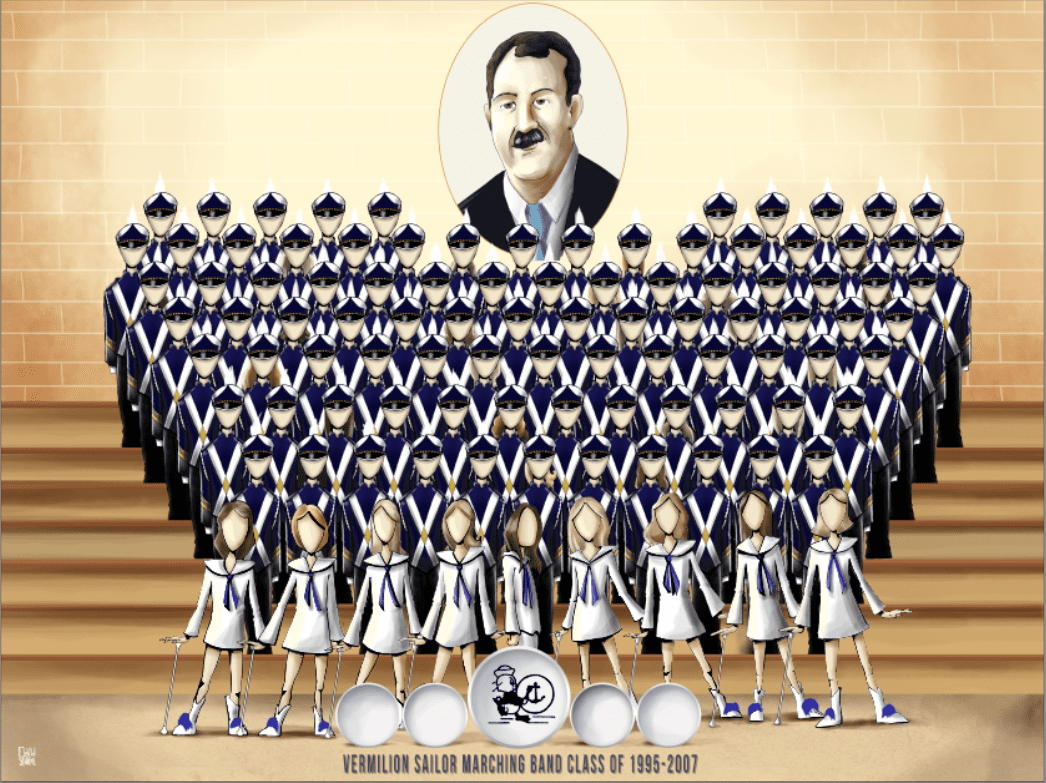
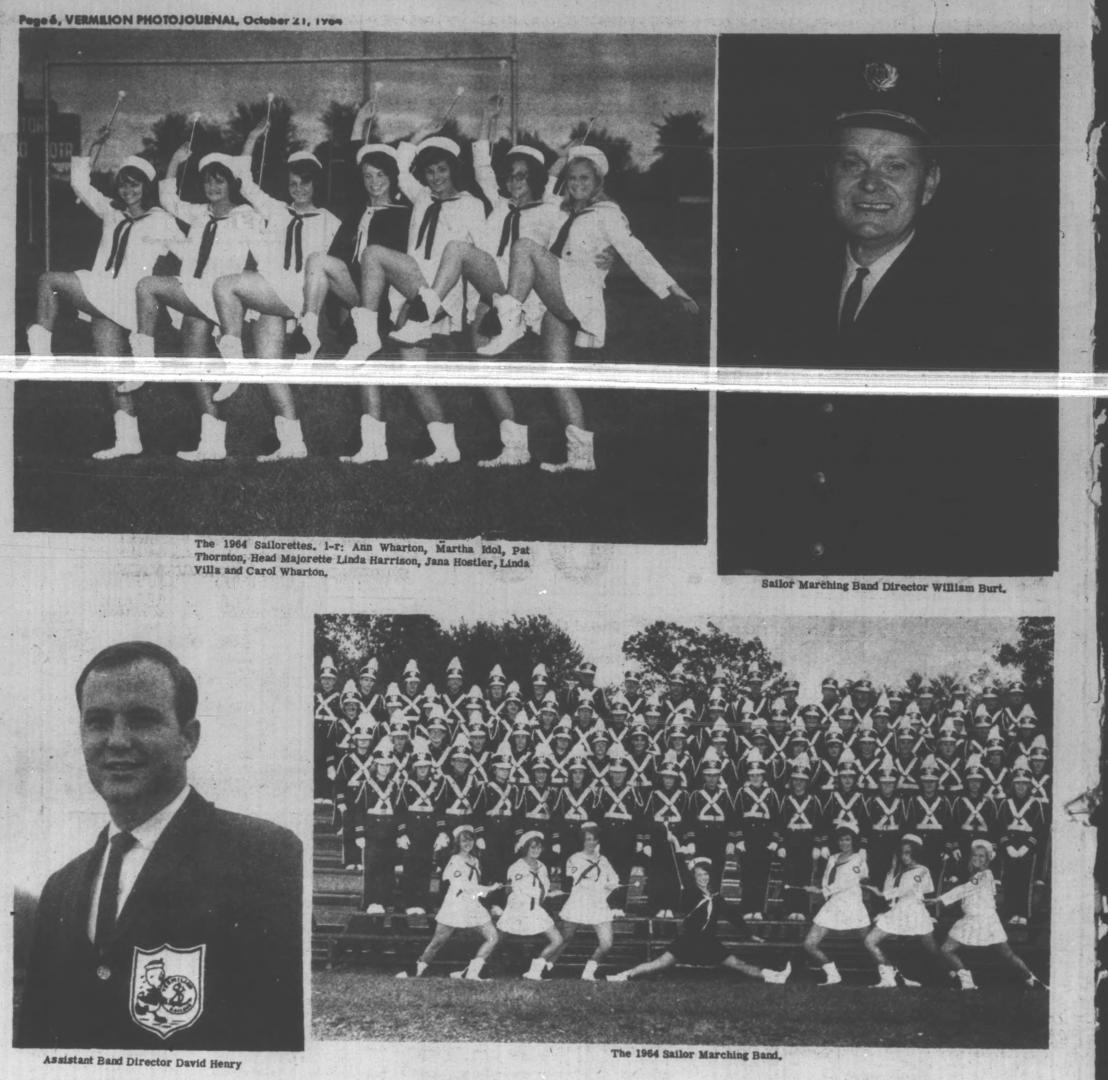
The class of 1966 may have been the first to play at the Vermilion Yacht Club after the Memorial Day Parade. Evidence of this is based on how the parade was handled. Memorial Day for the marching band includes two activities; the Memorial Day Parade and a performance at the Vermilion Yacht Club. In 1966 the band started down the normal parade route on Main Street, instead of turning on Sandusky Street, the band continued across the bridge and marched directly to the Vermilion Yacht Club. The following week The Vermilion Photojournal published an editorial complaining that the Vermilion Yacht Club scheduled their event at a conflicting time and that the community deserved the right to see the high school band in the city’s only yearly parade. In later years, the band would finish the parade route and then travel to the Vermilion Yacht Club.
At that time, the Vermilion Music Program already had an established band booster organization. Mr. Henry collaborated with the Band Boosters and successfully transformed the program into a Music Boosters program, encompassing both the band and choir programs. In 1966, the Boosters received an equivalent of over $40,000 today, with a significant portion coming from their continued magazine subscription drive.h
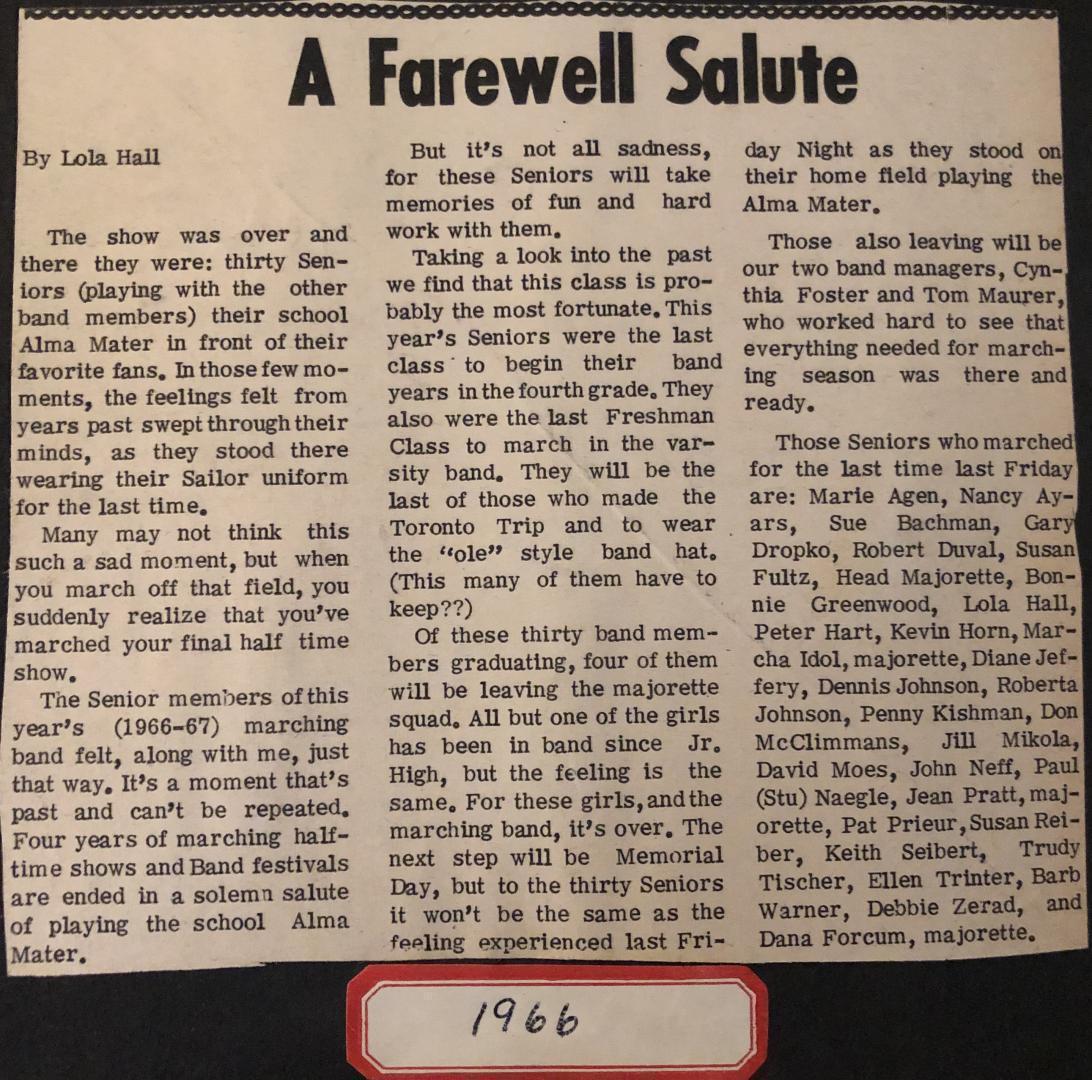
The class of 1967 experienced the last wave of benefits from the program’s growth before cuts were implemented. In a Vermilion Compass newspaper article, Lola Hall reflected on the class’s fortune as they were the last to begin their band journey in fourth grade, the last freshman class to march in the varsity band, and the last to participate in the Toronto Trip while wearing the “ole” style band hat.
Though Ms. Hall’s remarks weren’t entirely accurate, as the school later attempted to start a 4th grade orchestra program and reintroduced freshmen into the band, it was undoubtedly a significant change for the class of 1967, marking the end of an era. Fortunately, subsequent Vermilion Marching Bands were spared from wearing the “ole” style band hat again. However, what Ms. Hall failed to mention was that the class of 1967 was the last to rehearse in the old band room.
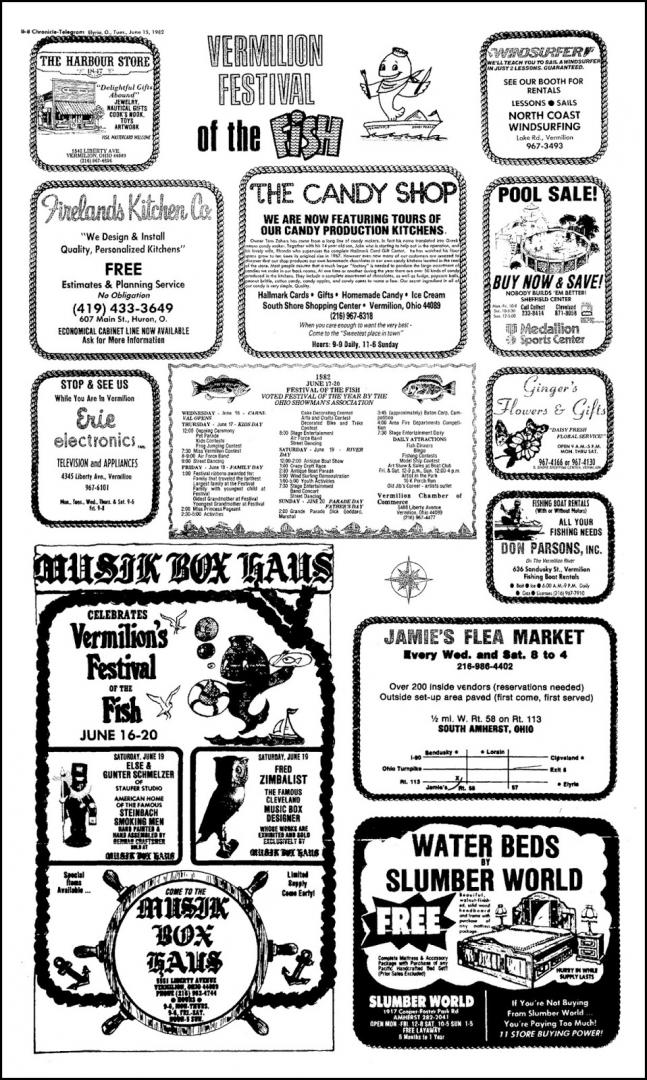
At the end of the 1967 season, a new performance opportunity was added to the band’s schedule – The Festival of Fish. Held in June on Father’s Day weekend every year, the festival includes a parade among its festivities, and the Vermilion Marching Band regularly participates in it. In the 1990s, participation in the parade became optional for outgoing seniors, and Ms. Hall, being part of the class that experienced so many “lasts,” may have been among the first to march in the Festival of Fish Parade.
During the late 1980s to the early 2000s, the Vermilion Sailor Alumni Band also joined the Fish Festival Parade. Since there were no rehearsals, the band members rode on the back of a flatbed truck while playing through the parade. The tradition involved gathering at Mr. Burt’s house on Ferry Street early to decorate the truck, set up chairs and music stands, and enjoy a light party atmosphere before and during the parade. As the last members arrived, they hopped onto the truck and contributed to the parade festivities. The same scenario would repeat itself for The Woolybear Parade.
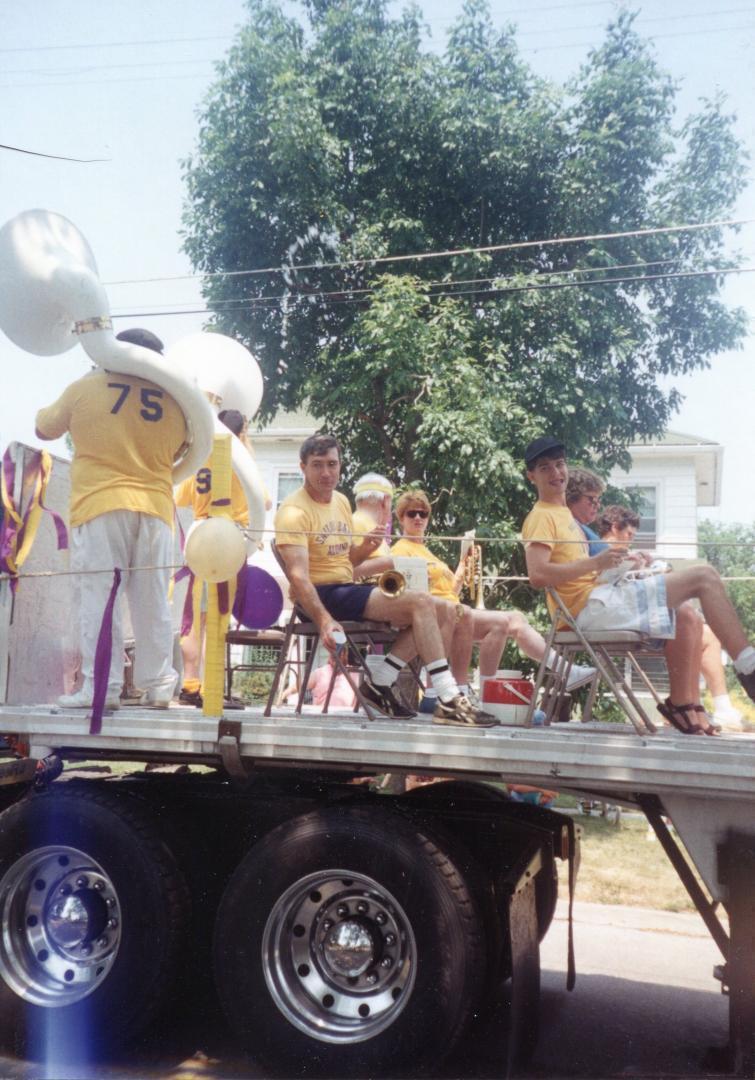
In the late 1960s or early 1970s, the Vermilion Marching Band was ready for a style change. A new marching band innovation called “Patterns of Motion” was crossing the country. This method, developed by Bill Moffit, the director of Michigan State University, was based on constant motion and utilized squads of four members, marching eight steps every five yards.
“Patterns of Motion” quickly became the dominant marching band style from the late 1960s to the 1990s and became known as the Traditional Style. Despite the shift to this new approach, some elements rooted in the modified Casavant style, which Vermilion had embraced for over a decade, persisted. For instance, the band started marching in squads of four, following the eight steps to every five-yard pattern. The Moffit style formed the basis for most routines and formations of the Vermilion Band, a tradition that continues with the Vermilion Sailor Alumni Band today.
Nevertheless, certain aspects, such as the line formation to start and specific drills that extended until the 2008 school year, remained influenced by the Casavant style. Examples include formations like the floating diamond or the heavy single-line section of MacArthur Park. In conversations during the 1990s about band styles with Mr. Henry, he occasionally referred to the band marching in a “traditional precision style.” This blend of influences from different eras persisted for decades, creating a unique and distinctive Vermilion style, often affectionately referred to as “The Vermilion Style” or “The Burt Style.”
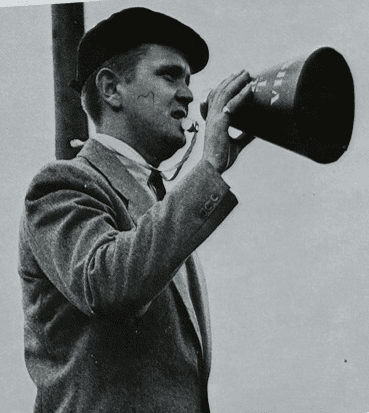
Components of The Vermilion Style were in place and while parts remain, the bulk of the components that make up the style would be standardized through the 2007 school year. That isn’t to say that Mr. Burt, Mr. Henry, and Mr. Price all used the components in their drills, but they are all part of the Vermilion Style for that era.
It’s important to note that Vermilion marched toe to heel in a military style. This means that a marcher’s foot should always touch the ground with their toes first before their heel hits the ground. For some fast pieces, a marcher’s heel may never fully touch the ground. The step length is to march “8 to 5”. This means that there are eight steps exactly five yards. This stride is 22.5″ inches for every step forward or back. Each step normally hits the ground on the beat, this helps the band maintain the tempo to the music. Almost all steps and movements for the marching band start on the left foot.
Along with the step, band members were expected to display certain affectations in their performance. First and foremost band members should stand up straight with shoulders slightly back to display pride and confidence. When the band moves from a stationary spot to a forward movement, they are to perform a rare back. A rare back is performed by lifting the left foot and leaning the whole body back slightly before bringing the left down again in a fluid motion. When turning a direction shoulders should perform a flash where the member lifts their instrument for a quick turn to cause the shoulder braids to fly up slightly to accentuate the movement. The design of the band uniforms helps accentuate all of these maneuvers.
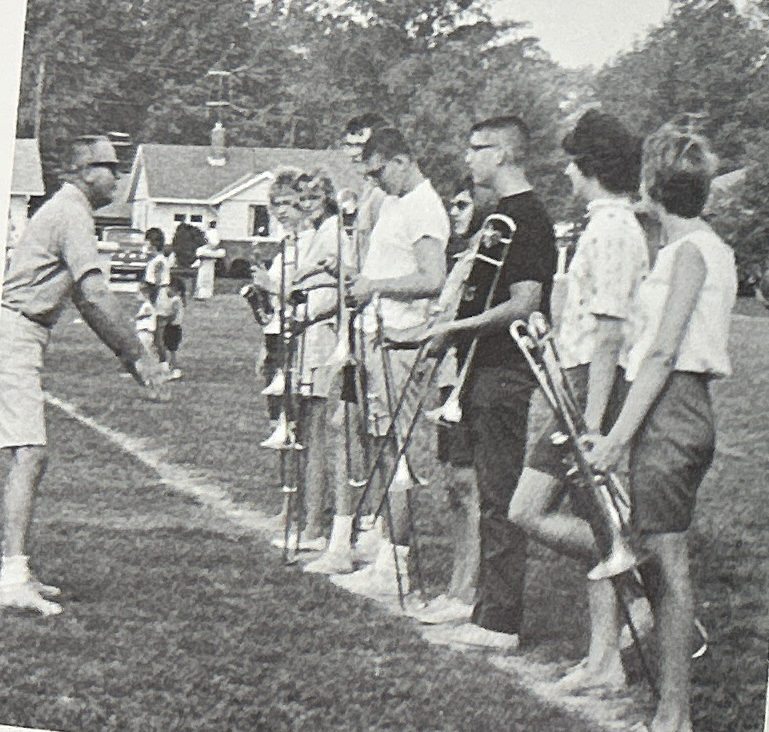
In The Vermilion Style band members are broken down into squad eights for routines. For example, squad 6 members would have the numbers 61-68 delineating them in the routines. This is broken down further by odd and even numbers into squad fours. 61, 63, 65, and 67 would be squad six odd and 62, 64, 66, and 68 would be squad six even. Once in concert formation 61 and 62, 63 and 64, 65 and 66, and 67 and 68 would be mirrors of each other on opposite sides of the 50-yard line. Depending on the routines for an opener and closer, not all movements may not be mirrored between an odd and even squad four. It is all dependent on the entrance exit routine that is called for. In a properly balanced band, the only member that would not be mirrored is the head majorette.
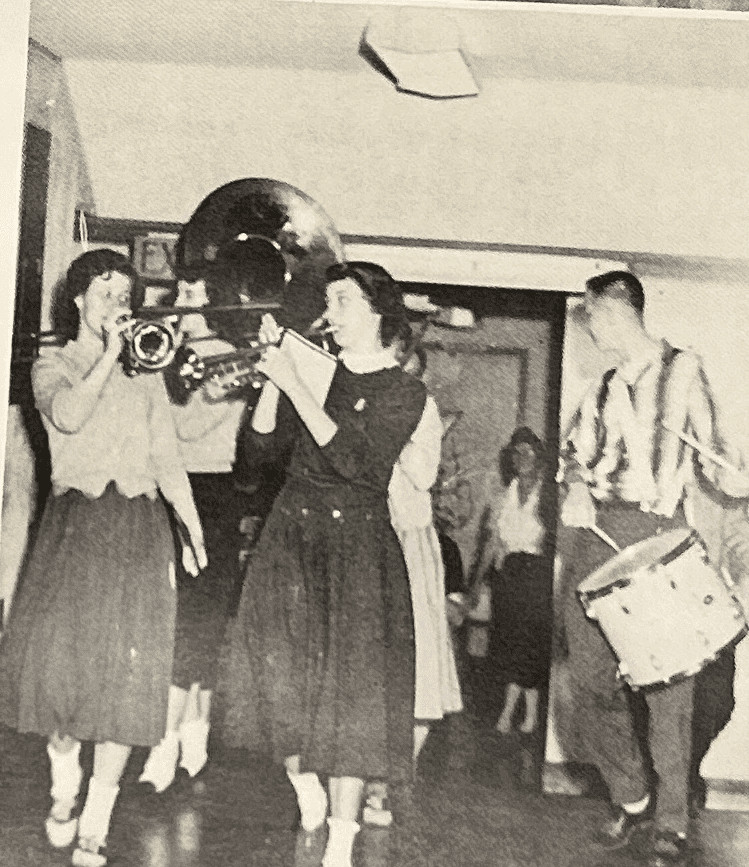
When a band member looks at band directions for the first time, some terminology and the shorthand directors use to write that documentation may seem very cryptic. The most common terms and shorthand used by the Vermilion Sailor Marching Band directors take a bit to get used to. Directionality can be combined with the command so Away or A means the direction is towards the away side bleachers of the field, Home or H means the direction is towards the home side bleachers of the field, In means towards the 50 yard line, and Out means away from the 50 yard line. So a command might be written FM 8, PWH 8, STA 8. This would translate to Forward March (FM) 8 steps, Pinwheel (PW) to the home (H) bleachers 8 steps, and Slow Turn to the away (A) bleachers in 8 steps.
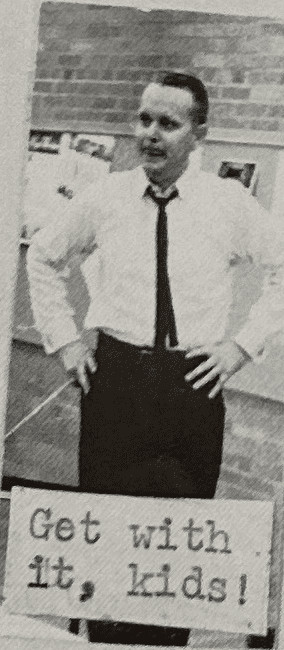
Common Vermilion Sailor Band Instructions
- Mark Time (MT) – The band marches in place without any forward movement.
- Forward March (FM) – The band marches forward in the direction they are currently facing if no direction is specified.
- Backwards March (BM) – there are actually two types of backward marching used by the band. The first is a normal step used to adjust or get a band member where they need to be in short order. The second is a theatrical style where the band will march slower and exaggerate the appearance of the leg lift for visual effect. The end of the MacArthur Park routine showcases the second style.
- Stride Step (SS) – While the band normally marches 8 steps for every 5 yards, stride step marches 6 steps every 5 yards with a 30″ stride for each step compared to 22.5″. Most commonly the band will use this for diagonal corner entrance drills. The Magna routine is an example of this type of entrance.
- To The Rear (TTR) – The band member makes a 180-degree turn returning to the direction from which they came.
- Breakaway (BA) – A band member performing a breakaway will take two standard steps backwards and then perform a 180-degree turn.
- Pinwheel (PW) – A pinwheel involves a squad four moving at a solid angle as if on a fulcrum. For this maneuver to look optimum the pinhead (the fulcrum point) must make 8 small steps, the second and third members of the squad make almost normal steps, and the member of the squad has to perform a stride step.
- Slow Turn (ST) – A slow turn is a turn where the band member moves at a slower-than-normal rate. To turn 90 degrees requires four steps and a a 180 degree turn requires 8 steps.
- Half Time March (HT) – A half time march is taking a single step every two beats instead of one.
- Fast Break 16 (FB16) – In a fast break 16 a squad makes it to a line as a whole. The first member of the squad performs a to the rear and marches eight steps in the opposite direction and marks time eight steps. The second member of the squad performs a to the rear and marks time sixteen steps. The third member continues straight for eight steps, performs a to the rear the same time the first member starts marking time, and marks time themselves for eight steps. The fourth member of the squad continues forward sixteen steps and performs a to the rear. The end result is having one member on four different goal lines twenty yards between the first and last member of the squad. While there is no reason this manever couldn’t be done against the yard line, it’s almost exclusively used within yards marching towards or away from the fifty-yard line.
- Step Two – A step two may start from the left or right of a marcher in a line. The first member of the step two leaves immediately marching forward in the direction they are facing. The next member in the line starts to move two steps later, continuing down the line until the whole line is moving or the destination is reached by the first member. In some routines all squad members collect up to the first member of the squad.
- Step Four – A step four is the same as a step two, with the exception that it is four steps before each member leaves.
- Floating Diamond – A floating diamond might be done in either a step two or step four depending on band size and the amount of movement. Squads of 8 on the line are faced in two different directions with odds and evens alternating directions. The person leading the step goes eight steps out turns around comes back to the line and goes out sixteen steps before returning. If a larger area is needed another rotation will go out again twenty-four steps before returning. This maneuver is performed on the fifty-yard line and allows an effect of a diamond flowing up the yard line. Within the diamond majorettes and color guard will normally march down the field seamlessly within the diamond openings.
- Scatter Drill – A scatter drill is a chaotic movement where band members have to get to the destination in a certain number of steps in whatever manner they see fit.
- Creep – Admittedly creep seems to be used once in a single arrangement, but it involves performing a scatter drill while bending over.
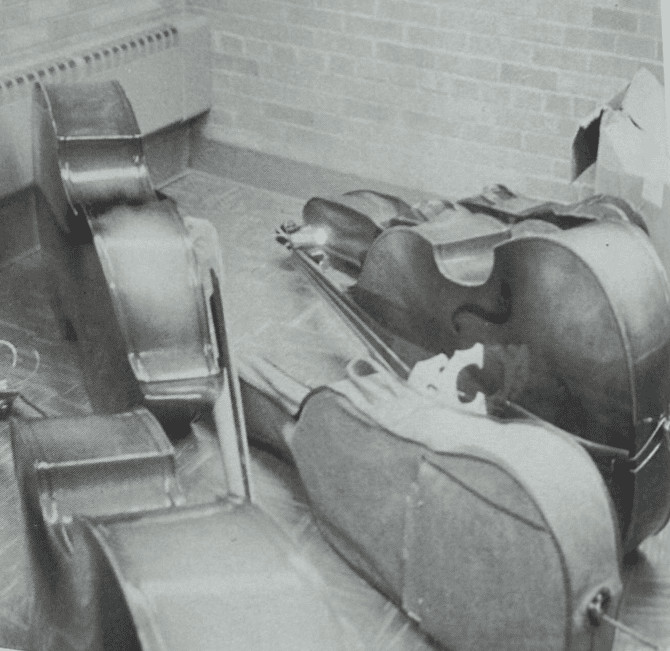
1968 included the return of an orchestra program at Vermilion schools. After an absence of seventeen years, Mr. Burt and Mr. Henry restarted an orchestral string program. Students started their orchestral education in 4th grade. This last iteration of an orchestra lasted until the end of 1979.
A highlight of 1968 was the release of the renowned “MacArthur Park.” Although it’s challenging to determine the first Vermilion Marching Band class to march to this tune, it has become an iconic routine. Mr. Burt crafted the original routine, which is still in use today. It serves as the best example of The Vermilion Style. Numerous Vermilion Marching Band seniors have chosen “MacArthur Park” as their closing number for their senior shows, adding to its timeless appeal. The routine features a high step, a close-quarters Casavanta style routine, leading into a fast break sixteen, and concluding with a captivating backward march covering twenty-four yards.
The graduating class of 1969 introduced a fresh element to their annual roster of activities – the high school musical. Over the years, this musical endeavor has not only been a source of passion but also a fundraising initiative for the Vermilion Music Department. Serving as a platform that seamlessly blends drama and choir students, the musical represents a collective effort. Within this collaboration, student musicians step into the role of providing musical accompaniment from the orchestra pit. Although the school primarily enlists student musicians for these roles, there are instances when external performers are brought in to provide assistance. The inaugural musical in 1969, “Bye Bye Birdie“, marked the beginning of a tradition that has persisted as a resounding success year after year for musical theater in Vermilion.
From a marching band perspective, head majorette Candy Athey and her fellow majorettes attended a training camp in Smith-Walbridge, IN. While previous Majorettes had gone to training camps, this may be the first time the whole squad attended as a single unit.
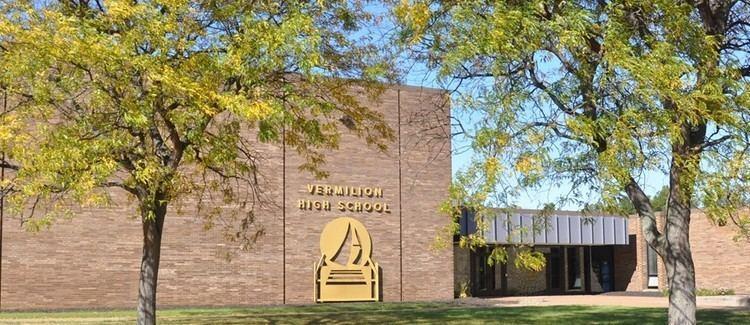
The summer preceding the 1969 school year presented a unique challenge for the Vermilion Marching Band. Upon arriving for summer band practice, they had a surprising situation. Although the new high school had finished construction, there wasn’t a football field or practice area for the band to rehearse their maneuvers. Undeterred, the band continued their music rehearsals in the new band room but had to take a bus to the old High School to practice on the field. Despite the inconvenience, the dedication day for the public to tour the new high school was a momentous occasion. The Vermilion Marching Band was called upon to perform at the event.
When the football stadium opened it did not have a restroom, only portable toilets were available for events. This oversight has been corrected. The home side of the field was the east side with a snack bar placed beneath the bleachers. A larger bleacher section has been built on the west side of the field and home and away sides have switched. The band bleachers were just past the end zone at the northern end of the field. Under Mr. Price, the band would be incorporated into the home stands. Finally, according to one article, The Vermilion Sailor Stadium is the only stadium in Northern Ohio with a tree in the endzone.
The band also required a practice field. The practice field was created behind the high school on the side closest to Sweetbriar Dr. Decades of high school and alumni performers have practiced on this field, and it echoes with past musical performances. The one hope that endures is the houses adjacent to the field will always be fans of the marching band.
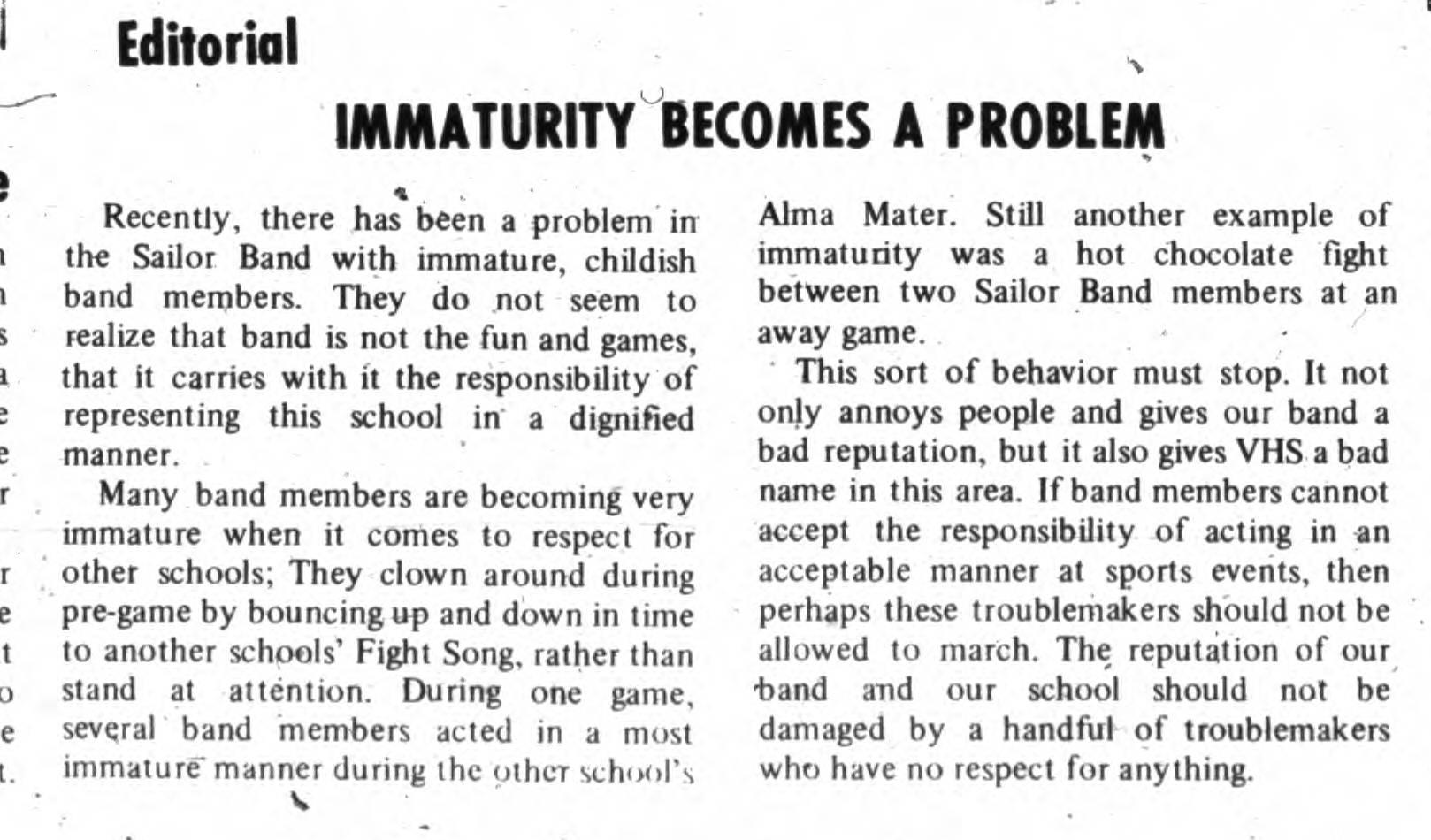
It seems the seniors of 1971 and their fellow marchers again drew the ire of the Vermilion Photojournal. Accusations stem from an away game where the band did not show the other school proper respect. Another accusation is that two band members were having a scandalous hot chocolate fight. While this story doesn’t necessarily showcase the best of the band’s history, it’s an important note. While the band does represent themselves and the school, they are still kids. No matter how disciplined the group is, on occasion, kids will still be kids.
Tales of what former marchers did when their director wasn’t looking (and sometimes when they were) have spanned the globe and broken what the editor of 1970 Vermilion Photojournal would consider any form of acceptable behavior. Some students are naturally mischievous. The anecdotes can range from humorous to scandalous. Misdeeds can attributed to the energy of youth. The class of 1971 is not unique to band members who came before or after their graduating class. They are just the ones that had an editorial written about it.
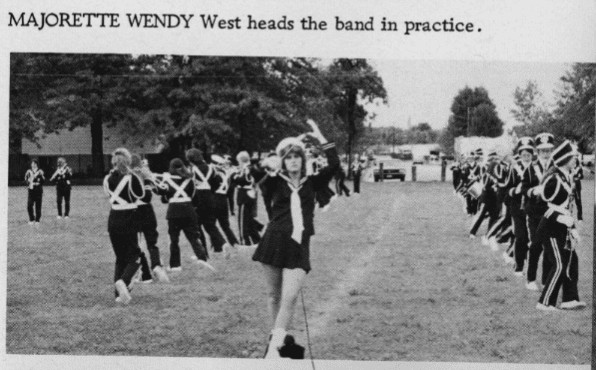
While not related to the class of 1971, on January 10, 1971, Wendy West won a twirling competition for her age group at a twirling competition in North Royalton, OH. Wendy was a sixth grader at South Street School at the time. Wendy seems to have continued her twirling career through high school. Wendy was the head majorette of the Vermilion Sailor Marching for her graduating class of 1977.

In the 1972 school year, after a five-year absence, Freshmen were once again welcomed as members of the Vermilion Marching Band. This led to a significant increase in band size, with a total of eighty members performing on the field. The following year saw even more growth, with the band expanding to one hundred members. Motivated by the band’s continued expansion and longstanding participation in band festivals, Mr. Burt and Mr. Henry collaborated to devise a plan for the following year.
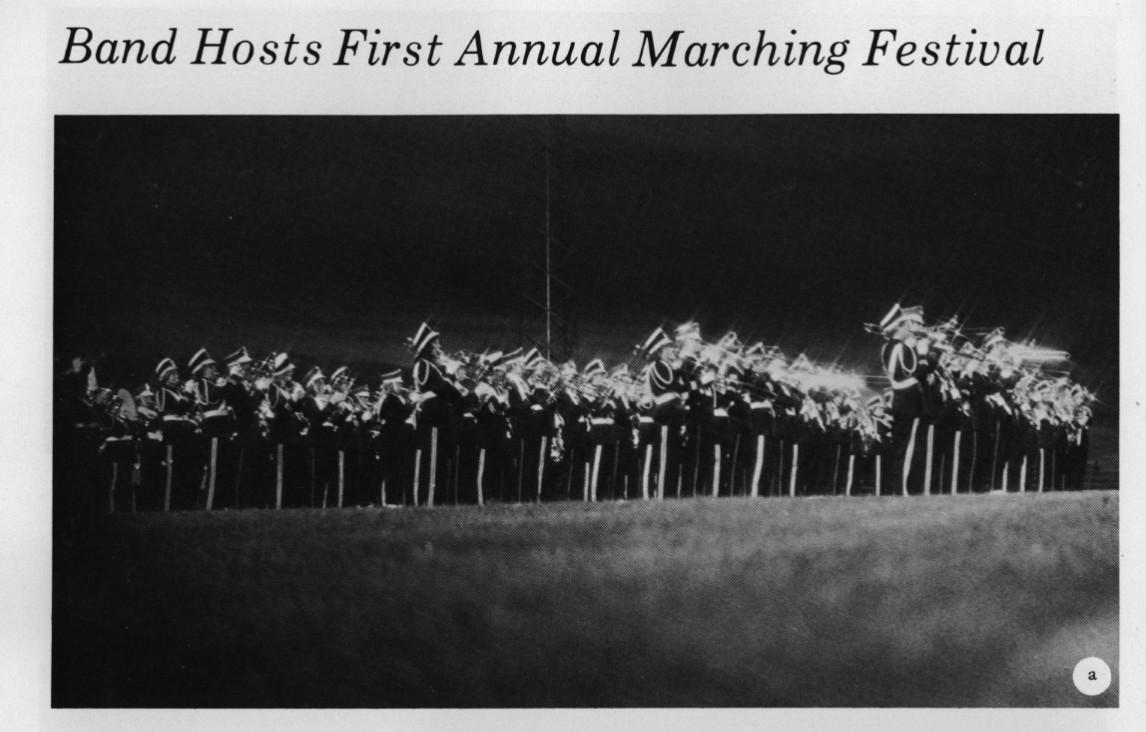
The class of 1973 was the first to march in a festival of their own. The idea began taking shape towards the end of 1971, as Mr. Burt and Mr. Henry envisioned a grand event to celebrate the band and its exceptional program. By the spring of 1972, invitations were extended to other bands, inviting them to join Vermilion to showcase their musical talents.
The inaugural festival was successful. The festival proceeds contributed to the Stadium Fund. In addition to the Vermilion band, several other bands participated, including Oberlin, Columbia Station, Clearview, Brooklyn, Copley, Anthony Wayne, and Nordonia. Each band that took part received a trophy and a commemorative patch.
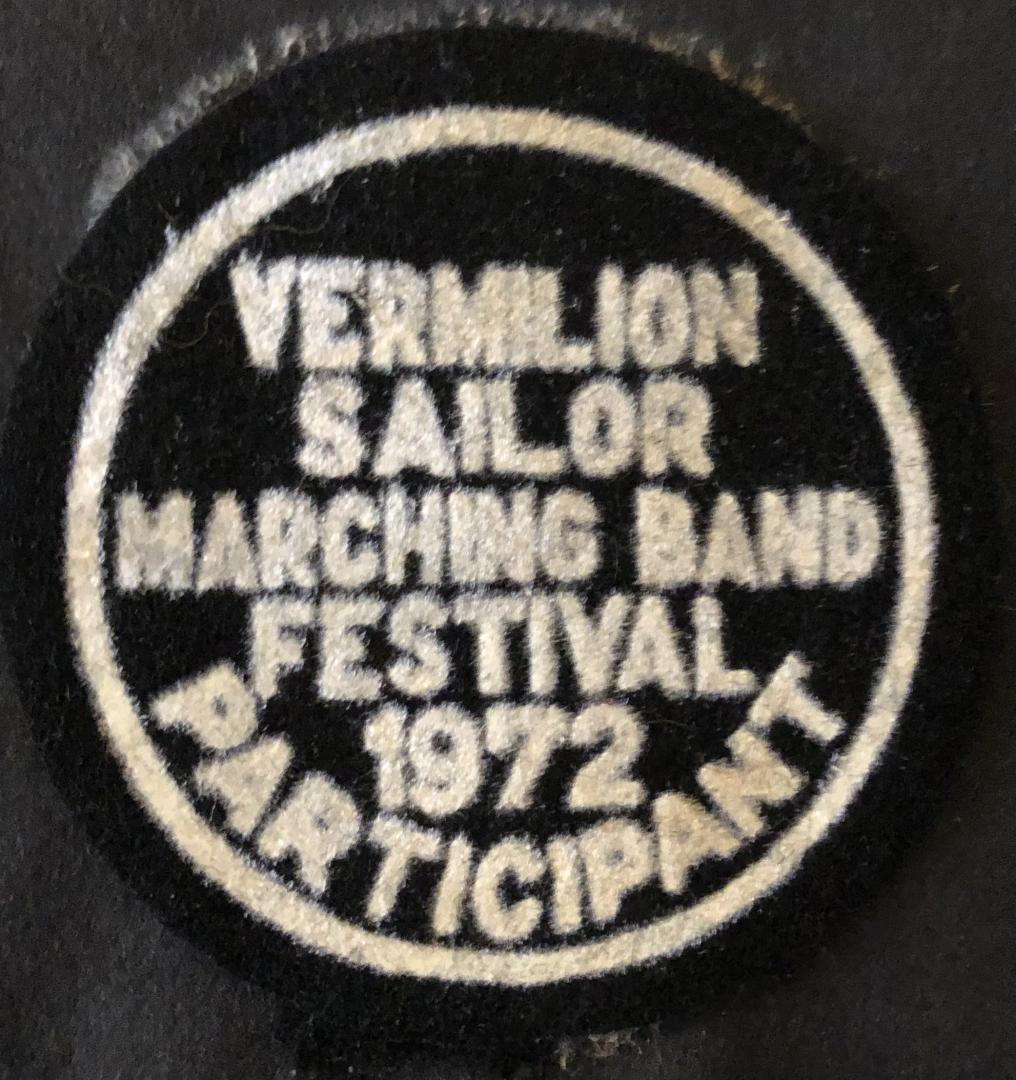
One sight that has become less common in Vermilion is the presence of The Sailor Marching Band Tag on vehicles. This oval purple sticker, adorned with yellow lettering and a yellow anchor in the center, proudly proclaimed “Vermilion Sailors.” Many band members, their families, and the community at large used to display this decal on their cars and school and student-owned instrument cases in the band room. The class of 1974 made a large impact on the tag’s reach into the community.
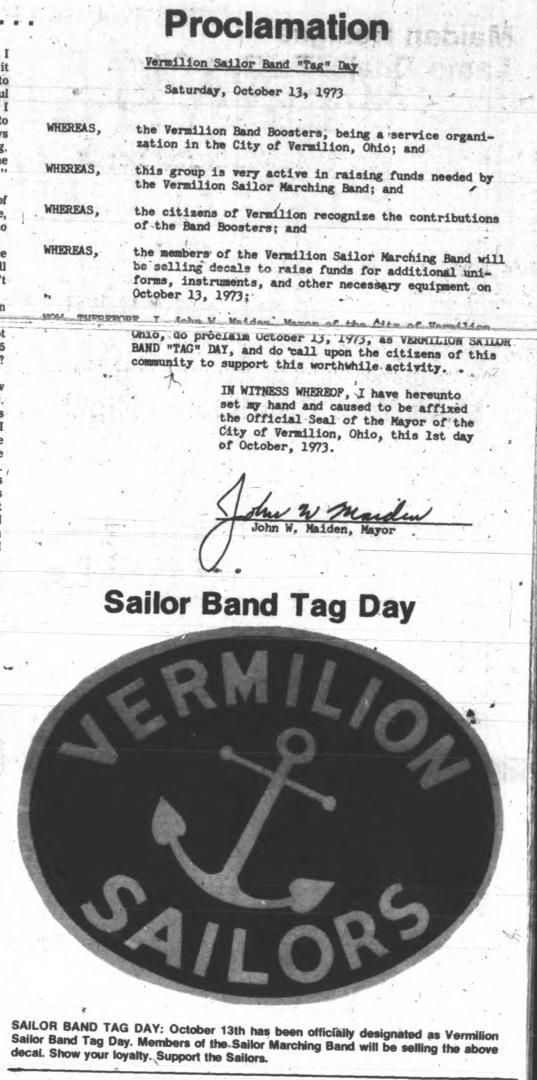
On October 13, 1973, Mayor John Maiden declared it as Vermilion Sailor Band “Tag” Day, marking the first official government holiday for the marching band. The purpose of this holiday was to recognize the Vermilion Band Boosters as a local service organization that significantly contributes to the betterment of society through its support of the Vermilion Sailor Marching Band. Citizens were encouraged to purchase the decal to support funding for the marching band. For many years, it was common to drive through town and spot these stickers proudly affixed to numerous cars, showing support for the beloved marching band.

In the 1974 school year, a new local festival kicked off in Birmingham, Ohio. It all started in 1972 when the PTA of the Firelands-Florence Township Elementary School sought fundraising opportunities. Around the same time, Dick Goddard, a local weatherman and newscaster from Channel 8, wanted to organize a festival dedicated to the woolybear and the legend of its weather-predicting abilities. This festival was to become Ohio’s equivalent of the Punxsutawney, Pennsylvania Groundhog’s Day celebration. Several cities competed to host this new festival, but ultimately Birmingham, Ohio, won.
Vermilion did not participate in the very first Woolybear Festival. The honor of being the sole marching band in attendance that year went to the Firelands Falcon Marching Band. However, in later years, the Vermilion Marching Band became actively involved.
As the festival gained popularity, it soon outgrew the small town of Birmingham by the early 1980s. The Woolybear Festival organizers considered relocating the event to accommodate the increasing attendance and activities.
In 1982, the Woolybear Festival found its new home in Vermilion and has become an annual tradition, touted as the largest one-day festival in Ohio. Vermilion can see as many as 90,000 visitors come for the festival. Because of all weekend activity, it’s referred to as Woolybear Weekend.
Woolybear Weekend stands out as one of the few occasions when band participates in in events all three days. The first is their performance at the football game, followed by Saturday’s preparations for hosting and performing at the Vermilion Sailor Marching Band Festival, renamed to The Woolybear Marching Band Festival. Additionally, the same bands that appeared at the festival were invited to perform in the last event of the weekend – Sunday’s Woolybear Festival Parade.
In 1999, another event was added to Woolybear Weekend – an appearance at Fox 8 News on the Friday morning before the Woolybear Festival. This additional appearance added to band members’ hectic schedule. Nevertheless, this annual tradition of the band’s appearance on Fox 8 News is an important part of Woolybear Weekend.
Scheduling the marching band festival on Woolybear weekend has always been hectic for Vermilion Band Directors. The Woolybear Festival coincides with the Cleveland Browns away game. This schedule creates a dilemma for the Band Director. Fox 8 waits to schedule The Woolybear Festival date after the NFL releases the season schedule. This schedule may take as late as May before it is released. The Band Director needs to know the date of the Woolybear Bear for the Band Festival invitations. Scheduling conflicts often arise for other marching bands, as they may have already committed to other events when the invitations arrive.

In recent years, the Band Festival is scheduled separately from The Woolybear Festival. While there are still instances of the Band Festival occurring on Woolybear Weekend, it is a coincidence since the Band Festival date is determined before the Woolybear Festival’s schedule is known. Due to this, the band festival has reverted to its original name, the Vermilion Sailor Marching Band Festival.

In the 1975 school year, Mr. Burt hit the milestone of conceiving and directing 200 half-time shows. This count is only for regular-season football games. By the time he retires, Mr. Burt would do over 240 of those shows. This number does not include the countless band trip performances, festival shows, playoff game shows, special appearances, or parades that he directed the Vermilion Sailor Marching Band. It also does not include the 11 Vermilion Sailor Alumni Band Shows or the Alumni Band’s 22 parade appearances. Due to his longevity, he will likely always hold the record for the number of times any other Vermilion band director has led the high school or Alumni Band members into a performance as the director.
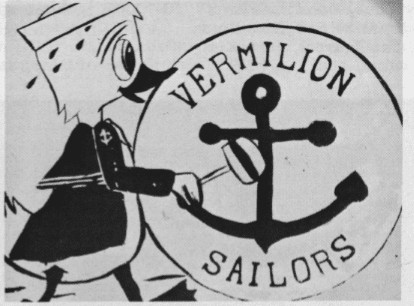
For decades students believed one origin story of The Ducky and how it came to be. Older members of the band may not be as familiar with the tale. The story is attached to the 1976-1977 season. The legend goes:
The Fall of 1976 was a particularly rainy season for the marching band. Mr. Burt told the band that with all the water the band was more like ducks than sailors because they were in the water more than on top of it. Doug Kishman, Class of 1977 and future art teacher at Vermilion High School was an art student and amused by the statement. The comment inspired Mr. Kishman to make a little cartoon character of a duck beating a bass drum. It was dubbed “The Ducky”. Eventually, he would paint The Ducky on the drumhead. Mr. Burt liked it so much that he made it the band logo.
That was the story told from the 1980s until the early 2000s. Unfortunately, it’s not quite as simple as that. The first part of the story about the duck comment and a student creating it might be true. That student was not Doug Kishman. By the time Mr. Kishman was in the band the logo was already on the uniforms and in use regularly. Mr. Kishman’s contribution is a bit more “impactful”. When Kishman arrived at the band the bass drum used the anchor logo. According to Mr. Kishman, he would play the drum so hard that he regularly would break the bass drum. Instead of adding the anchor logo back to the drumhead, he would paint The Ducky instead. The drum head was replaced multiple times, and each time with The Ducky. The Ducky just became another fixture of the drum heads. Being placed on the bass drum head cemented the logo just a little further into the band’s identity. It also inspired a legend. Upon those drum heads, the band, and all of his later students, he made quite an impact.
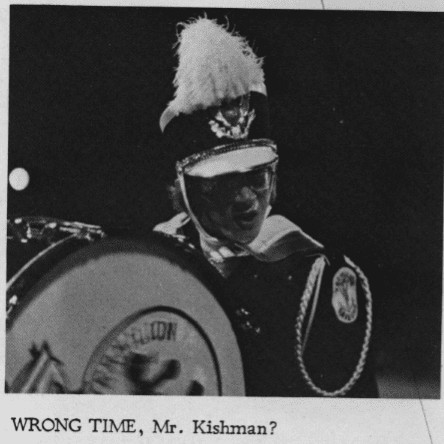
The Ducky made it onto the band uniform, official letterhead, duffle bags, jacket patches, and at least one Alumni Band member’s body as a tattoo. In the late 2000s, The Ducky was unofficially retired and disappeared from the marching band’s use. The myth states that a duck’s quack does not echo The Ducky proving that myth untrue. In the summer of 2023, the senior class organized an artwork competition to revive and modernize The Ducky logo. The good news is that The Ducky is soaring again, returning to its place in the Vermilion Marching Band’s identity.
Research has not given up the identity of The Ducky creator. In the late 1960s, it was in The Compass for many articles about the band. In an article from 1965, a picture exists of Mr. Henry with The Ducky on his jacket. That seems to be the oldest spotted evidence of The Ducky logo. The Ducky will always be available to play his bass drum and ready to go when the Vermilion Sailor Marching Band needs him.
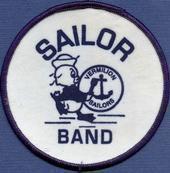
The class of 1978 may hold the record for the most band members. The marching band that season included ninety-seven members, which by itself, may not break the record. It would be a contender for the largest Vermilion marching band with just that number. What puts it over the top is the fifty-seven alternates who practiced with the band, waiting in the wings to fill a hole when needed. While there may have been only ninety-seven members on the field, the group included one hundred and fifty-four members.
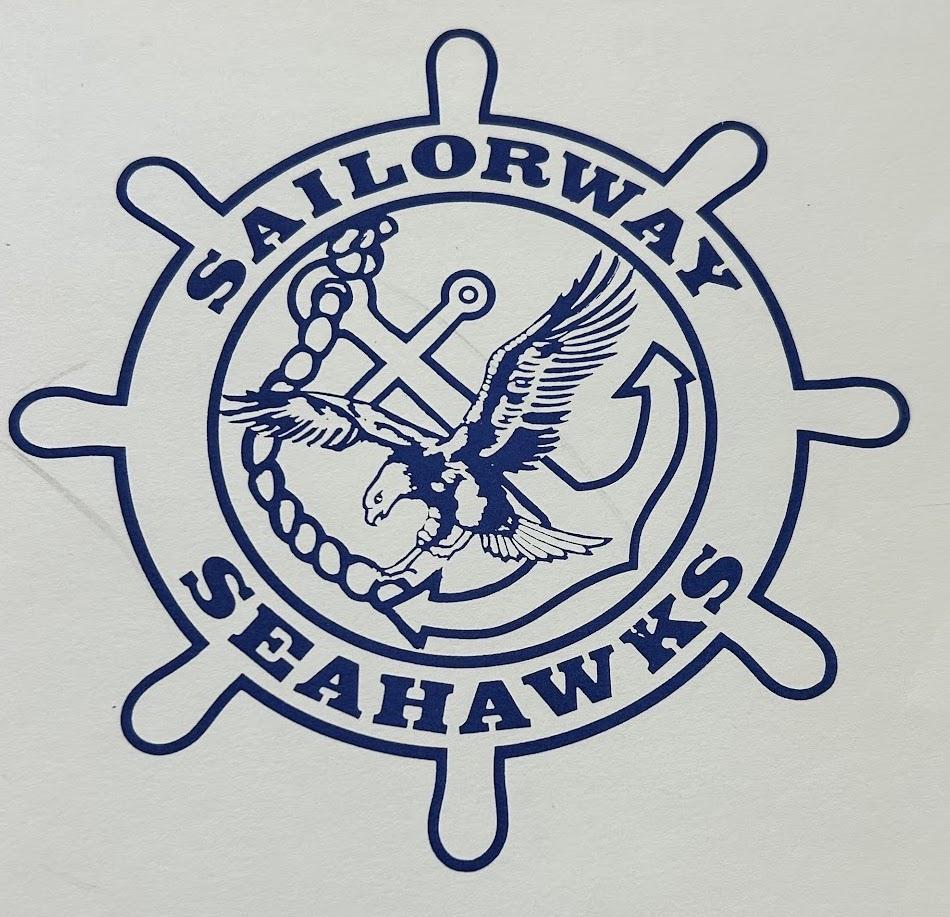
Sailorway Middle School opened in the 1978 school year. While this history covers the high school band, it would be quite the oversight to ignore mention of it. Mr. Henry was the director of middle school bands. Over the years, the school has changed mascots from the Skippers to the Seahawks. One thing has stayed identical, the Sailorway Middle School Fight Song (with a single-word lyric change). The fight song was written specifically for Sailorway Middle School by Mr. Henry. Some middle schools have school songs that are melodically identical or derivative of their school system’s high school. Some Middle schools may have songs that are more akin to Vermilion’s Alma Mater. The Sailorway Middle School is believed to be one of the few, if not only, unique fight songs written for a specific middle school.
Sailorway Middle School Fight Song
Come on and Go,
you Seahawks go,
we have a victory in sight.
We’re on the hall,
we’re on the ball,
we are the team with all the Fight, Fight, Fight!
So give a cheer for we are here
and with our banner flying high.
Our blue and white,
will proclaim that we will win another game.

Mr. Burt and Mr. Henry had started an orchestra program in the 1968 school year at the elementary school. The 1979 school year saw the orchestra return to the high school level. Sadly, this also is the final year of an orchestral program in the Vermilion School System. Additionally, Mr. Henry founded the first high school jazz band. Mr. Burt had run a stage band focusing on pop and big band music for many years. Mr. Henry’s new group would focus on jazz music.
As the 1979 school year closed out, the band members bid farewell to an era. Mr. Burt decided to step down and pass on the directing baton and marching band whistle. After twenty-four years leading the band through transformative changes, he felt it was time to embrace retirement. Although Mr. Burt briefly returned to serve as the Assistant Marching Band Director during the 1991-1992 school year, he remained a presence in the Vermilion Marching Band’s story. Leaving behind what is likely the largest impact on instrumental music education in Vermilion’s history. He also wasn’t quite finished with leaving a legacy on the band.
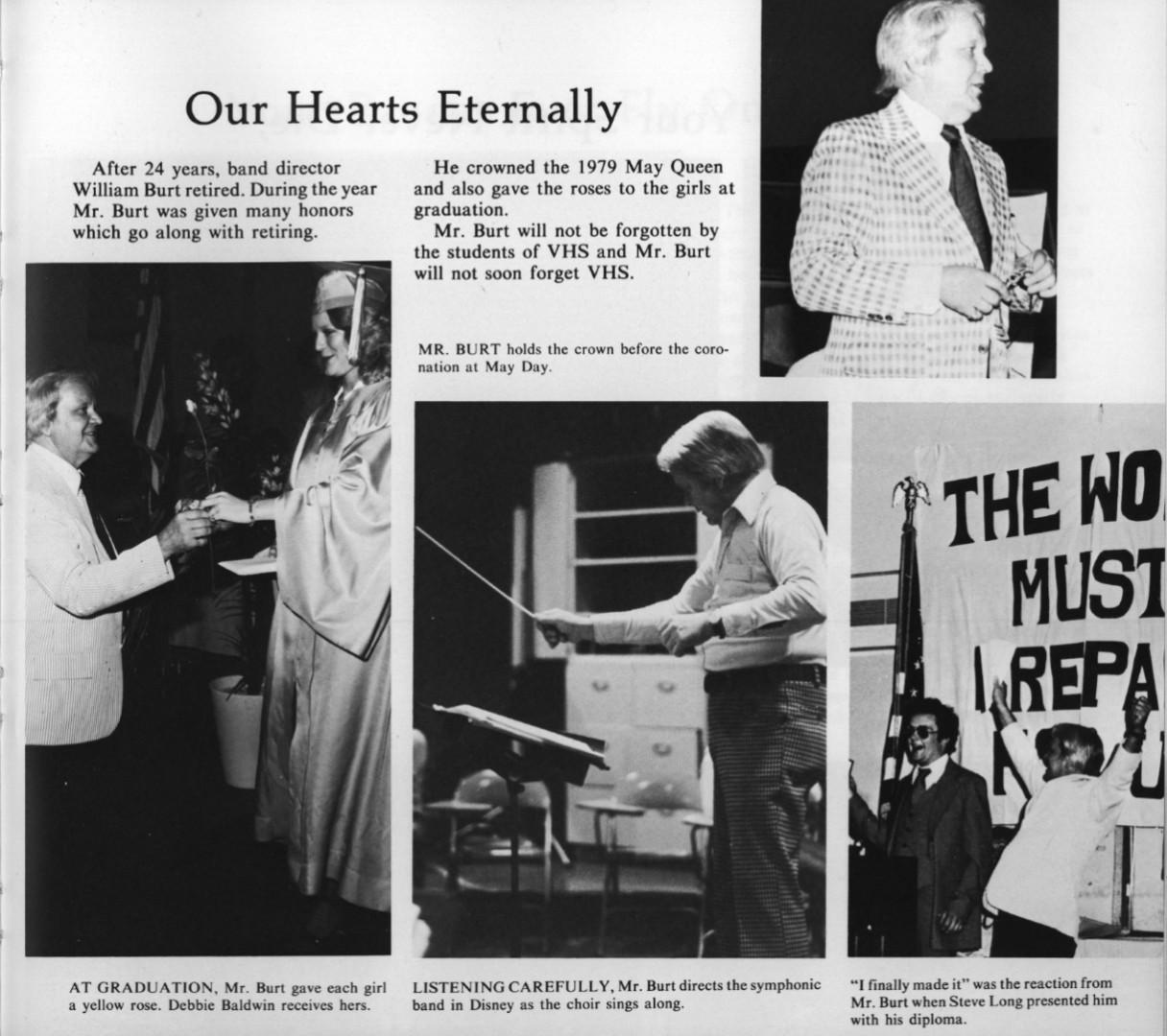
Stepping Off
The class of 1980 was under new direction by a familiar face, Mr. Henry was now the Director of the Vermilion Sailor Marching Band. This year brought two new band assistants to the band, Joseph Price and John Murphy. While a few changes would occur during his tenure, Mr. Henry and Mr. Burt held a shared belief in the band’s direction. Dawn Clark stated that her father believed the show belonged to the band and that he was just the producer. When the band was on the field, Mr. Henry was in the press box announcing the show, a job he performed during the Mr. Burt era. Whenever Mr. Henry performed the announcements for the band he would start with “Now hear this, this is your captain speaking..”

At this point the Vermilion Sailor Marching band performances or routines were broken into a formula. While the basic format of opener, middle number, and closer are used by almost every band, the breakdown on how they are performed is a little bit different in some of the specifics. With some minor tweaks, Mr. Henry followed the same specifics as Mr. Burt. The breakdown of what the band needs to know are broken down to the following aspects – Pregame, Opener, Concert Formation, Featured Number, Down In Front, Kaleidoscope Drill, Senior Number, Closer, Victory March, Parade Performance, Mass Star Spangled Banner, and Public Performances where members were not in parade squads. The Alumni band still uses some of these components in their yearly show.
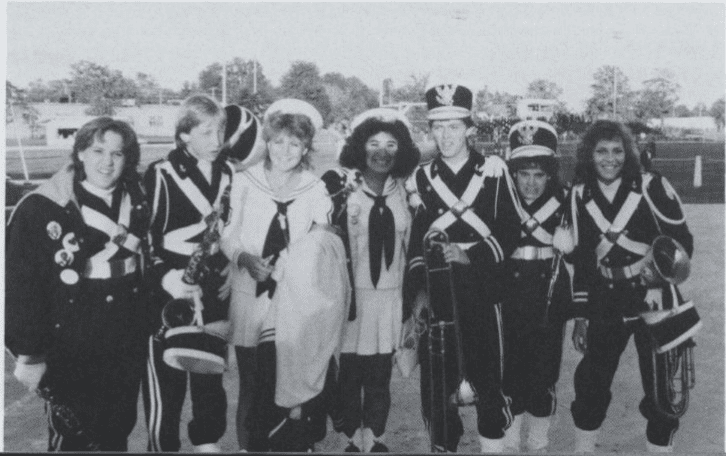
Attention, Halt, At Ease
The band when it comes to attention with a whistle call will do a small hop on their left foot, kick out their right foot, and shout “One, Two” while doing that maneuver. At this point, the band is ready to start. A different whistle call will be used to call the band to halt, this involves the band standing at attention but before moving to attention the band will do the same hop kick maneuver and shout “Step, Kick”. For being called to At Ease, the director will state “Band, At Ease” – the band will put out they’ll left leg to take a wide stance while saying “One”. While later directors have done some adjustments to these manuevers, the Vermilion Alumni Band still uses the same calls
Pregame
Marching to the stadium involves the band congregating behind the school into their traveling squads for home football games and the local band festival. Once they are together they play cadence as they march to the football stadium letting the sound echo in the air. Upon arriving at the stadium the band marches in front of the home stands playing Fight Song and Anchors Aweigh. Then head to the endzone to line up for pregame formations.
The pregame formation has been adjusted over the years, and regardless of these changes, the band always enters the field from the south endzone. The band expands formation onto the field while playing the pregame cadence.
Mass Star Spangled Banner
While it has happened for away band festivals such as the Anthony Wayne festival, the most common usage for the mass playing of the Star Spangled Banner for the band is at the Vermilion Band Festival. For the mass Star Spangled Banner all bands that perform the song in the same key are invited on the field to perform it with the Vermilion Sailor Band. At times at the festival there have been more than six bands playing in unison. In more recent years, as bands have moved onto different arrangements of the song, it has been the Vermilion Sailor Marching Band and the Vermilion Sailor Alumni Band on the field for the performance.
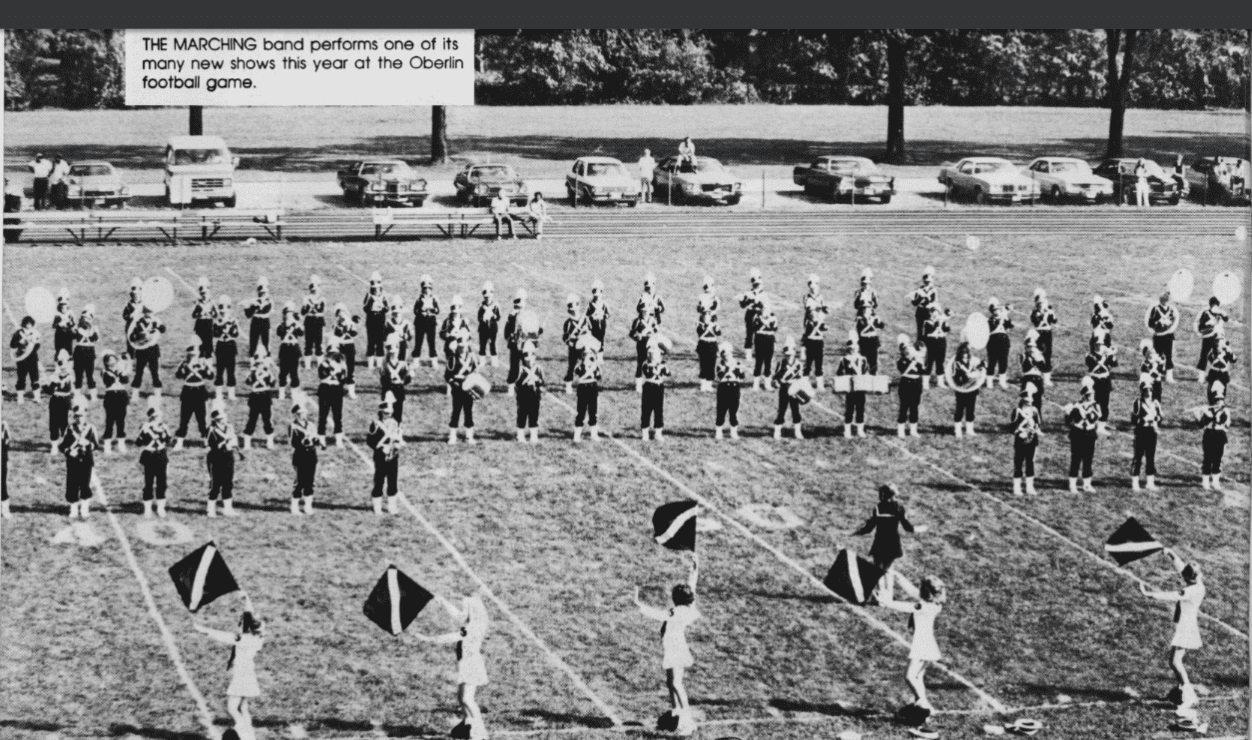
Concert Formation
Concert Formation is the band’s reset spot between numbers. Most openers are designed to get the band in the correct spot on the field for concert formation. Each marcher should end up in the same concert formation spot for every single drill. The current iteration of the band uses a more fluid approach of form shaping where their spot between songs may be more different from one show to another. The alumni band still performs using the traditional concert formation.
Opener
Openers are the first song of the halftime or festival show. Almost all openers involve the band lining up in the endzone, the away sideline, or in a corner with some members on the sideline and some in the endzone. Depending on the number and if it calls for soloists or auxiliary groups to have a different routine from the rest of the band, there is an occasional entrance from the home sidelines. It has happened in a few routines, but it is extremely rare for the band to enter the field from the home sideline.
Before the song is played the announcer opens with a statement and the band plays the first bar of Anchors Aweigh fanfares. Mr. Henry, when he announced the band would open with “Now hear this, this is your captain speaking”. After the first fanfare, the band be introduced by the announcer and play the second round of fanfares. The announcer will then list the names of the staff involved for the band, before the final set off fanfares. For the last two two notes of the third fanfare, the band sticks their left foot in of them about 1-2 feet on the field for the first note and bows while playing the second note before returning upright. The announcer then states the song the band will be performing and the head majorette directs them onto the field.
As the song concludes the band should be in concert formation. As the last note ends the song, the band gives the audience a greeting. The band members will throw out their left leg spreading their stance wide with their arms outstretched above their heads as they hold their instruments in their right hand as they shot “Hi!”. After which they bring their left leg back and stand at attention. Normally for the band, this means that instruments were up and ready to play the next number.
Middle Number
Middle numbers are any number performed between an opener or closer. Middle numbers have fewer static rules than an opener or closer because there are variations depending on the type of middle number. Standard halftime shows may include a single middle number. In contrast, a festival or competition show may include up to four or five middle numbers focusing on different aspects of the marching band.
A very rare middle number not included below is the performance dedicated to the away stands. The band will turn around from the home stands and play a number directed at the away stands. This number is almost exclusively used in festival performances.
Down in Front
The Down in Front middle number involves the band resetting closer to the home sidelines in an arched formation separating different instrumental groups. The song and layout are normally used for songs involving more of a big band sound. After a Down in Front song concludes, the band returns to their concert formations.
Featured Group
Featured group middle numbers are songs used to feature a specific group within the band during the song. The group may be majorettes, color guards, or a specific instrumental ensemble. While the featured group may include a special performance, the remaining band performers will play music in concert formation.
Kaleidoscope Drill
Kaleidoscope Drills involve the band performing maneuvers in a middle number where they can expand and collapse. This performance will look like the expanding and contracting of shapes that someone may witness while looking through a kaleidoscope. This middle number type starts and ends with the band in concert formation.
Senior Song
The Senior Song performance is the highlight of the Senior Show. This middle number is performed at the last home game of the season. Senior band members leave concert formation and the announcer lists all their names, while band members will wave, bow, or acknowledge their name being announced. The seniors then perform a song with just their members while the remaining band watches without playing. After the song the seniors then return to concert formation to perform the closer of the Senior Show.
Eighth Grade Night
The 1992 school year brought a new middle performance to the band, Eighth Grade Night. Eighth Grade Night involves members of the middle school performing a number with the high school marching band. Middle School students will come in from the sideline after an opener and stand with the high school band in concert formation. After the song, the eighth graders would leave the field. This activity has evolved over the years and is now Future Sailors Night. It is as much of a celebration of these younger performers as it is a recruitment tool to get future members excited to join the marching band.
Closer
The Closer is the last song the band plays before exiting the field. It involves a routine designed to take the band from concert formation to either a sideline or endzone where they can gracefully exit the field. Upon conclusion of the song, band members left feet takes the last step and both feet stay in place at attention. The band will then play all three Anchor’s Aweigh Fanfares in succession. This announces their leaving the field in the same manner that the opening fanfares heralded their arrival. At the conclusion the band will perform a bow or a series of bows depending on how the band is arranged at the conclusion of the song.
After the bows, the band will then pinwheel out into squads of four as the band cadence is played. After the band is pinwheeled out they mark time as they prepare to get the main part of the cadence when the band performs a high step for sixteen beats, after which they march off the field.
In The Stands
Throughout the football game, during times when the ball is not in play, the band will play upbeat songs from the stands to keep the crowd engaged. Depending on the length of time available, the band will play something short like “Go Team Go” or a full number from their repertoire. Every time the Sailor Football scores, the band will perform the Fight Song/Anchor’s Aweigh arrangement.
Victory March
After the band waits anxiously for the final time of the game to run out, upon a Sailor victory the band turns their hats to celebrate the win. They then play the Alma Mater directed at the home stands before going off and performing a victory march across the football field continuing out of the stadium.
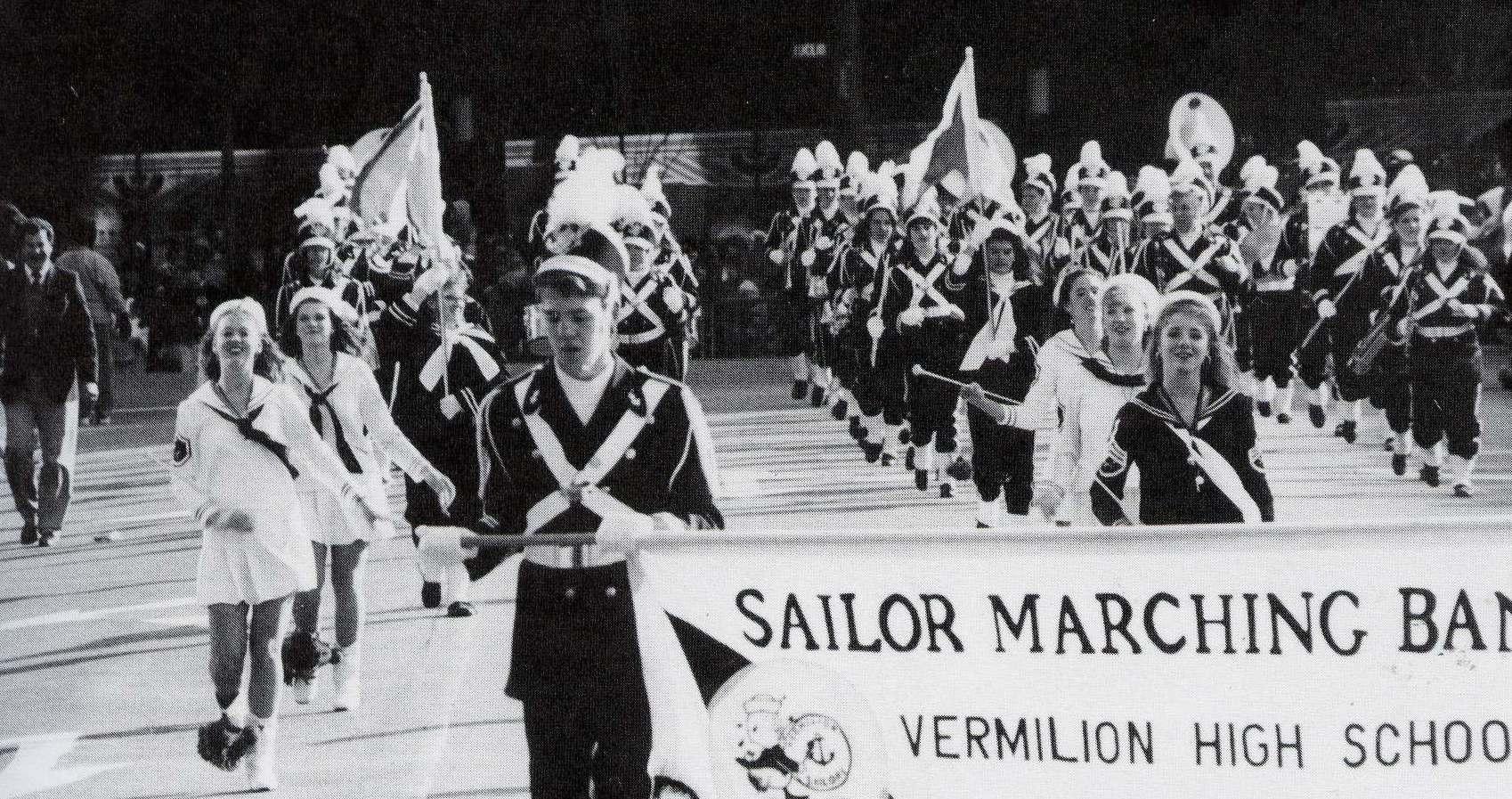
Parades
The Vermilion Sailor Marching Band has performed in hundreds of parades of the year. Ranging from Decoration Day, Memorial Day, Fish Festival, Woolybear Festival, Cedar Point, The Cleveland Christmas Parade to smaller less frequent parade appeances, the Sailors always marched with pride. Parade formation was dependent on the size of the road the Vermilion Sailor Marching Band performed upon and the size of the size of the band. The most common formation is marching four across with four steps between each member. This spans the width normal two lane road. The music that is performed includes Fight Song/Anchors Aweigh and upbeat songs that the band has had memorized. In the very front of the bands their is a banner announcing the band name as they march through the parade.
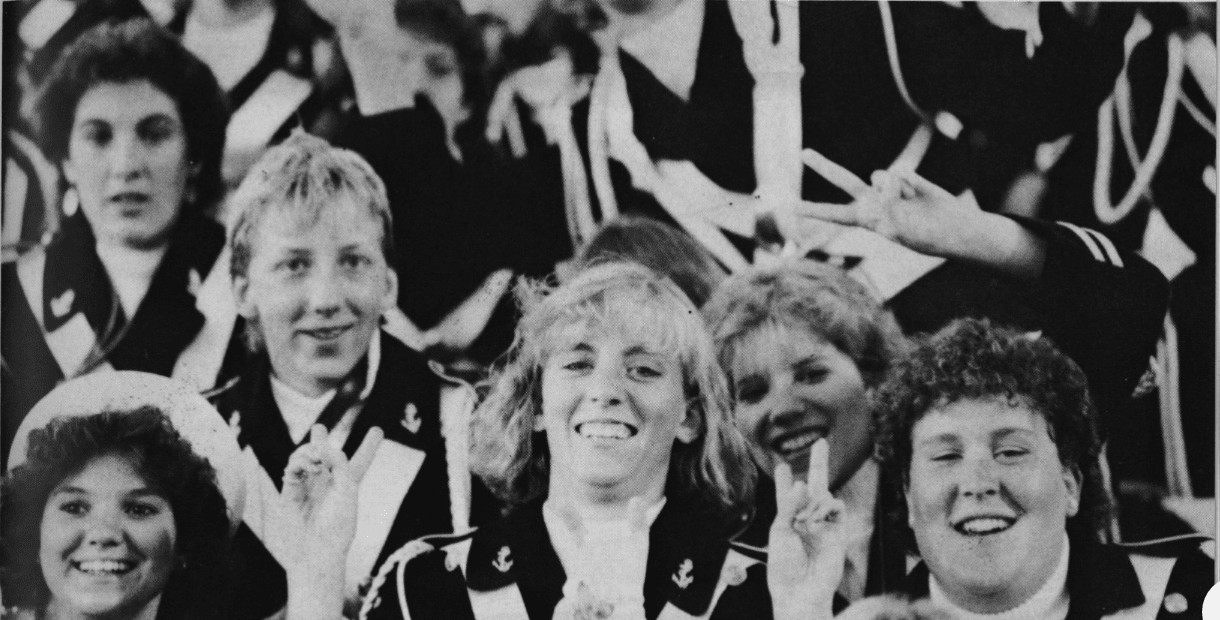
Documentation is scarce on when the practice started or when it ended but as part of the 1980 school year, first-year marchers were given a certificate to redeem for a varsity sweater or varsity band jacket that they could add their varsity letter to after their second year of marching. The end-of-season gifts were as follows, first-year marchers received their jackets, second-year marchers received their letters, third-year marchers received a band pin, and fourth-year marchers received their band pictures.
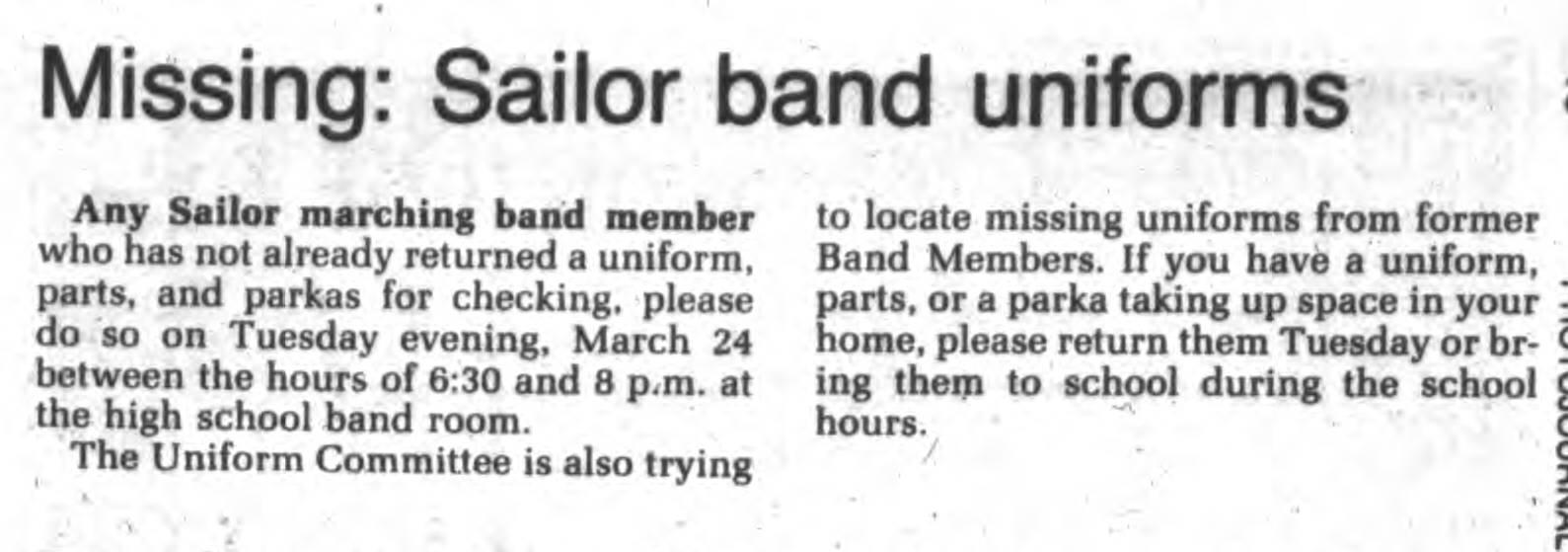
The 1980 school year started a new painful tradition for the band directors, tracking down missing uniforms. Part of this issue was caused by the band marching in the Fish Festival Parade, which occurs after the school year ends. Members would forget to drop off their uniform at the end of the performance, and then move on with their lives forgetting to return it as it it lived in their closets. To combat this, the directors started an annual plea to the community in the Vermilion Photojournal asking for the return of the missing uniforms. It’s not quite documented how many uniforms are still hanging in closets to this day.
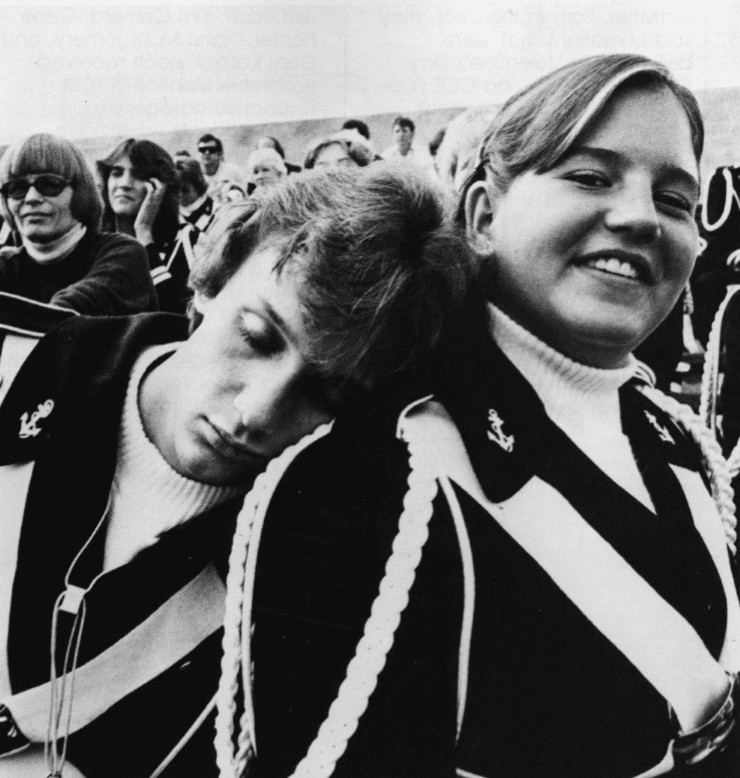
The final big thing for the 1980 school year is the Ida Blue Streak Marching Band. They traveled from Michigan and stayed the evening overnight with Blue Streak members staying at accommodating band members’ houses. This visiting band scenario continued for almost two decades, Anthony Wayne Marching Generals (first visiting in the 1986 school year) and Ida would be the bands that had this visitation to perform at the Vermilion Sailor Marching Band Festival. After the festival the visiting and Sailor bands would go to a band party hosted by a band member until heading home to their respective homes for the night. The next day Sailor Band Parents would bring back the visiting band members to the high school to load the buses and take their long trip home. After the 1982 Band Festival, the visiting band would normally stay and march in the Woolybear Festival parade when the festival moved to Vermilion.
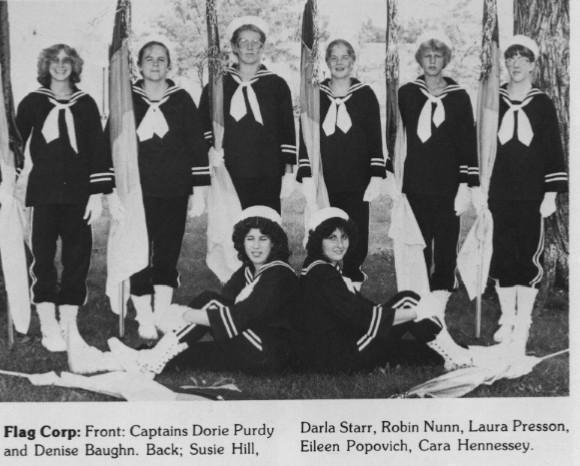
One of the first large changes that arrived in the band for the class of 1981 was a new Flag Corp, eventually called the Color Guard. Lisa Panebianco, formerly a member of the Bowling Green State University Marching Band, was hired as the advisor of the Color Guard. This band auxiliary unit would last until the 1986 school year, at which point the Color Guard was disbanded.
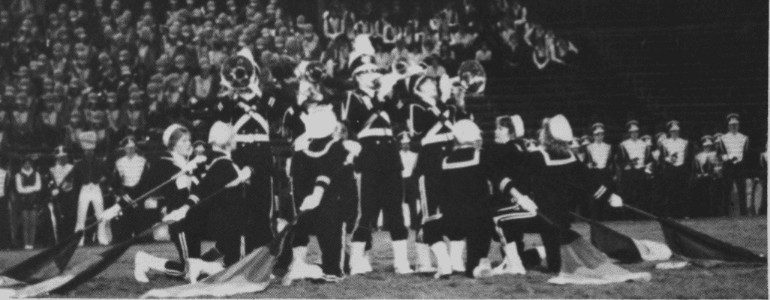
The Class of 1981 experienced the first major health crisis in the band’s history. On a scorching September 20, 1980, with temperatures soaring, the band performed during halftime at Oberlin College. After their performance, the buses embarked on their journey to Massillon for the evening band festival. To combat the heat of September, the band members diligently drank copious amounts of water throughout the day.
The relentless heat and the overall exhaustion of the day didn’t take their toll until after the band had completed their festival show. Shortly following their performance, a wave of illness and fainting swept through the band members. As a result, many band members were rushed to local hospitals, where they received much-needed fluids and IV treatments to rehydrate.
In the end, two buses loaded with band members returned to Vermilion, albeit two hours later than originally planned, arriving at 2 AM. Another bus collected thirty band members who had recovered from three different hospitals; this bus finally arrived at 4 AM. To commemorate this memorable event, band members created t-shirts proudly declaring, “I Survived Massillon 1980.”
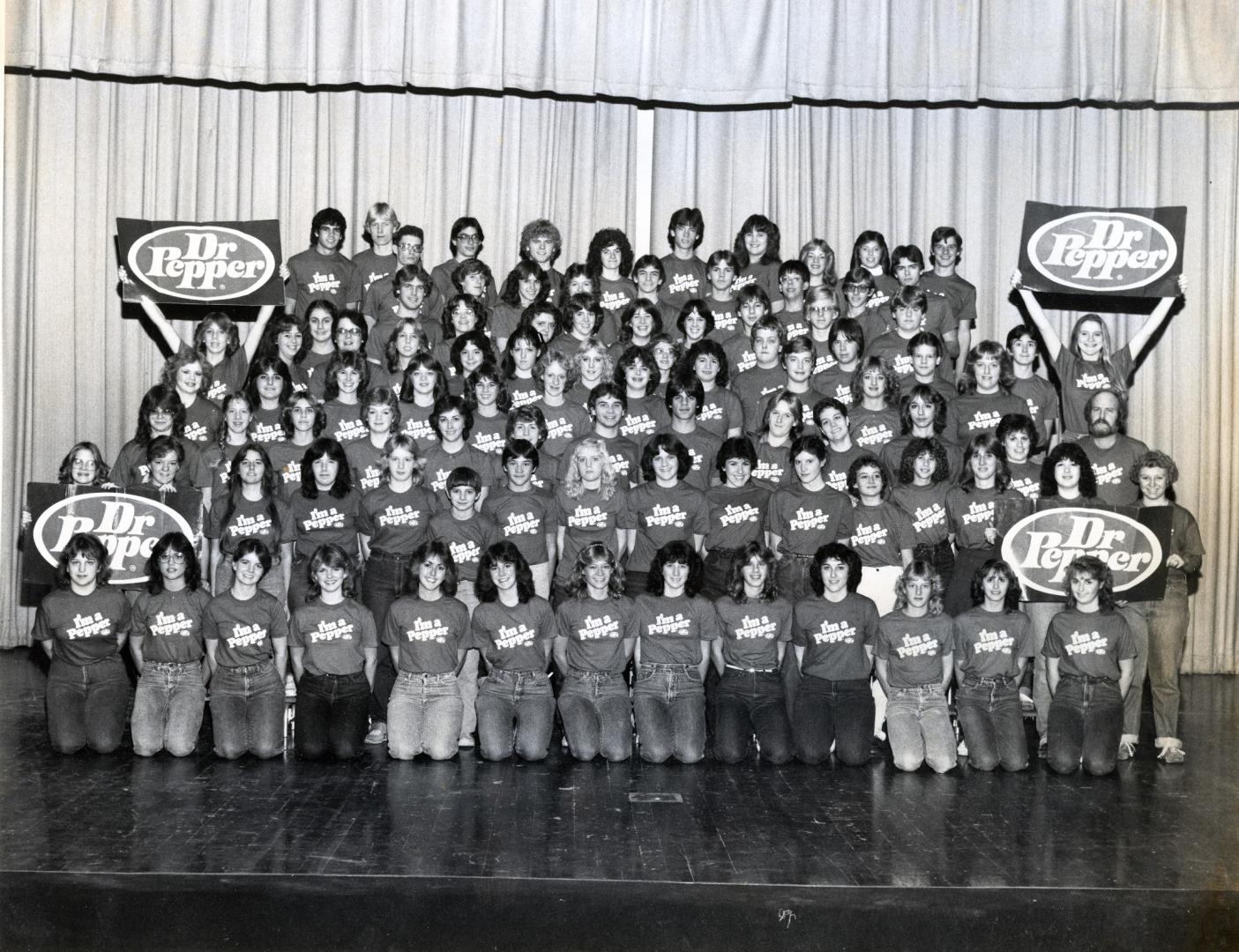
One new method of fundraising that Mr. Henry used was corporate sponsorship. The band would partner with a company and offer advertising or synergy with a performance. Two of these sponsorships were with soft drink companies Dr. Pepper and Coca-Cola and separate years. The Coca-Cola sponsorship included the band performing “Coke is It” at the end of a show, while the majorettes would go into the bleachers handing out bottles of coke. The alumni band would perform a show in tribute to this original sponsorship years later.
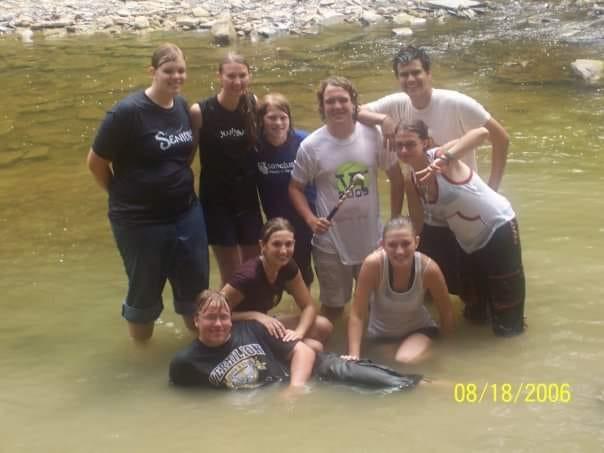
The Band Picnic is currently one without a distinct year. Band members from the 1970s do not seem to remember it occurring. The oldest memories seem to date to the early 1980s. At times it was considered part of the initiation for first year marchers into the band before it became more organized. On the last day of band camp, it was traditional to end the day early. All band members would attend a non-school supervised and non-school sanctioned optional potluck picnic at Mill Hollow. Depending on the grade of the band member was based on what they brought to the park.
As part of the picnic activities, the Seniors would take first-year marchers into the Vermilion River and baptize them into the band. The seniors would give a band prayer and end it with “The Father, Son, and Mr. Henry”. Nothing was held against those band members who did not attend – just an annual tradition. However, if a member attended and refused the ceremony, they were dragged in and forced to do it.
A similar initiation started in the 1994 school year which involved duct-taping freshmen to various objects. It seems in later years there was a combination of duct-taping and dragging for baptism in the Vermilion River routine for those who resisted the baptism. Eventually, in the late 1990s, this stopped being an unofficial tradition of students by themselves and included the parents and chaperones as part of a band-sanctioned event. While this was likely done to curb some of the behavior, former members have stated that parents would help catch their own children for the ceremony.
Things mature and grow over time, and with maturity, there is always an attempt to remove immature antics or behavior society has grown past accepting as appropriate. As chaperones arrived and the kids were watched, there was less dragging and more optional voluntary baptism of new members. By the 2009 school year, the director was actively discouraging the practice. It is unlikely today that hazing of any sort, as it used to exist, is happening at a band-sanctioned event today.
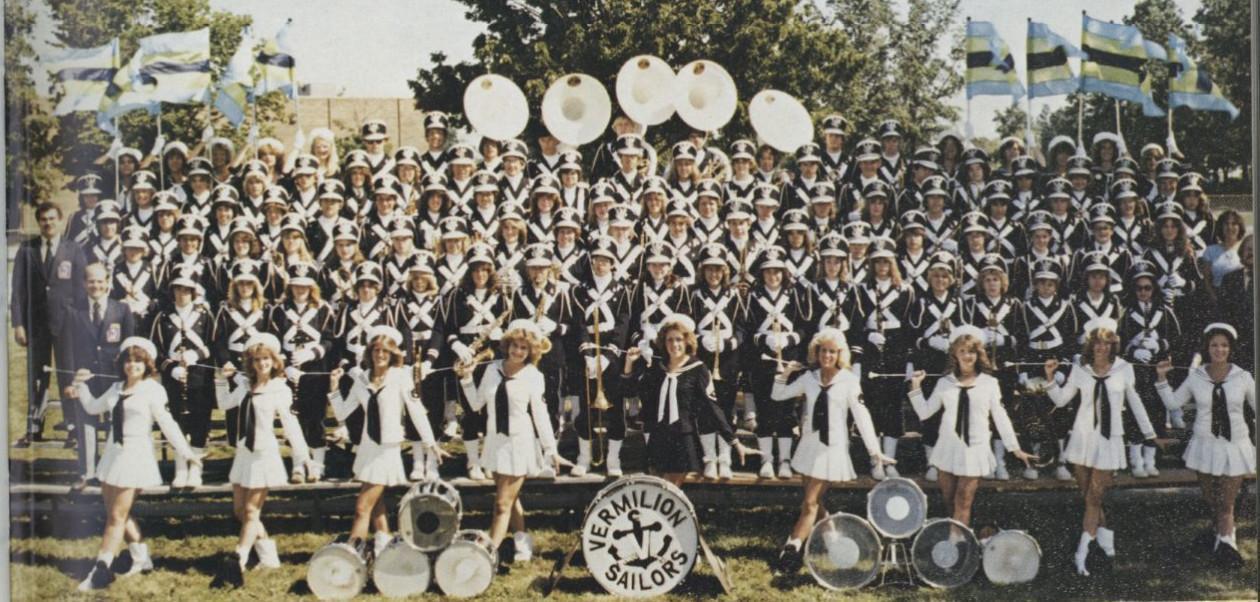
The marching band directors of the Lakeland Conference voted to make changes to the pregame performance of all marching bands within the conference. Traditionally, the marching band would face the flag while performing the Star Spangled Banner. The vote was 5-1 in favor of the change with one vote being absent. The dissenting vote was Mr. Henry. Mr. Henry stated, “Many of the smaller bands feel that their sound does not project well enough and feel they must face the homestand. If the crowds were singing as they’re supposed to, then none of the bands would have to worry about the sound.“
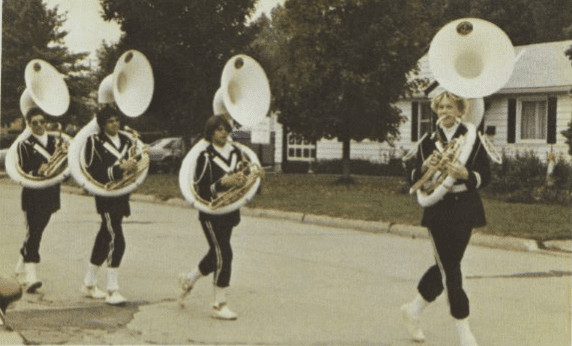
The motto of “swing until you die” arrived for the tubas in the 1983 school year. The tuba squad, consisting of Marshall Micheals, John Banta, Ed Taylor, and Joe Lundy would change the purposes of the tuba squad in the band for years to come. This is the time when the tuba swing was introduced while marching and the tuba chase was added to the band. How did this come to be, well it was the squad themselves that introduced it.
Mr. Michaels explained the change, “We copied the circling and follow the leader routine off the University of Toledo’s marching band. It was my idea though for doing the Broadway step, spinning around, and walking backward, although the others helped refine it. Mr. Henry let us do just about anything we want, just as long as we don’t get too far from the band. It’s a proven fact that a band is a better showing band when its tubas swing and do routines than a band that just has tubas and does nothing. Those bands are boring to watch. I think we’re the only band in the conference that does something with tubas.“
This change would last for years and still makes occasional appearances in the alumni band performance. It also shows changes to what makes sections unique to the marching band. At this time the band had two auxiliary groups, majorettes and color guard. The routine of the tuba squad created an unofficial third auxiliary group within the band with a unique flavor.
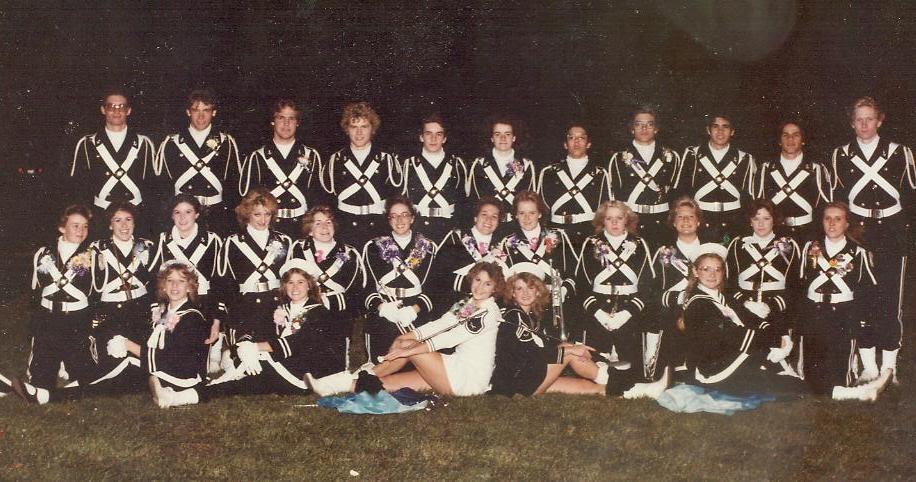
Additionally, for the 1983 school year, there was a modification to the Victory March at the end of the game. The band would form an anchor with the tubas in the lead as they marched across the field celebrating a Vermilion Sailor victory.
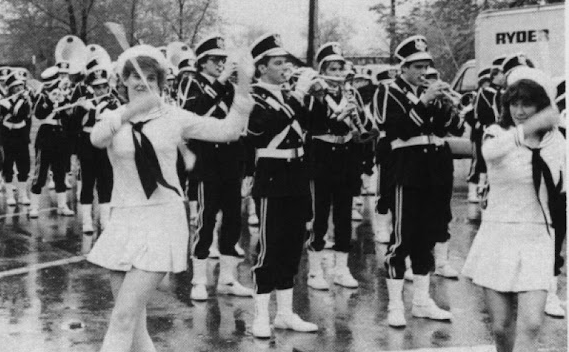
The Class of 1984 had a special reason to celebrate when one of their own, Tim Farley, became part of a select group of 3,600 Americans chosen by the Olympics to participate in the Olympic Torch relay. This relay covered a vast distance, spanning thirty-three states from New York City to Los Angeles. Tim’s leg of the journey brought him through Vermilion, where, despite the rainy weather, the town and the Vermilion Sailor Marching Band were there to greet him
In Tim Farley’s own words about the event:
As I started my run, I thought of the length of the route, the many people that would be crowding the street, and, of course, the cold, rainy weather. But as I got going, those thoughts immediately vanished, and I was well on my way to “cloud 9”. I felt as though I could have run 100 miles instead of half of one. This could be due to the huge adrenalin flow, but I think it was from the though of being part of an entourage of runners representing their communities and, most of all, America! The thought is motivating and overwhelming.
What made me most proud of my community (Vermilion) was the vast turnout of people, even in the cold wet climate, hoping to see and experience a once-in-a-lifetime event. The Olympic Torch Relay Committee said, “Vermilion had the largest turn-out ratio wise to the size of the community. That’s including New York.
The feeling I experienced that Sunday (May 20, 1984) will undoubtedly live forever with me. It wouldn’t have been possible without the spirit and patriotism that Vermilion possesses and proved.
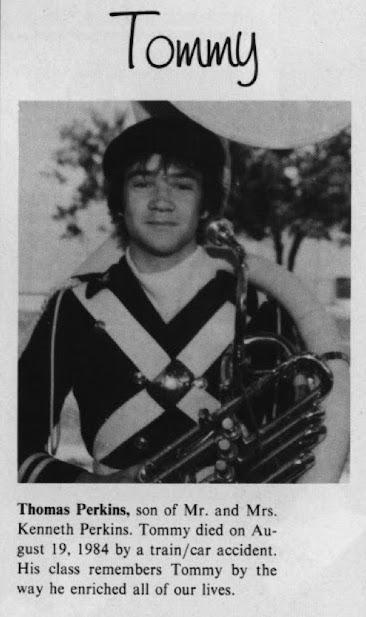
For many marchers over the last forty years, Thomas “Tommy” Perkins is a picture in the Vermilion Sailor Marching Band trophy case. For the classes of 1985 and 1986, he was a classmate and friend. On August 19, 1984 Thomas was heading to Saint Mary’s in Vermilion for 8:00 mass when he was in a car accident with a train on Risden Road. Thomas was to be a junior in the high school that upcoming school year. The band dedicated all of its performances in the upcoming season to Thomas. Thomas was in the tuba squad, so in his honor that year, one of the bands normally white tubas was painted black to mark the absence of him on the field. Thomas’s parents set up a scholarship in his name for future Vermilion Sailor Marching Band members. Finally, fellow Junior Patrick O’Leary designated a tree and installed a plaque in Thomas’s honor at Molly’s Vineyard.
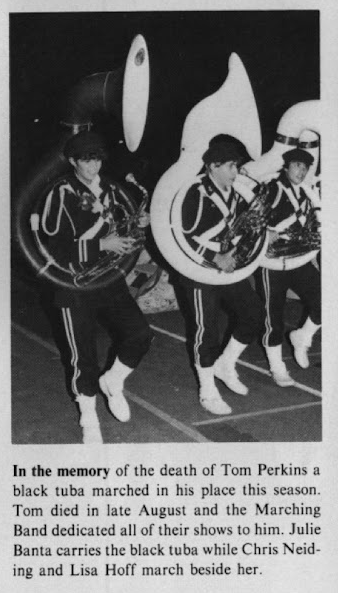
1985 begins a brand new branch in the Vermilion Sailor Marching Band family, the Vermilion Sailor Alumni Band is born. There are two main stories of how the Alumni Band came into being. Each interesting in their own revision, and each likely missing part of the overall picture. One thing to note that inspiration for the Vermilion Sailor Alumni Band was likely seeded in the back of Mr. Burt’s mind when he witnessed the Massilon Alumni Band perform at the Massilon Band Festival in 1960.
The first and most retold story occurs in the backyard of Mr. Burt. During a gathering of former students in his backyard with his semi-regular gatherings of former students, Mr. Burt told them that it would be great to go out there and do it “one more time”. Without hesitation the then grown students thought it would be great to get out there and show the high school students how it should be done. Mr. Burt with the charm and flair of Professor Harold Hill gathered his students and was ready to have them march out on the field with seventy-six trombones leading the big parade at the band festival just a couple months later.
The second story involves a newspaper article from 1985, in which Mr. Henry discusses the idea with a reporter that it was his dream to get an alumni band formed. That he had been working on the effort for several years at this point and discussed it with the band boosters in an attempt to make it a reality. In 1985 Mr. Henry stated he was still in the planning stages but wanted feedback from the community before making any commitments.
The answer likely is somewhere in the middle. A logical guess is that it was concocted by both Mr. Henry and Mr. Burt over a meal at some point talking about the good old days when they worked together. Since we know it had been a few years of discussion this might even go back to 1980 when Mr. Burt had to watch the band he built into a force go on without him leading it, it still had great relationships and regular get togethers with former students, but he wasn’t getting to lead a show. These discussions then grew as Mr. Henry looked at the feasibility from the band boosters on making this a reality. Once the backend was worked out, Mr. Burt likely brought it up to his former students. On December 29, 1985 the Vermilion Sailor Alumni Band held it’s first official meeting at Trinity Lutheran Church.
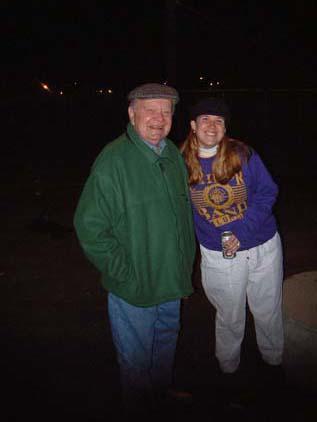
The Alumni Band was formalized very early on, the first few years they would advertise in the Vermilion Photojournal for old members. Phone calls were made to former students to get a commitment, and give them the sales pitch of why they they should do it. For anyone they didn’t reach on the phone, hundreds of letters went out to former students either at their current address if known or their parent’s home address. Weeks of work went into this effort to get the band formed each year. Mr. Burt knew he couldn’t do it alone, so band officers were elected.
The band officer roles included an Alumni Band President, Alumni Band Secretary, and an Alumni Band Treasurer. A bank account was open from donated funds of former members to aid in the recruiting efforts of the band.
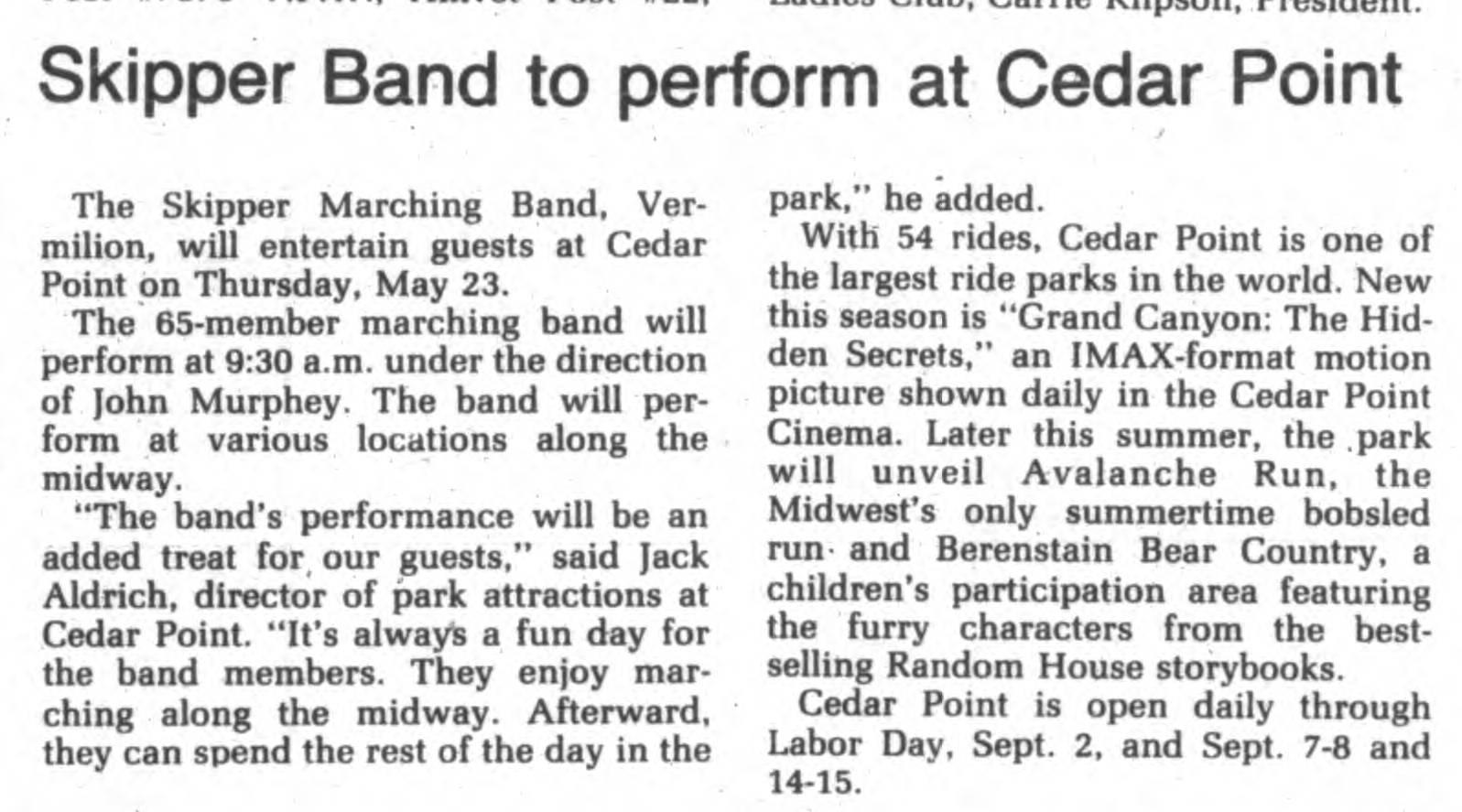
By the mid-1980s the Vermilion Sailor Marching Band wasn’t the only local band performing at Cedar Point. While the many local high schools would send their marching to Cedar Point to perform, Vermilion might be one of the first to send their middle school band to the park for a performance. For a few years the Sailorway Skipper Marching Band would make an annual trek to perform at the park.
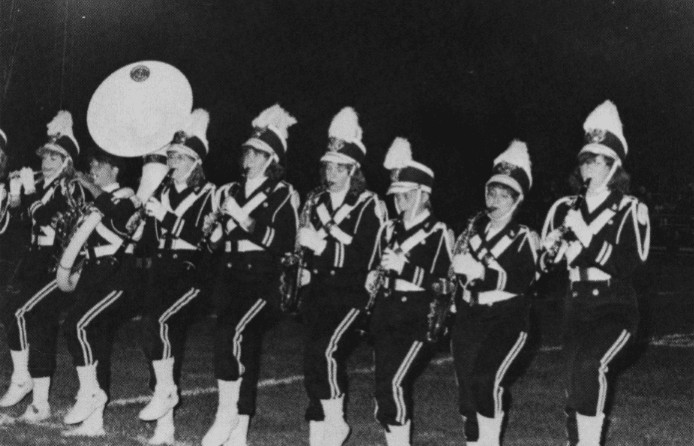
Sophomore of the 1986 school year, Janet Kurtz, was selected to perform as a member of the Spirit of America marching band. Janet would go to Geneva, Switzerland to perform as the group represented America in a 4th of July celebration. The band’s tour also included stops in Germany, England, France, Austria, Luxemburg, Belgium, and Holland over twenty days.
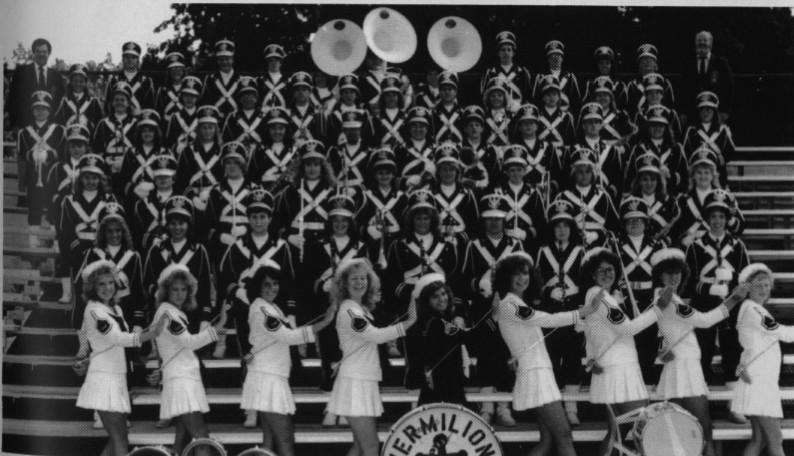
By the 1980s the Vemilion Band’s annual fundraiser of magazine sales that started in 1956 stopped being a tradition. New things were needed to raise funds for the band. One smaller annual event was the band car wash. This has occurred at different venues in town such as Erie Electronics and Burger King. For a larger fundraiser, the class of 1988 teamed up with Steakhouse Outlets to offer an annual meat sale. This would be the largest fundraiser of the year for many years of band members.
The class of 1988 added a new annual event in November 1987 with its appearance at the Channel 8 Christmas Parade through downtown Cleveland. This became an annual event that lasted until the band’s last appearance in November 2003. 1995 is the only year the band missed that parade in the interim years. Due to not normally having seasonal Christmas music, the band added March of the Toys and Feliz Navidad to its collection of marching music.
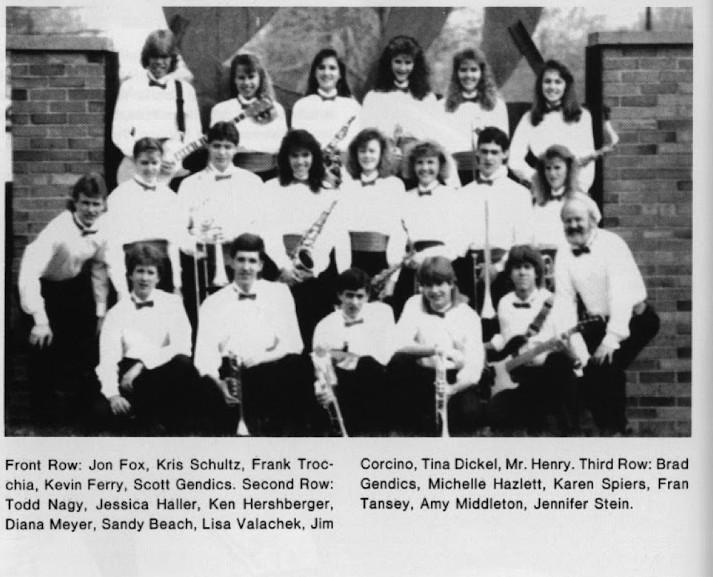
The first recorded date for the combined Soundsation and Vermilion Sailor Jazz Band concert at German’s Villa occurred for the class the 1989. This annual event was a fundraising opportunity for the Vermilion High School music programs. The concert would provide dinner and entertainment to the community.
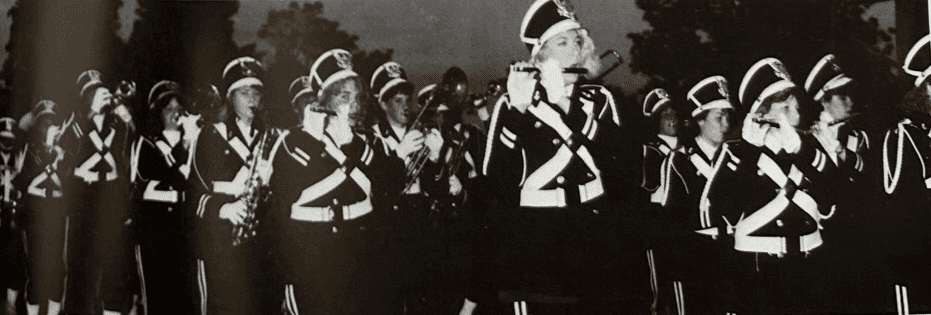
For the 1990 school year, a special patriotic was on display on October 27, 1989, at the Vermilion vs. Sandusky football game. The stadium was lined with students from Vermilion and Sandusky holding 140 flags. The Blue Streaks Marching Band, The Sailorway Seahawk Marching Band, and the Vermilion Sailor Marching Band lined up in the center of the field. The Vermilion High School Chorale walked out onto the field and joined the group of three bands. The combined group performed America The Beautiful and the Star Spangled banner with additional narration from vice-principal Hobart Johnson.
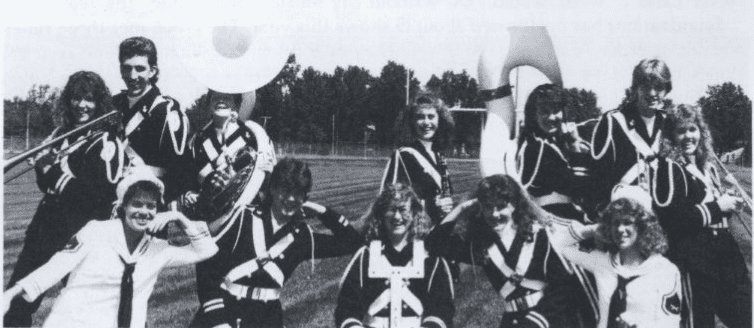
In 1991 the band added a fundraiser, the Band Booster Discount Card. The discount card was available for purchase from band members and cost $5.00. The card was a wallet card that could be taken everywhere. It offered discounts at Vermilion restaurants and businesses. It was advertised to pay for itself after two uses and could be used an unlimited amount of times for a year. At the end of the year, a new card could be purchased for the following year’s fundraiser. This became an ongoing fundraiser.
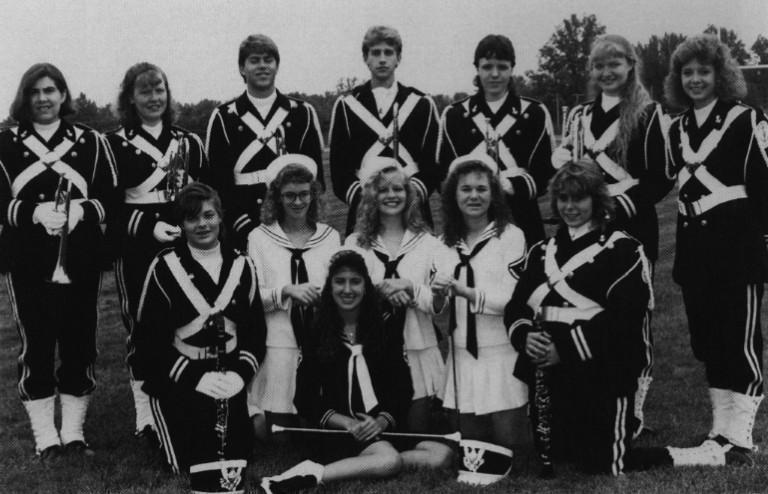
The 1992 school year marked a distinct chapter in the band’s history as Mr. Burt assumed the role of Assistant Band Director. Having spent the previous four years leading the Alumni Band, this was a change of pace. Although it would be his final engagement with high school students, spanning just a single season, it held significance. His return served as an exemplary gesture to future alumni band members, showcasing how to “do it one more time.”
For students who participated in either the 1991 and 1992 or the 1992 and 1993 school years, their experience holds a unique distinction. Much like their counterparts who marched during the 1979 and 1980 school years, they share a rare bond of having marched under all three directors who formed a seamless, overlapping continuation of the Sailor Marching Band’s legacy. Remarkably, these three directors also hold the distinction of being the first three directors of the Alumni Band, an additional layer of connection for some alumni members. These individuals not only marched under all three directors during their high school years but also continued the tradition in the Alumni Band.
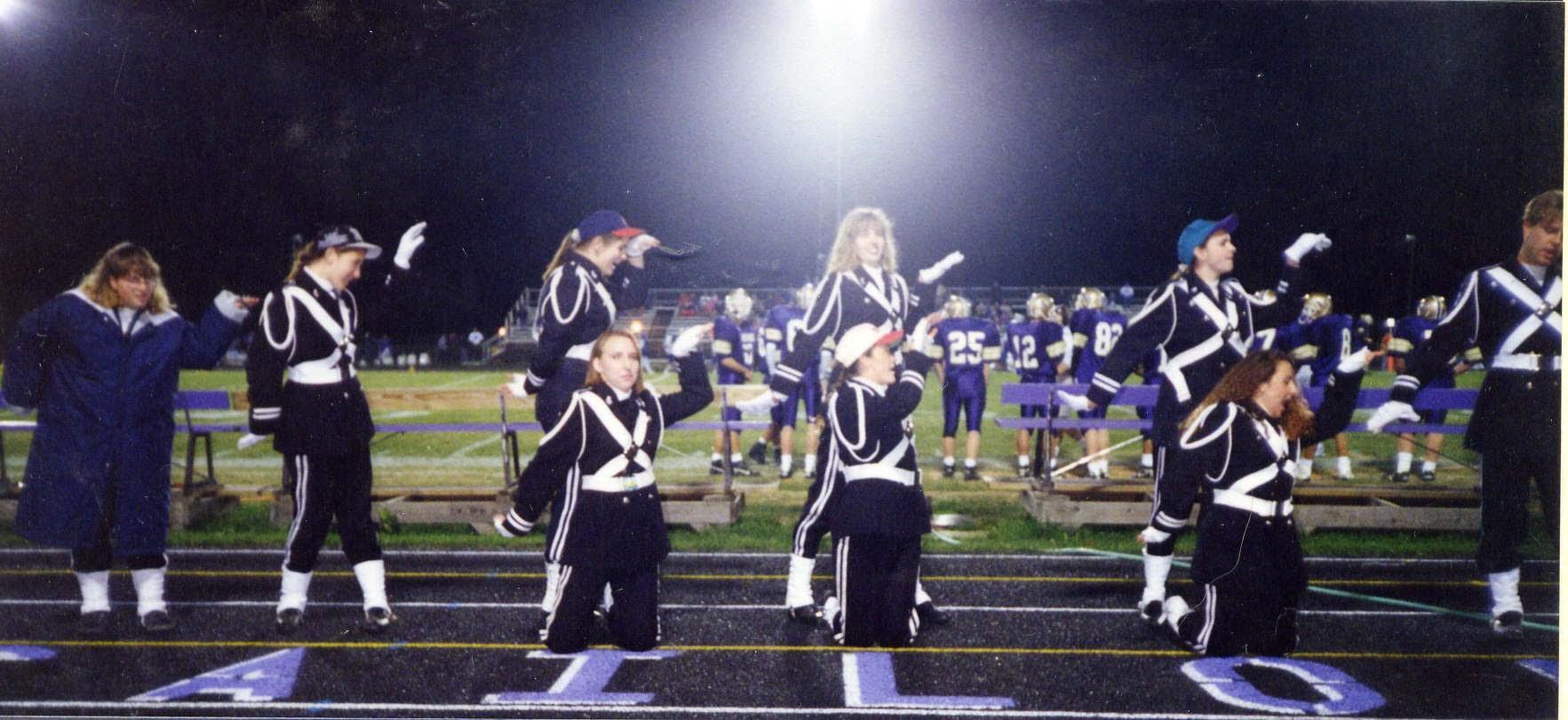
The Senior cheer is an annual cheer given by Seniors before the whole band and then in front of the student section in the stadium at football games. It involves the seniors lining up in one, two, or more rows trying to shoot for an optimum amount of six seniors per row. The seniors do a clap rhythm and spell out the word “SENIORS. So it goes – claps – S – claps – E – claps – N – claps – I – claps – O – claps – R – claps S – S – E – N – I – O – R – S – SENIORS!. While individual letters are yelled out between claps, all members in the group adjust their body to spell out the letter they are yelling. When they get to section after the clap break, each senior in the group of six spells out the word with their body consecutively. So in a row they bodies spell out SENIORS.
Eventually, the junior class would do their variation of the senior cheer, spelling out junior. Discussions with alumni members have brought up some other memorable band cheers from their own eras:
Shake Your Booty
Caller: Hey Sailors…
Band: Hey what?
Caller: Show me how you get down…
Band: No way!
Caller: Show me how you get down…
Band: Okay!
Caller: Jump shake your booty
Band: Jump, jump shake your booty
Give Me A B
it’s “give me a b” over and over as many times as the caller wants and then what’s that spell: the making of babbling bbbbbbb sound – it’s silliness as if one was going to spell band but nope
Yes, Yes, Yes We Do
Starting Band: Yes, yes, yes we do – we’ve got spirit how bout you
Replying Band: We’ve got spirit, yes we do – we’ve got spirit how bout you
Starting Band: We’ve got spirit yes we do – we’ve got spirit how bout you
Replying Band: We’ve got spirit, yes we do – we’ve got spirit how bout you
Everyone: We’ve got more, We’ve got more, We’ve got more, We’ve got more
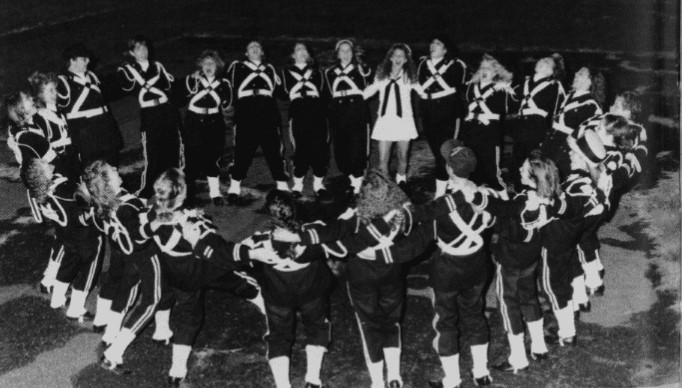
Frankenstein
Caller: Let me see you do the polka
Group: What did you say
Caller: Let me see you do the polka
Group: What did you say
Group Action – Everyone run around poke each other with their fingers and reform the circle
Caller: Let me shoot the moon
Group: What did you say
Caller: Let me shoot the moon
Group: What did you say
Group Action – Everyone runs around and shoots finger guns at the moon and reforms the circle
Caller: Let me see you show your nuts
Group: What did you say
Caller: Let me see you show your nuts
Group: What did you say
Group Action – Everyone runs around screaming and waving their arms and then reforms the circle
Caller: Let me see you do the Frankenstein
Group: What did you say
Caller: Let me see you do the Frankenstein
Group: What did you say
Group Action – Everyone walks around in a classic Frankenstein legs straight and arms outstretched
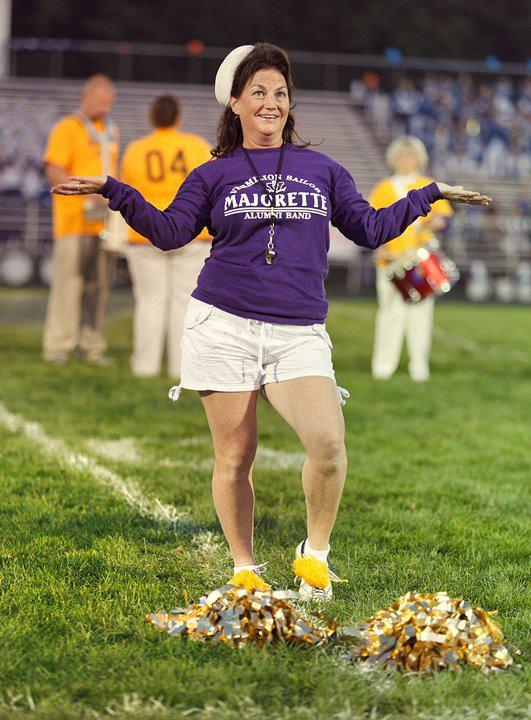
Dawn Clark, class of 1981 and daughter to Mr. Henry, was brought in for the 1992 school year as majorette advisor for the band. Originally Dawn performed this role as a favor to her father, but she continued in this for two decades after he retired. By the time Dawn retired from the position at the end of the 2014 school year, she became the longest-serving Vermilion Sailor Marching Band staff member who was not a director. Dawn also fulfills the role of head majorette for the Vermilion Sailor Alumni Band designing routines yearly for the alumni majorettes.
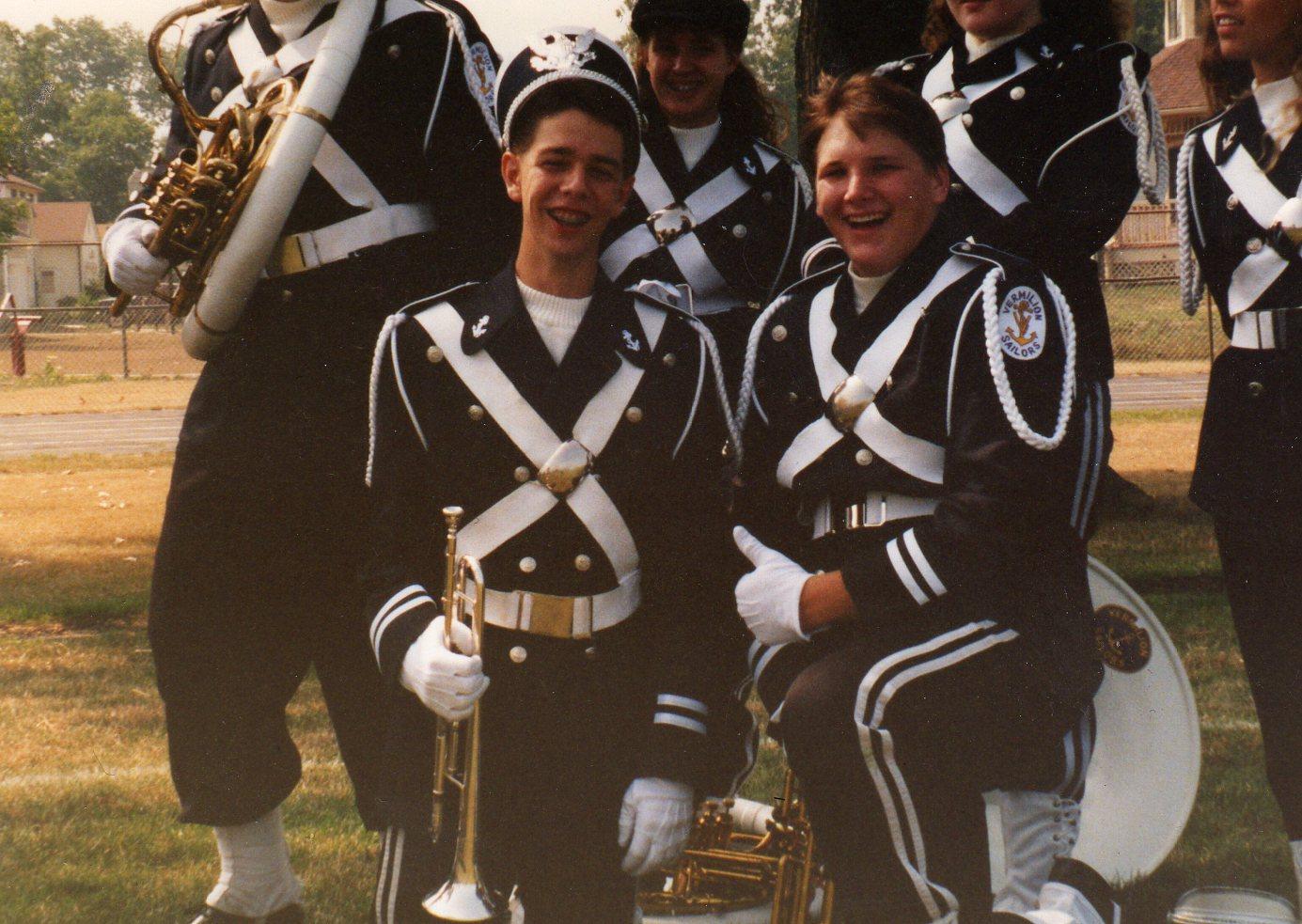
The first posters for band officer elections appeared for officers in the 1994 school year. While normally officers run and attract votes from band members individually, Pete Glowacki and Brent Gueth took a different approach and tried an election with both of them running together. A campaign poster was made with Brent’s younger sisters stating they were future marchers, and they would vote Pete for president and Brent for secretary. The poster was hung up in the band room as elections approached. Unfortunately, neither candidate won the election. Future candidates for band officers would also make their own posters on random years and hang them in the band room.
Due to the nature of being of the band’s appearances at public events, it was accustomed to being on TV. The class of 1993 happens to be the first one featured in a commercial. In the lead-up to the Cleveland Christmas Parade, Channel 8 filmed various area marching bands for tv spots advertising the parade. Marching band students brought in their uniforms to school that day and filmed it during concert band practice in the choir room. Amy Wooten was selected the one to deliver the line “Hi. We’re the Sailor Marching Band and we’re going to be in the TV8/American Legion Christmas Parade. Come and see us November 28” while the band played Angel’s We Have Heard On High.
In 1993, the City of Vermilion established a sister city relationship with Paimpol, France. This pairing was based on shared characteristics, such as both being influenced by tourism from boating, having similar population sizes, and historical ties as fishing communities. The formalization of their sister city status took place on September 28, 1993, during a ceremony held in front of the Great Lake History Museum near Main Street Beach in Vermilion. This event included the signing of the sister city agreement, and The Vermilion Sailor Marching Band was on hand witnessing the agreement and providing music for the celebration.
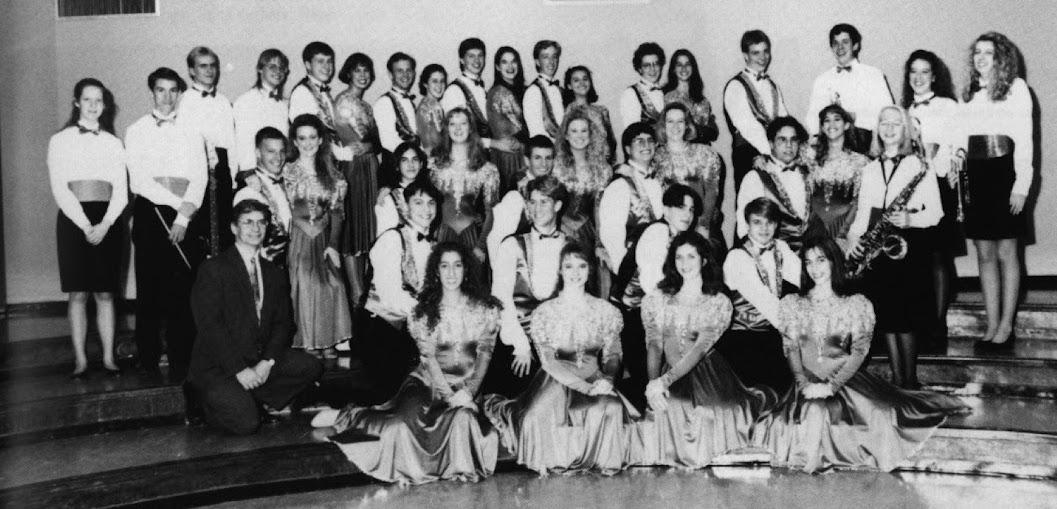
Something new arrived for the Soundsations choral group in Vermilion in the 1994 school year, live music instead of pre-recorded backing tracks. Dr. Ted Williams, the Vermilion choral director, opened up auditions for musicians to perform with Soundsations. The general makeup of instrumentation was similar to the Vermilion Jazz band. Many musicians performed in both groups. Soundsations focused on popular songs, for instrumentalists this was closer to the Stage Band that was run under Mr. Burt.
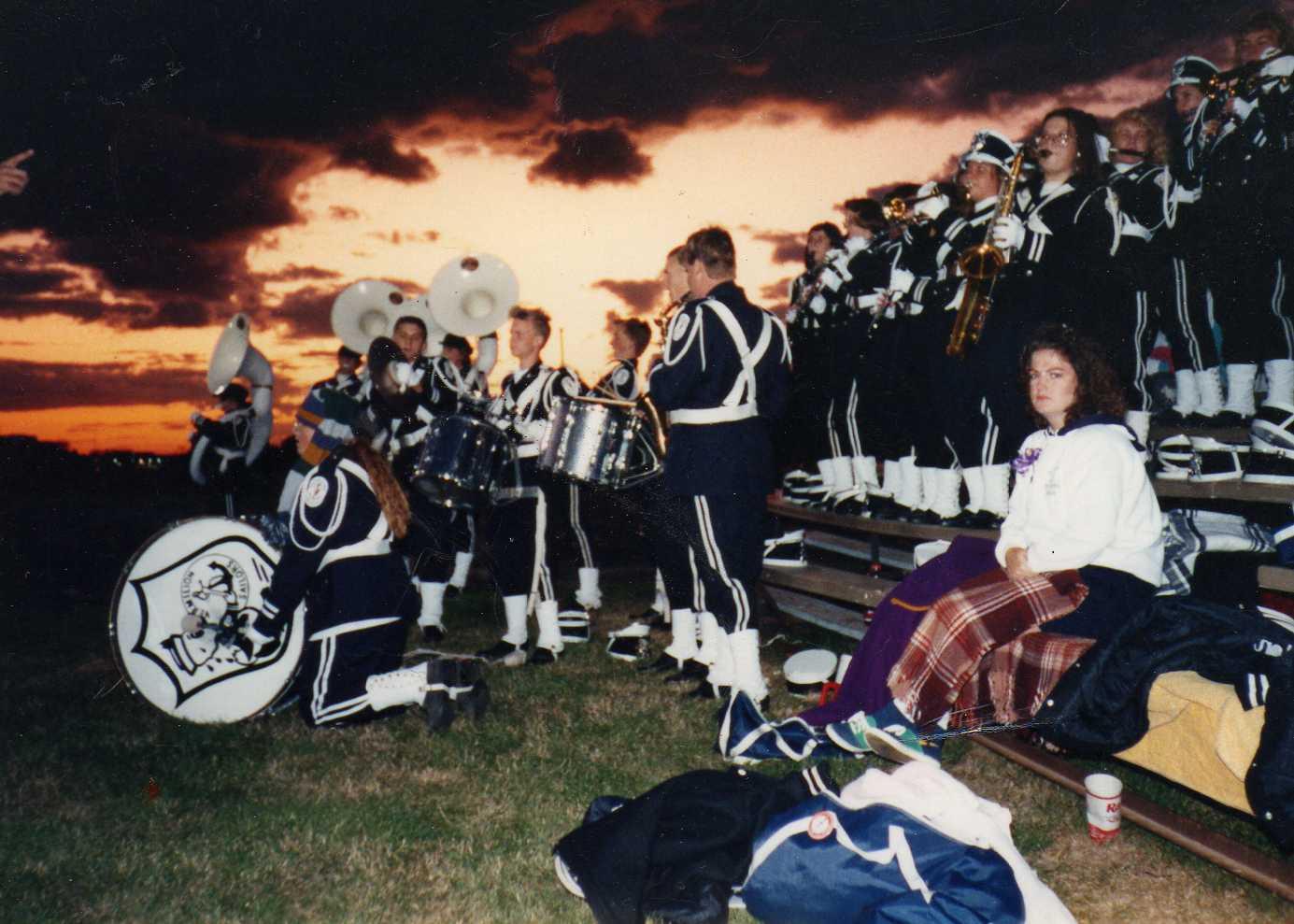
In the winter of 1993, Mr Henry created another musical group in the Vermilion instrumental performance family, the Winter Brass. This group of seven to eight members focused a performance on Christmas music and performed at various locations in town including the South Shore Shopping Center and downtown.
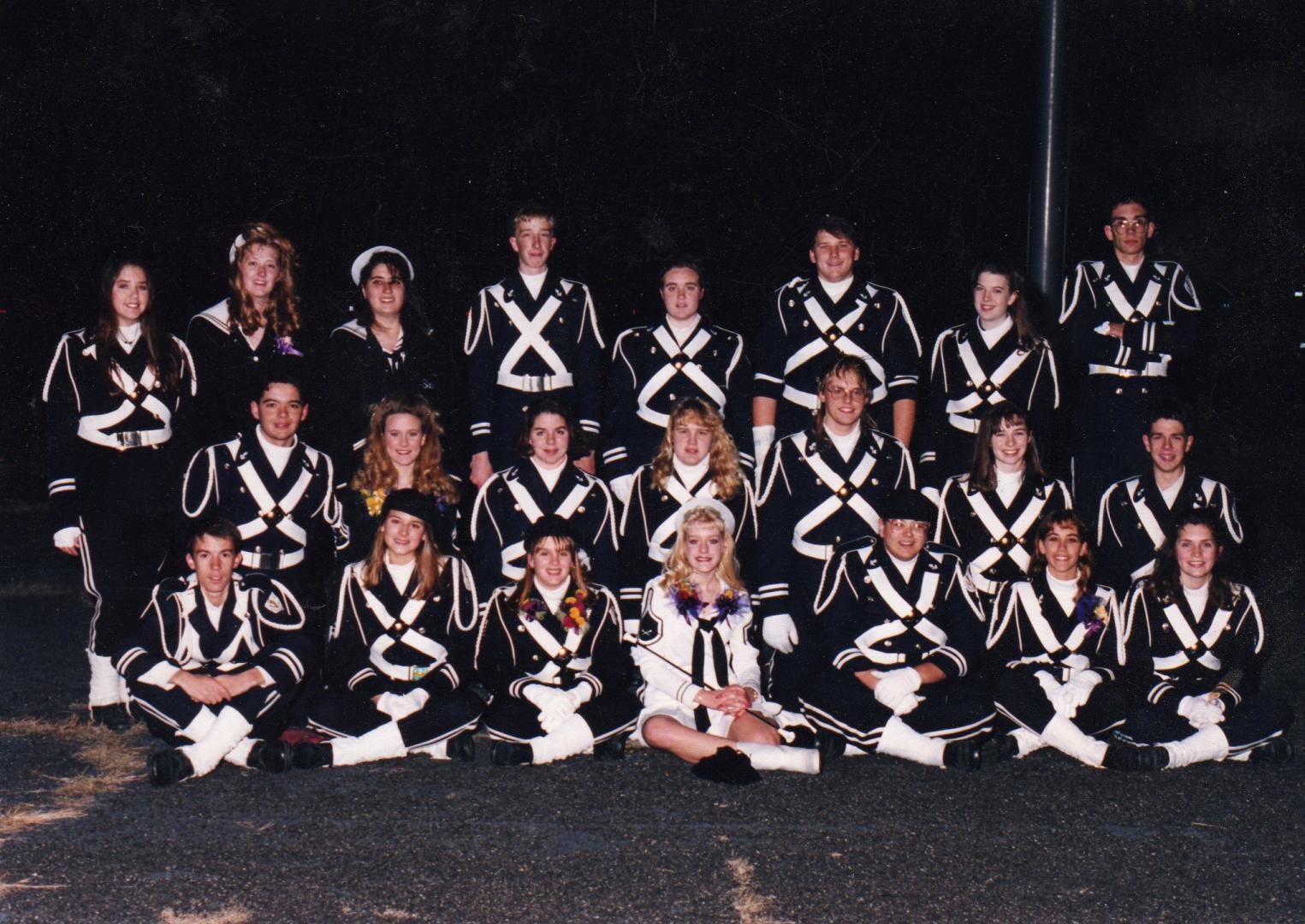
At the end of 1994 it was time for Mr. Henry to pass the torch to the next generation of the Vermilion Sailor Marching Band. The previous fall, the senior class closed their show to MacArthur Park. This was quite fitting since it was a show written during his tenure under Mr. Burt. Together they had made the routine a staple and the seniors were all in to make sure it was on the field one last time. His legacy to the music program includes the annual Vermilion Musicals, Vermilion Sailor Jazz Band, Vermilion Brass Group, Eighth Grade Night, The Cleveland Christmas Parade, the transformation of the music booster program, and his students who high-stepped and bowed in their final home show.
The Feature Down In Front
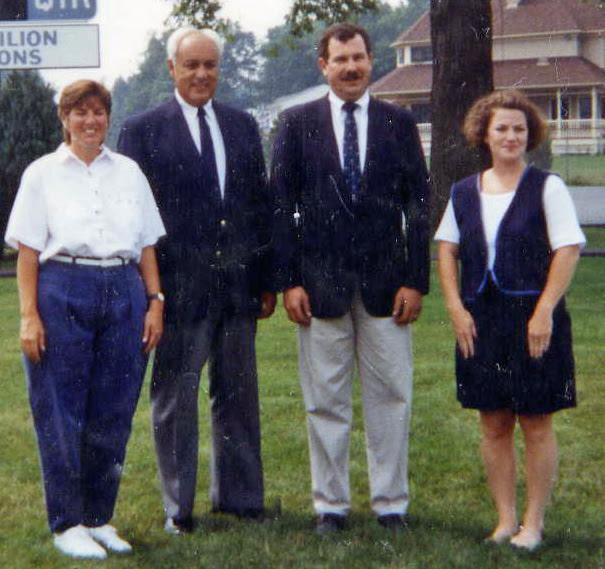
In the fall of 1994, Mr. Price took the reins of the Vermilion Sailor Marching Band and few changes were in store. While most of the Vermilion Style would remain, uniforms would change, flags would fly, and the roles of some instrumentalists would expand. Greg Trocchia was hired as Assistant Marching Band Director. Lisa Fiedler, who had been teaching color guard at Sailorway for years was brought over to server as Advisor for the return of the Color Guard to the Vermilion Sailor Marching Band. Dawn Clark continued to be the Marjorette Advisor. Pat Price was brought over to be the announcer for band performances.
While the formula for a Vermilion Sailor Marching Band show structure stayed the same, Mr. Price enjoyed creating themed shows where the songs would complement each other thematically from beginning to end. Some examples of these theme shows include a show dedicated to sailing, a tribute to the Centennial Olympics, and a Beatles show. This theming would continue throughout is tenure as the Marching Band director in various show.
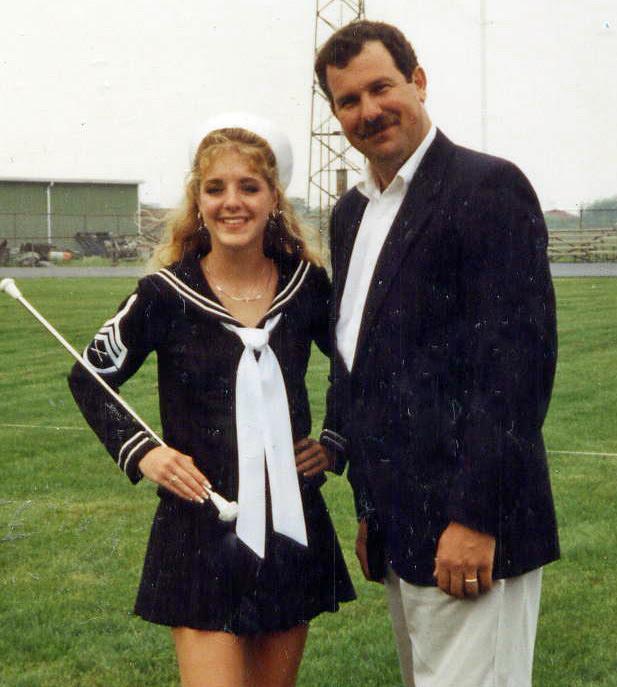
To be Continued
High Step

Coming soon
Victory March
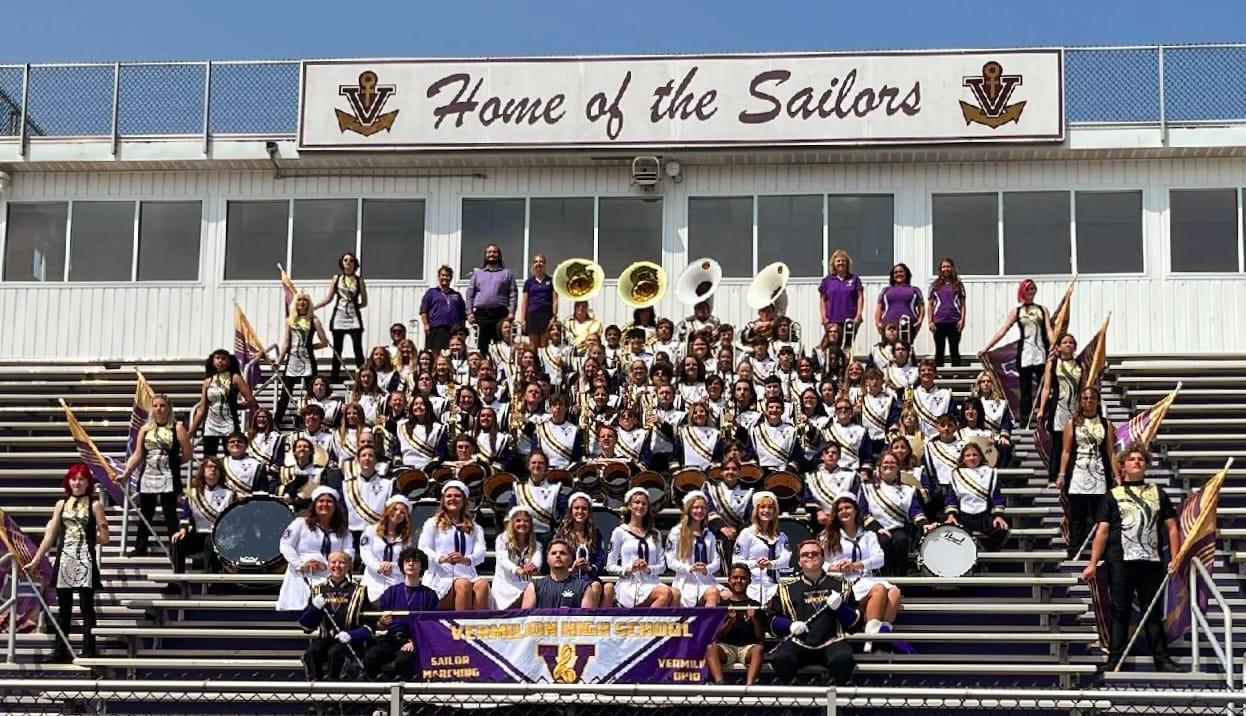
In 2005, the Vermilion High School Hall of Fame was established with a clear purpose: to honor accomplished alumni who have achieved extraordinary success in their respective fields and to acknowledge individuals who have made outstanding contributions to the Vermilion Local Schools. Inductees into the Hall of Fame forever stand as representatives of the very best among us, their achievements serving as a testament to the excellent opportunities provided by the Vermilion Local Schools, including academics, arts, athletics, and other enriching programs.
This esteemed Hall of Fame stands as a cherished tribute, celebrating those who have left a profound and lasting impact on our school community and extending their influence far beyond our school’s boundaries. Through their remarkable accomplishments and contributions, these inductees inspire and motivate current and future generations of students, encouraging them to strive for greatness and make a positive difference in the world.
Vermilion Marching Band Members Inducted Into the Vermilion High School Hall of Fame:
2011 Inductees
William Burt, Director
2018 Inductees
Deborah Zerad Fallows, Class of 1967
David J. Henry, Director
Off The Field
The music program in Vermilion has proven to be a breeding ground for lifelong musicians and dedicated band directors. It continues to ignite a passion for music in young students, guiding them on their musical journeys. Despite being a small town, the Vermilion school bands have seen thousands of students march and play in their ranks. As change is a natural part of life, not all past iterations of the band readily embrace it, but one thing remains constant: the sense of belonging to a family, a legacy.
This legacy lives on through the current and future band directors of Vermilion, who carry the torch of tradition and spirit. While some traditions may evolve or fade over time with inevitable changes, the band today may look different from the basic maneuvers of Mr. Hoffman’s era, but it bears the same proud lineage of the Vermilion Sailor Marching Band. Each band member receives their roots from those who came before, while new roots are planted every year, ensuring the enduring continuity of this cherished legacy for generations to come.
Editor notes:

When I initially delved into this piece of writing, I believed I had a good grasp of most of its components. I felt confident that I had gathered sufficient information from yearbooks, articles, and various sources over the span of a decade, providing a comprehensive understanding of the band’s history. I had a wealth of yearbooks and an extensive collection of photographs at my disposal, not to mention hours of video footage spanning from the 1980s to the present day. However, what I had not thoroughly explored were the newspaper articles, and this turned out to be a significant oversight.
As I combed through the newspaper archives, I came across several pieces of information that challenged long-held beliefs and contradicted certain facts that had been repeated for decades. It became apparent that some memories were flawed, and there were instances of individuals mistakenly taking credit for certain achievements. Perhaps some people only knew half of the story, or they had been misinformed. Regardless, it is crucial for the accuracy and integrity of the above writing that I make adjustments and updates based on these newfound facts.
I am committed to ensuring the accuracy of the band’s history, and I welcome any new information or corrections that may arise from further research. The goal is to present a comprehensive and truthful account of the Vermilion Marching Band’s journey and the contributions of its members throughout the years.


